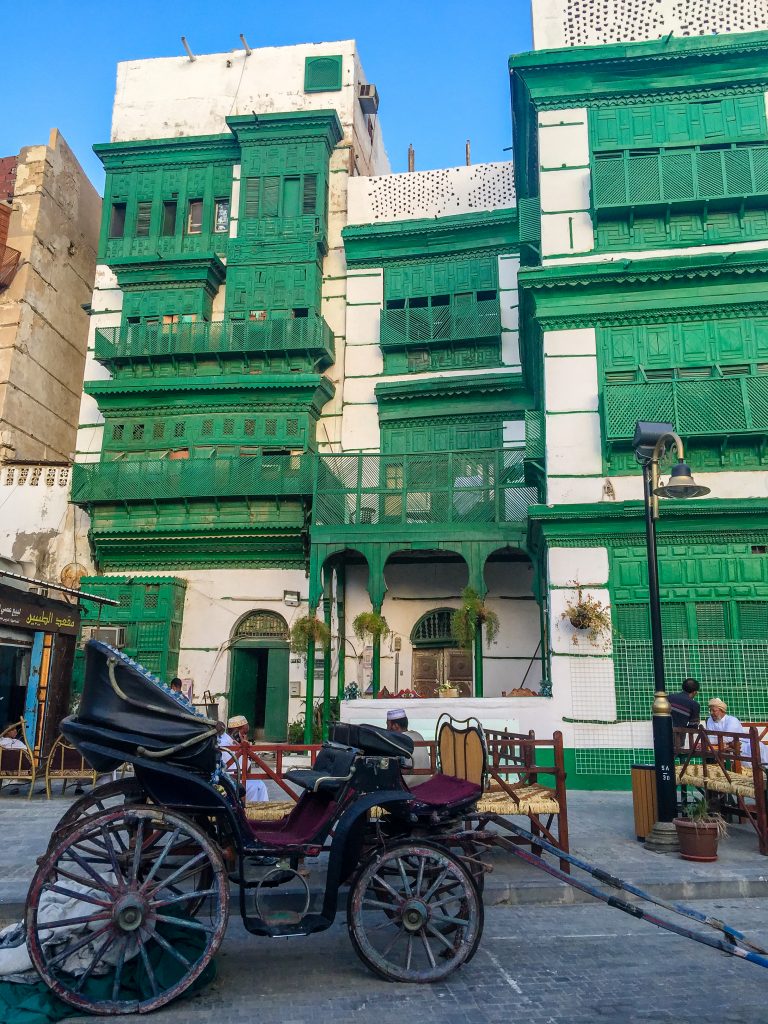
Paige Peterson is the Executive Vice President of the Huntsman Cancer Foundation and a board member of the National Council on U.S.-Arab Relations in Washington, D.C.
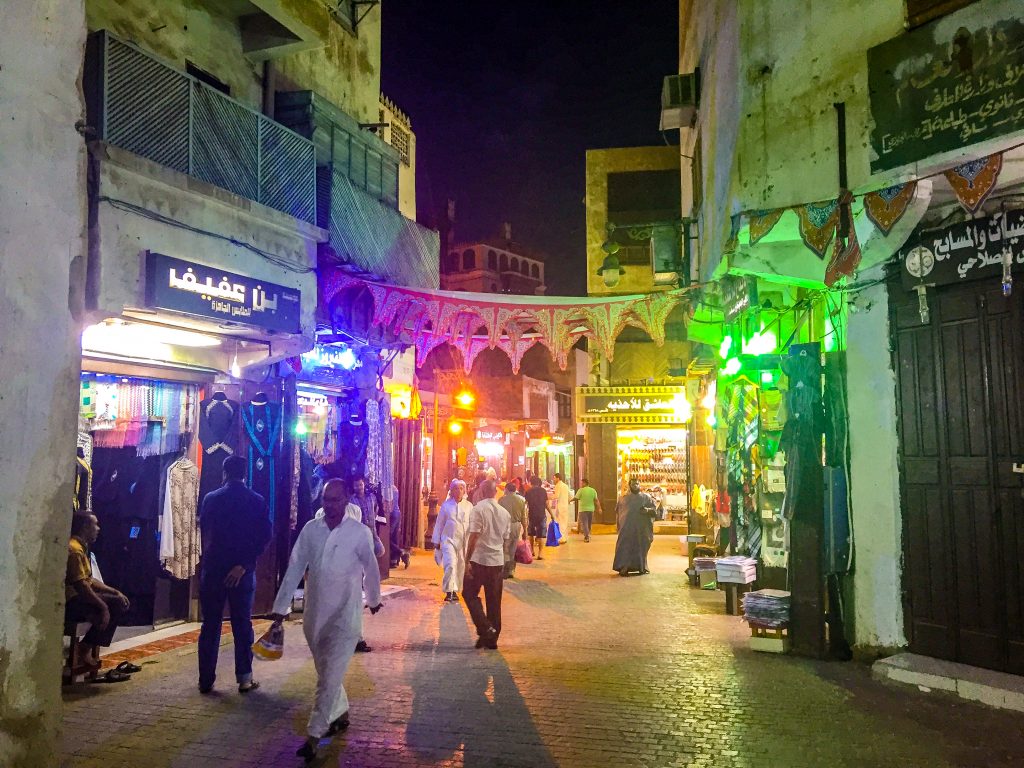
This photo essay illustrates her visit to Jeddah’s Old City, on the Red Sea, in Saudi Arabia.
![]()
Health conferences are held everywhere but there is a special pleasure in attending one in Jeddah. Having visited the Kingdom of Saudi Arabia many times for the Huntsman Cancer Foundation, I have experienced the genuine warmth of Arab hospitality. To have the opportunity to visit friends there and attend the Saudi American Health Care Forum in Jeddah was a double pleasure.
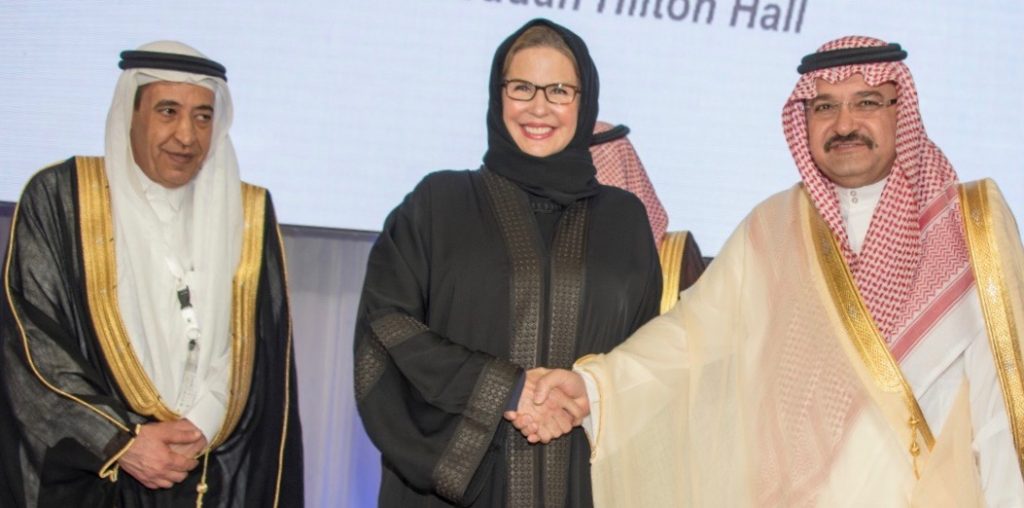
Accepting an award on behalf of the Huntsman Cancer Foundation from Adel A. Shakoor and HRH Prince Mish’al bin Majed bin Abdulaziz Al Saud, Governor of Jeddah.
While in Jeddah, I was invited to stay in the guesthouse of my dear friend Fawzia Algosaibi, wife of Saleh Alturki, a prominent Saudi Arabian businessman who was recently named Mayor of Jeddah. What was planned as a two week trip turned into a stay of almost two months but my hosts were beyond gracious. Their hospitality gave me precious time to tour the western seaboard of Saudi Arabia.
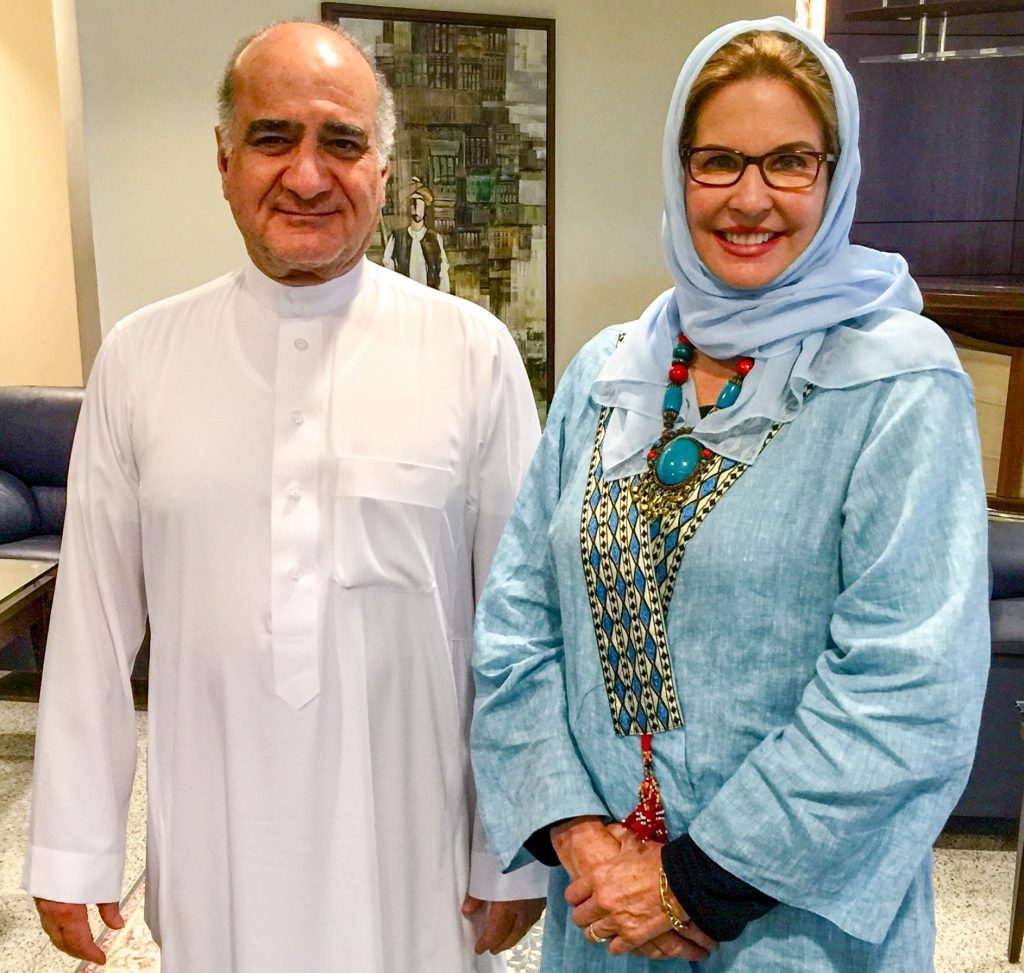
With Saleh Alturki, Mayor of Jeddah.
I spent time exploring and photographing the once walled-in city of Old Jeddah, which was inscribed as a UNESCO World Heritage Site in 2014. It’s a cliché to say that a picture can be worth a thousand words. These pictures were worth more than that for me — this visit was like time travel, transporting me to another century. It’s a privilege to share my story here.
![]()

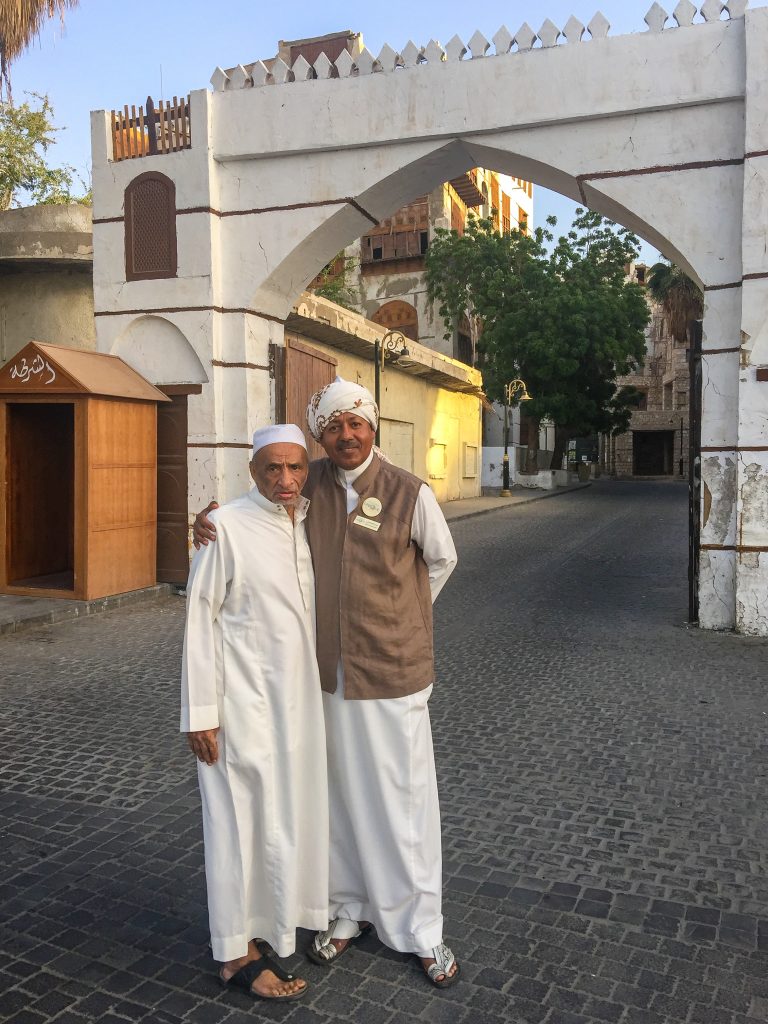
Samir Komosani, on the right, with Mr. Mohdy greeting us in front of the Jeddah Festival Gate. Samir, our guide through Old Jeddah, was the Kingdom’s first licensed tour guide. Minister of Tourism HRH Sultan bin Salman bin Abdulaziz Al Saud recognized Samir as the “Best Tour Guide” in 2016. Samir’s great grandfather, Ahmed Komosani, was the second Mayor of Jeddah 220 years ago. I was in very good hands.
Old Jeddah is known as Al-Balad (translated to “The Town” in Arabic). It is an open air, living museum. Al-Balad is famous for brightly colored window and door covers called Roshan and Rawashin. The traditional houses have balconies with perforated screens that allow air to circulate and cool the homes. This is a distinctive architectural feature.
The perforated screens obscure the exteriors of the buildings. They are intricate and alluring. The shield of latticework allows the inhabitants to sit in shaded privacy while gazing out on the bustling street life. In the past, the balconies were critical for women in need of privacy. Functionally, the screens served and continue to serve as curtains, windows, and air conditioners. The screens’ filtered light subdues the effect of the strong desert sun. It also minimizes the intrusion of undesired elements of the landscape, such as dust and sand.
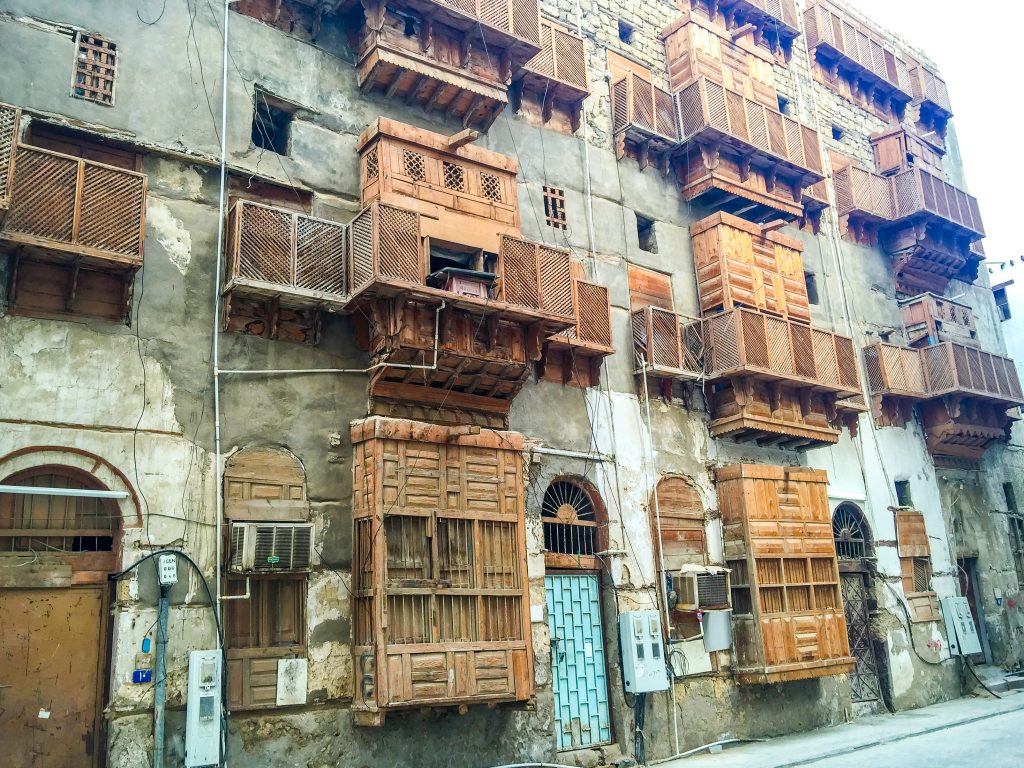
The construction materials used in the houses of Jeddah showcase craftsmen’s ability to harness their surrounding environment, and fuse the influences of traditional Saudi Arabian culture and international sea-faring trade into a cohesive skyline. Four essential raw materials were used in traditional construction in Jeddah:
- Coral stones mined from the reefs that line the Red Sea shore.
- Purified clay taken from the bottom of nearby lakes, which was used as a mortar for marrying the coral stone slabs as well as for waterproofing the floors, roofs, and the external face of the coral walls (This is a technique unique to Jeddah.)
- Teak wood imported from neighboring areas or from abroad (especially from India.)
- Gypsum, found throughout the Arabian Peninsula, which was used extensively throughout the buildings to decorate interior walls.
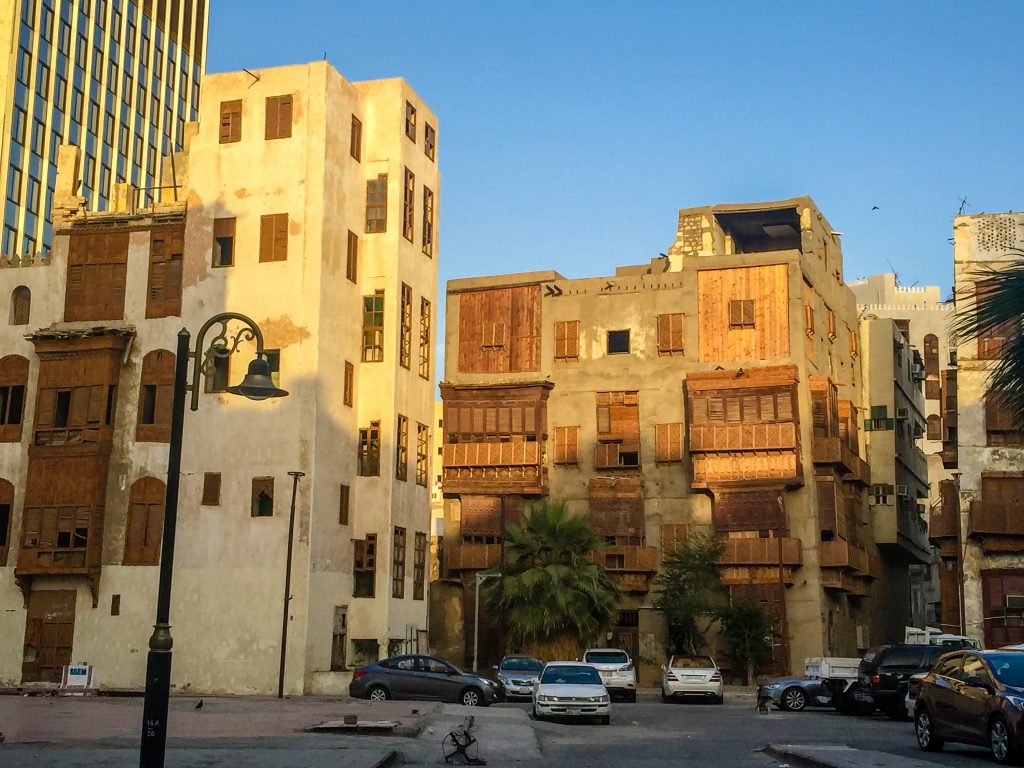
The juxtaposition of these beautiful 170 year-old buildings against modern high-rises, captured on the left, showcases the differences between Old Jeddah and the modern city.
Bougainvillea adds a splash of color as it ascends the lattice balconies.
Batrji House was the first American Embassy in Saudi Arabia in 1928. It is scheduled for reconstruction. The colors are so lovely.
One of the most noticeable architectural features found throughout Old Jeddah are beautifully carved doors. These wood and steel doors are crafted with intricate patterns and adorned with a wide spectrum of colors. Double doors indicated that the owners belonged to the wealthier classes. Single doors suggest a lower socioeconomic status.
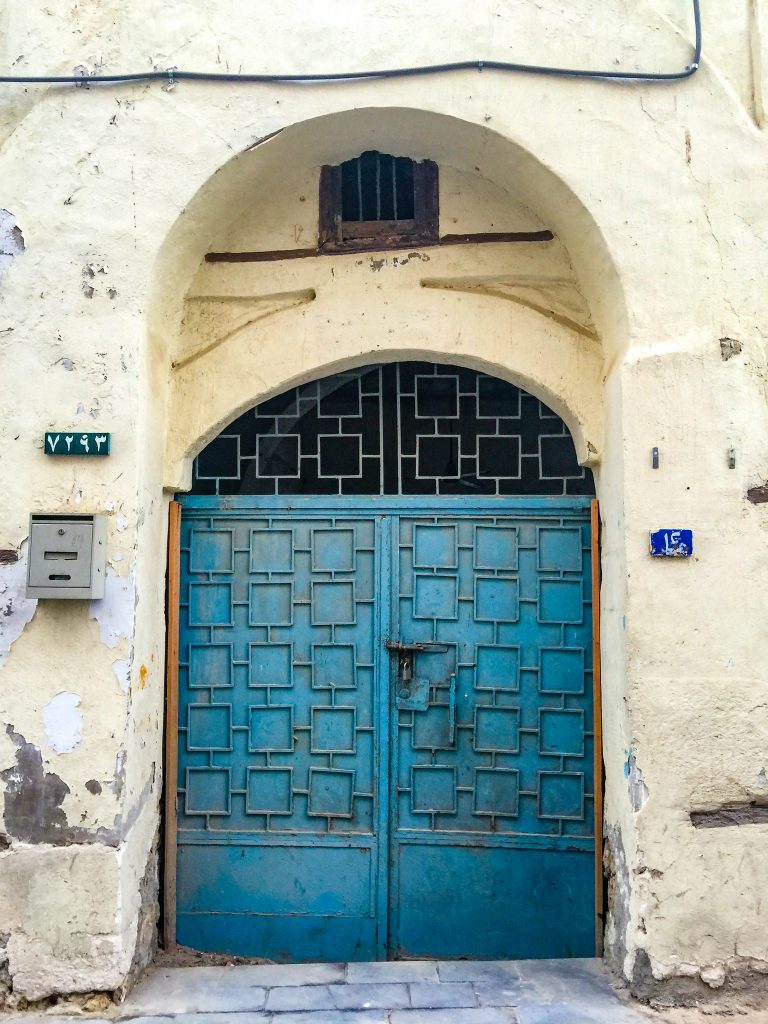
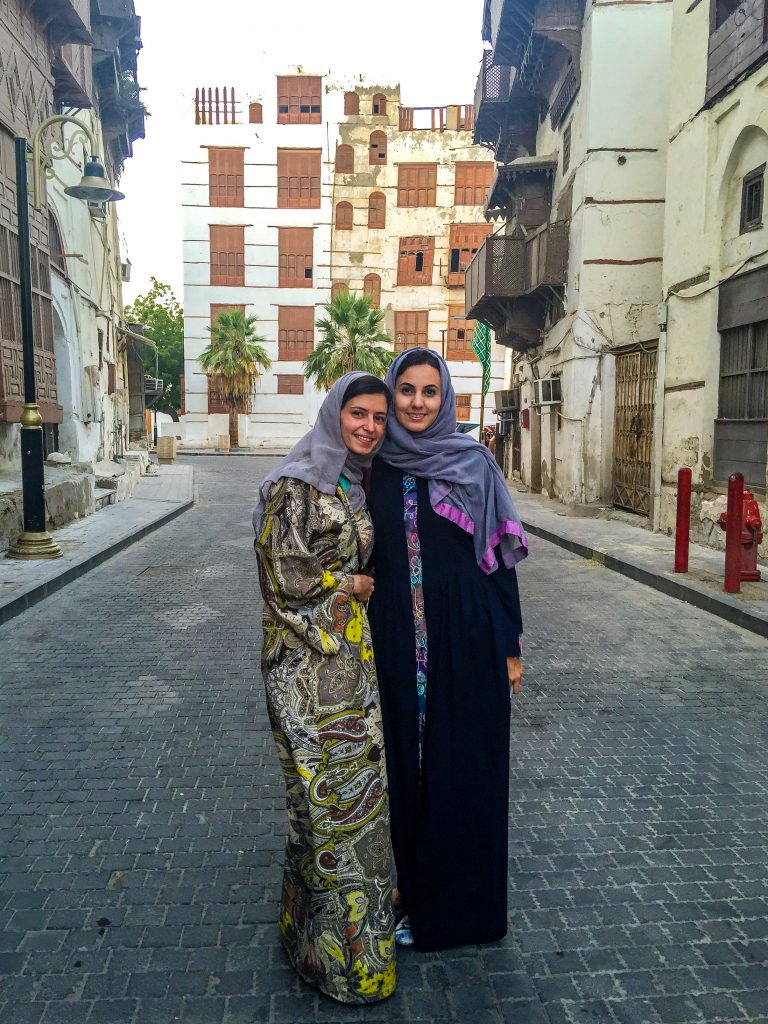
Disputing the stereotype that all Saudi Arabian woman are clad head to toe in black, these two young ladies embrace a paisley pattern in their clothing. All Saudi Arabian women wear abayas when they go out in public but, having been a guest in many Saudi Arabian homes, I can assure you that it comes off when the women get home or into any situation where there are no men. In private, they are clad in everything from exercise apparel to the latest fashions in Paris and New York. I have a friend that once threw an abaya on over her pajamas as she was late to an appointment and had no time to change!
Saudi Arabian designers are offering new interpretations of the abaya, many of which are edgy and wonderfully chic. I personally was happy to discover that while wearing an abaya I never had a bad outfit day and certainly never a bad hair day. A lot of the women’s style and expression while wearing an abaya can be seen in their shoes and, often, matching handbags. Modern, colorful abayas are steadily making fashion statements all over the Kingdom.
Local meeting squares serve as the perfect place for friends to gather and discuss the comings and goings of the city. Here, Mr. Al-Bahloli, in his chair, gathers with his friends in their self-appointed seats before sunset. They will converse and drink tea until sunrise. I later circled back to check up on these friendly gentlemen.
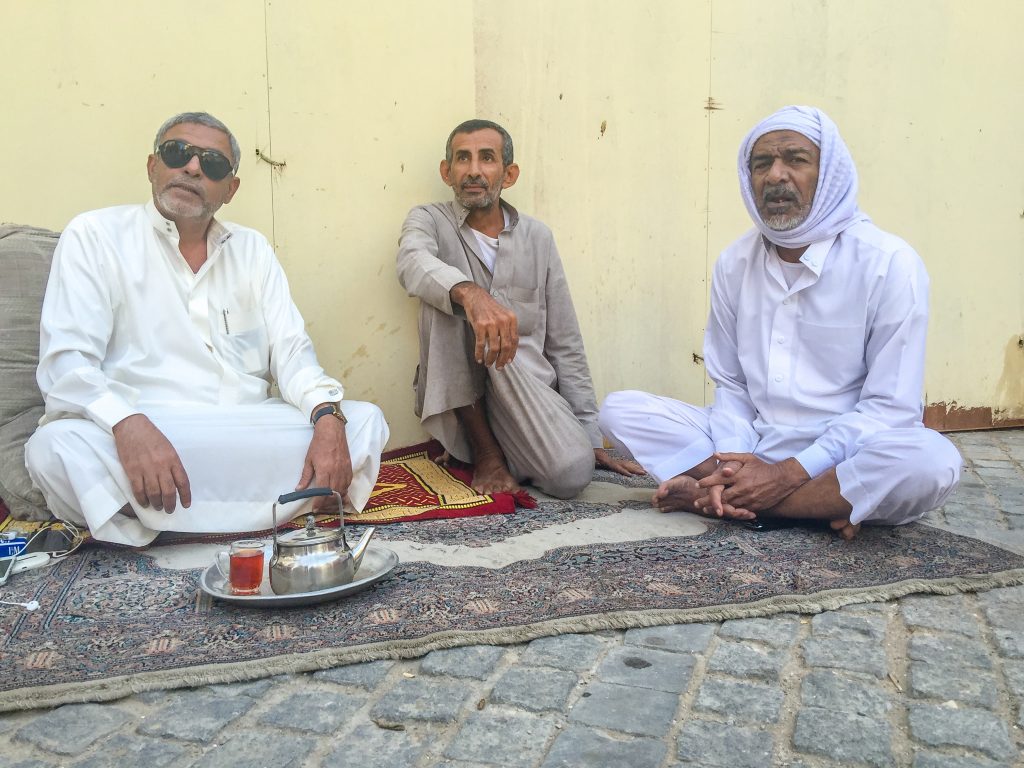
A daily tradition in Old Jeddah is to gather for tea before sunset. Some men bring rugs and tea to an arranged location and settle for the gossip of the day. I never saw any women on the street having tea. They were in their home, or the homes of friends, having tea and sharing their lives with loved ones. Yet, more and more, women are being seen in restaurants and public spaces enjoying themselves.
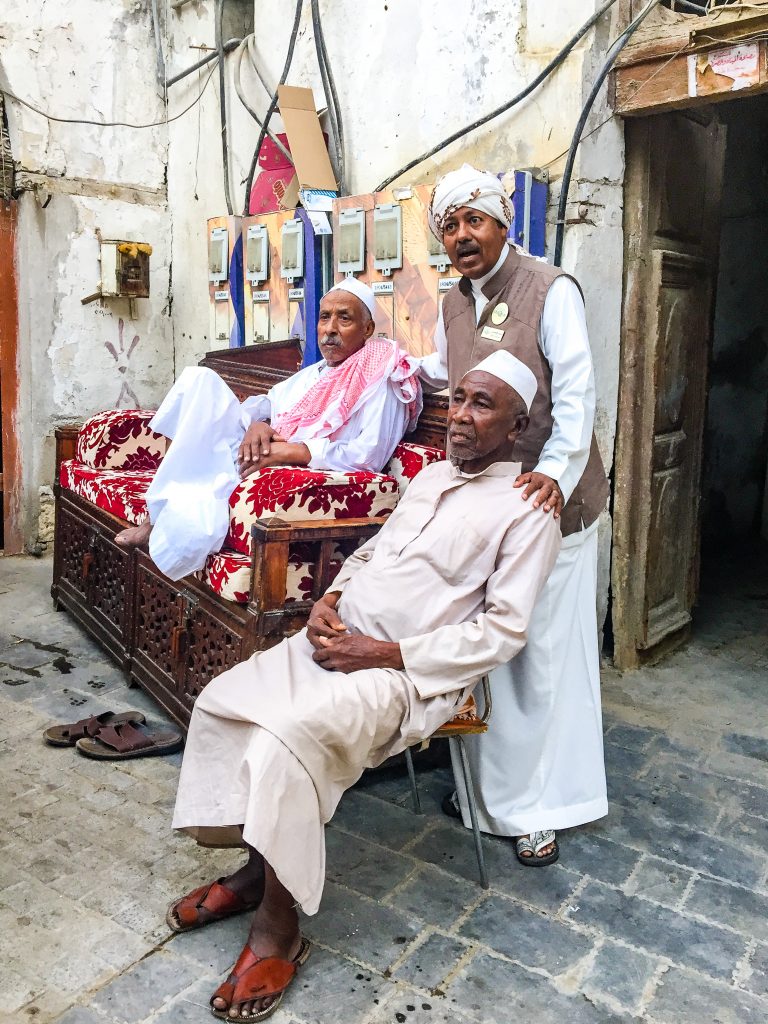
Samir standing with local 100-year-old carpentry legend, Mr. Fakir, who has been operating his shop since he was 15 years old.
Here are the tools of his trade along with other items he had been asked to repair. Before machines were able to guarantee leveling and finish for wooden products, hand planes similar to the ones seen in his shop were used as far back as Pompeian Rome.

Samir and I with a group of students and tourists from Riyadh, the capital of Saudi Arabia and the largest city in the Kingdom.
The history of this little town is deep and wide and from the time of the Stone Age. Jeddah was derived from the Arabic word for “Grandmother” in reference to Eve who, as the myth recounts, was buried in Old Jeddah at a site known as the “Cemetery of Our Mother Eve.” It is also rumored that Alexander the Great visited this seaport between 323 and 356 CE.
A group of children on their way home from school.
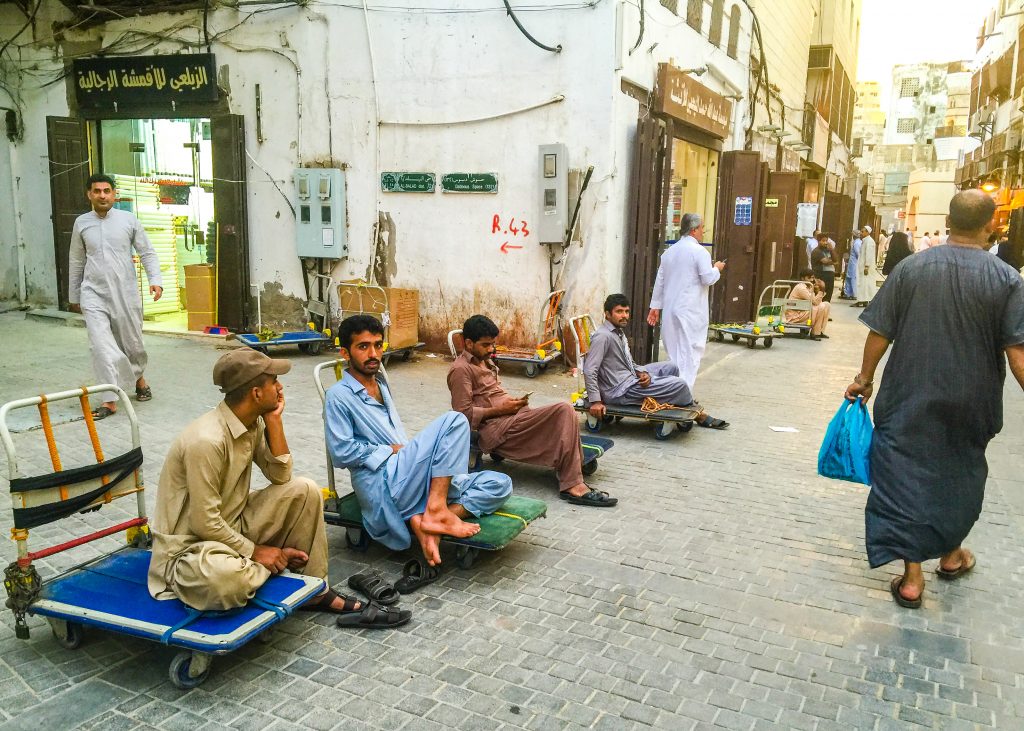
Everywhere in Old Jeddah you see men waiting to be called to make deliveries. All the delivery men, of course, have cell phones and carts.
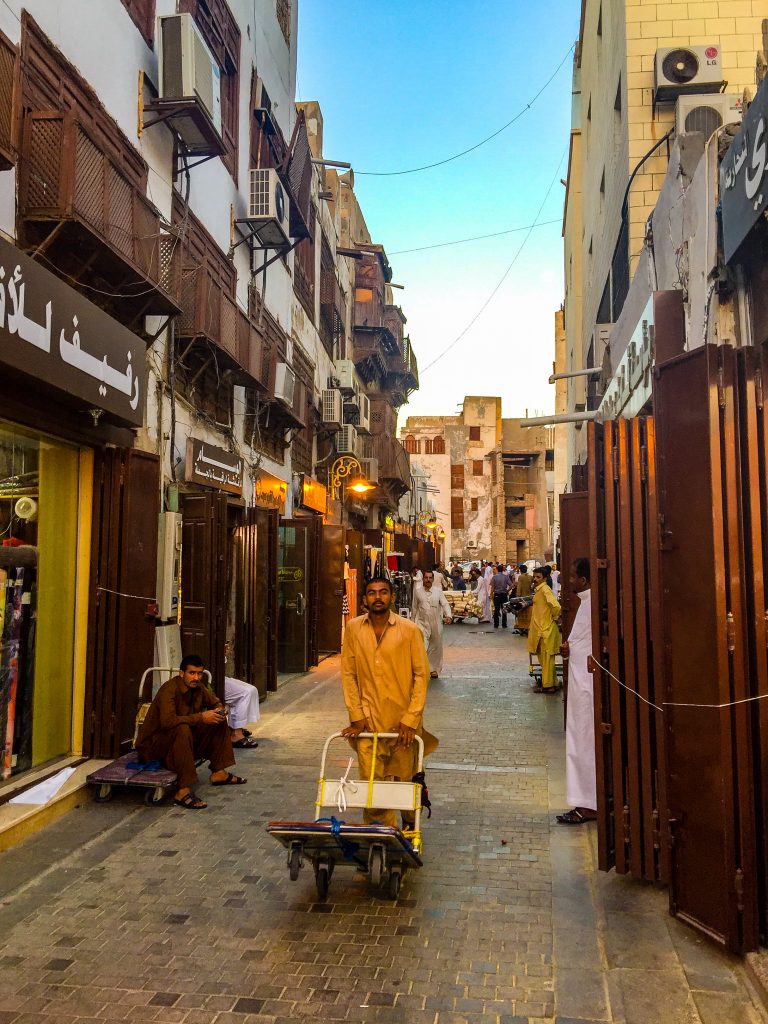
The streets are narrow, which provides shade from the sun. The age-old use of carts is practical. They’re now considered environmentally responsible.
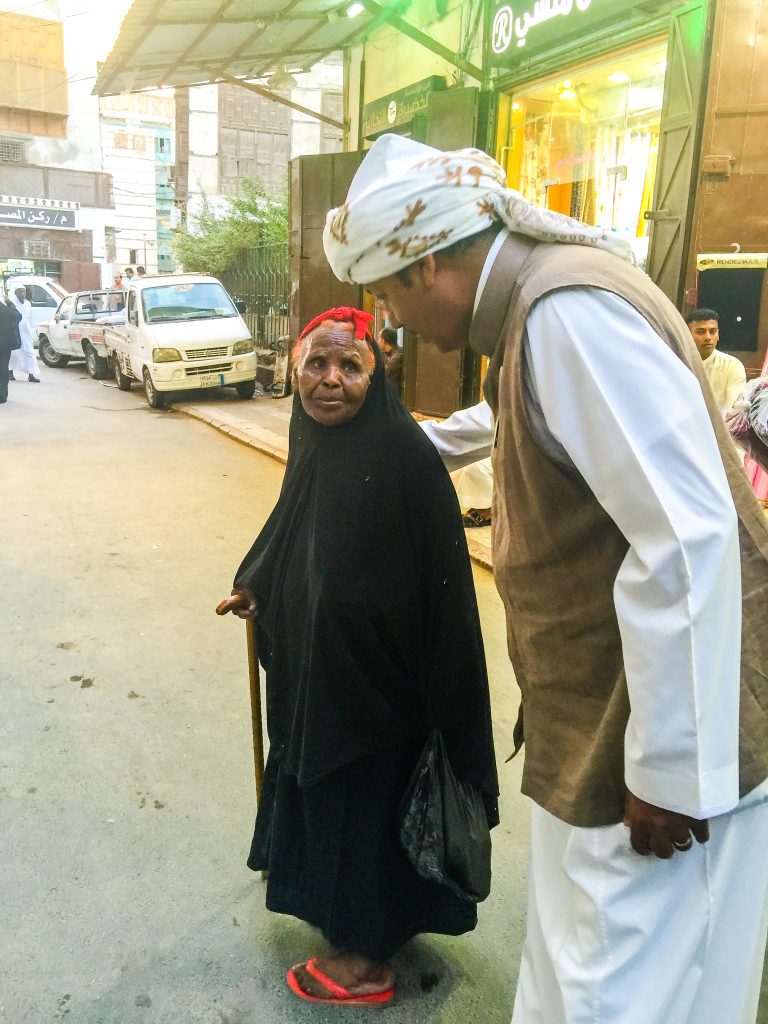
Seniors are traditionally honored, respected, and well cared for by their families and community. Samir was so tender with this adorable woman in her red sandals and matching bow in her hair. She was on her way to a mosque.
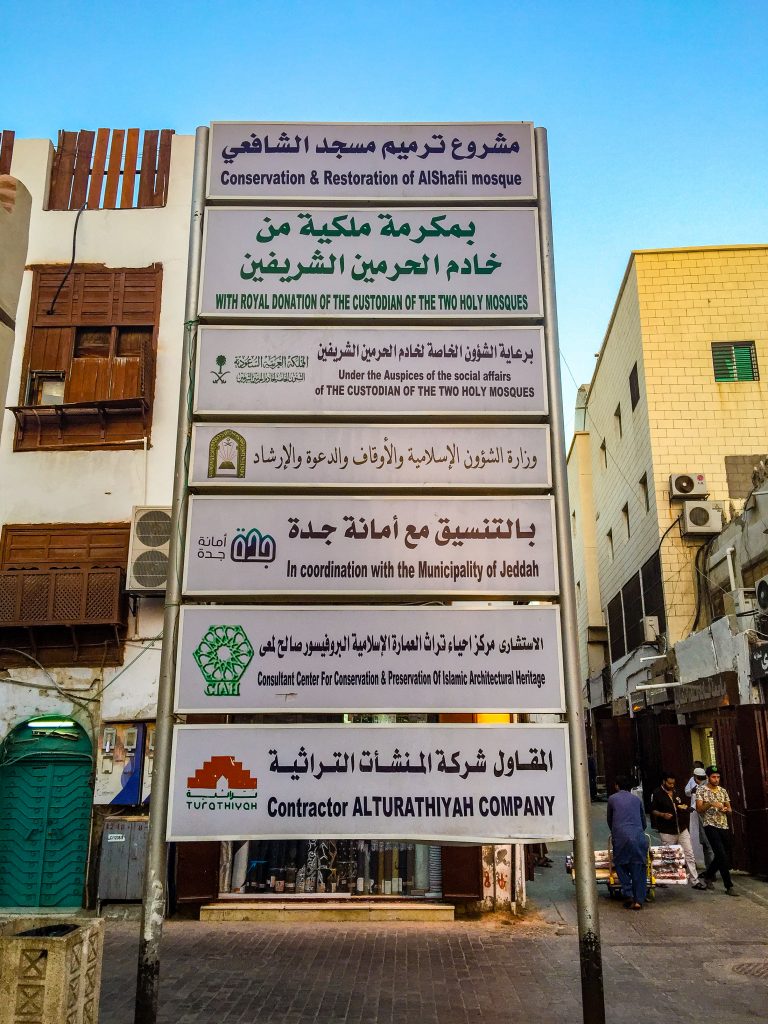
On our way to AlShafi’i mosque. The signs are not only in Arabic but English as well. Very rarely in the Kingdom did I come across a person who did not speak some English.
The call to prayer reminded me of church bells ringing; the purpose of both is to call the faithful to gather together.
For over 1,000 years, Old Jeddah has been a through point for the millions of worshipers on their way to Makkah. The 13th century Al Shafi’i Mosque is reportedly the city’s oldest mosque and contributed to Jeddah’s inscription on the World Heritage List. The newly-remodeled mosque retains its traditional repetitive arches and columns, which are reminiscent of the Cordoba Mosque in Spain.
In the 16th century, the Jeddah wall with forts, towers and cannons was built by Hussain Al Kurdi, the Governor of the city of Jeddah. He wanted to fortify the city from the attacks from the Red Sea by the Portuguese. He also surrounded the city with a deep moat for added fortification.
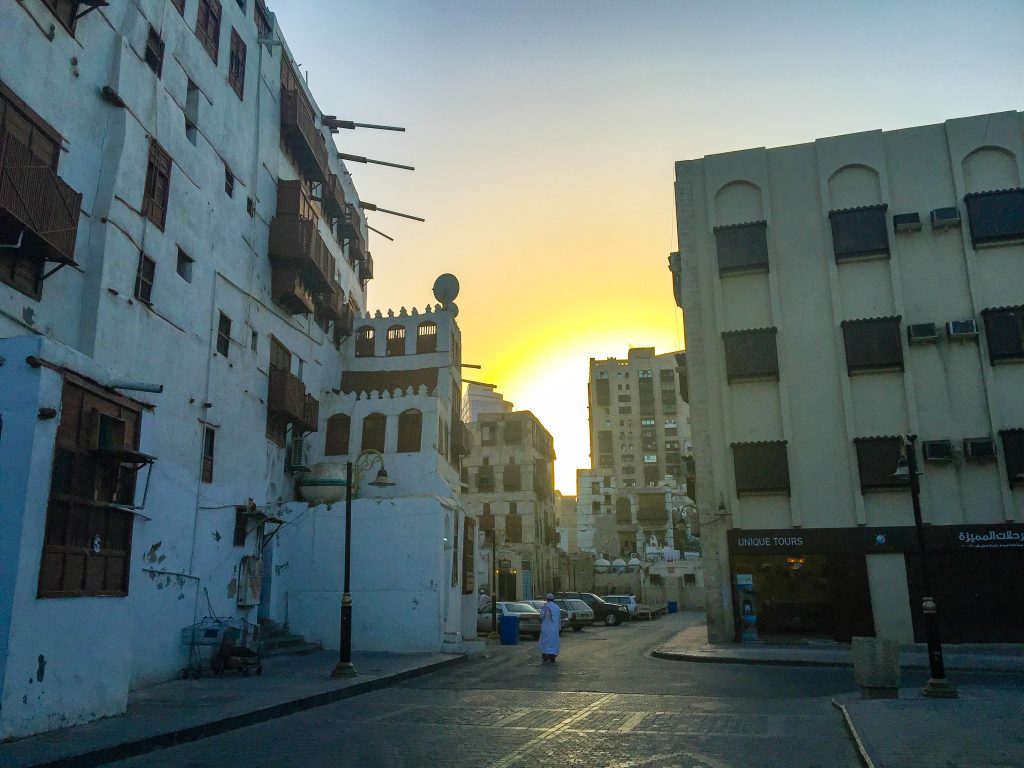
Unfortunately, the city wall was demolished in 1947 to accommodate Jeddah’s growth. The once walled-in old city now simply flows into modern Jeddah seamlessly. It was rumored that the wall was taken down to become building material for a new pier.
Old Jeddah has a rich tradition of harvesting rainwater. Around the 6th century CE, Persians settled in the city. They constructed the first water supply system in the form of wells and cisterns inside and out of the city walls to secure enough continuous fresh water. Historically, the city of Jeddah had no gardens due to a lack of water. During the 18th century, the people of Jeddah, especially merchants, began constructing cisterns under their houses to store rainwater that was collected on the roof and then channeled downwards in pipes.
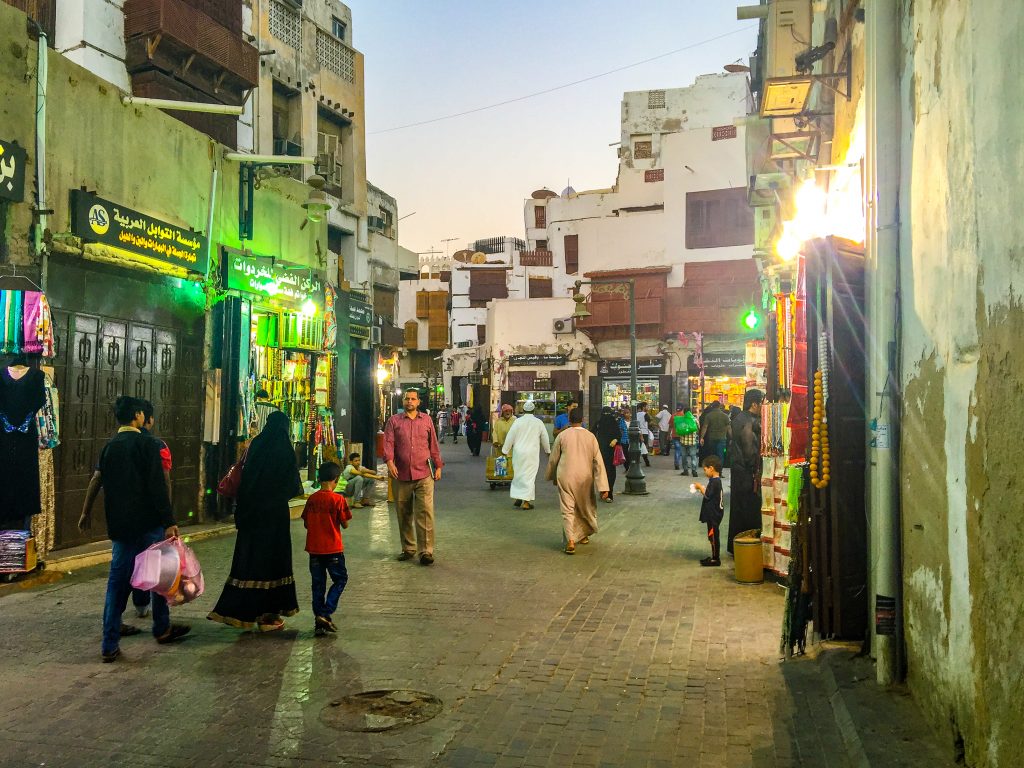
As the sun sets, families begin flowing out onto the city streets.
- The spice trade developed throughout the Middle East 2000 years ago.
The spice trade developed throughout the Middle East over 2000 years ago. The small hill of red spice is called Summak. It is delicious sprinkled over salads. In order to cope with the heady fragrance of the bountiful spices, this shopkeeper wisely wears a mask.
Nasseef House is also known as “The House with the Tree.” The house is where the legendary King Abdulaziz Bin Abdulrahman Al Saud lived in the 1920s when the Kingdom’s Western and Central Provinces were joined pursuant to establishing the foundations of the Third Saudi State. The ceilings are very high to gain the benefits of passive cooling. The staircase was built very wide with short steps so donkeys could easily climb the stairs to deliver food to the kitchen located on the top floor. Years ago, young men would sweep off the roof before rain came and the rainfall would be directed to downspouts taking the water to a huge basement cistern. This house has been entirely refurbished and is open to the public.
I love the different styles of minarets.
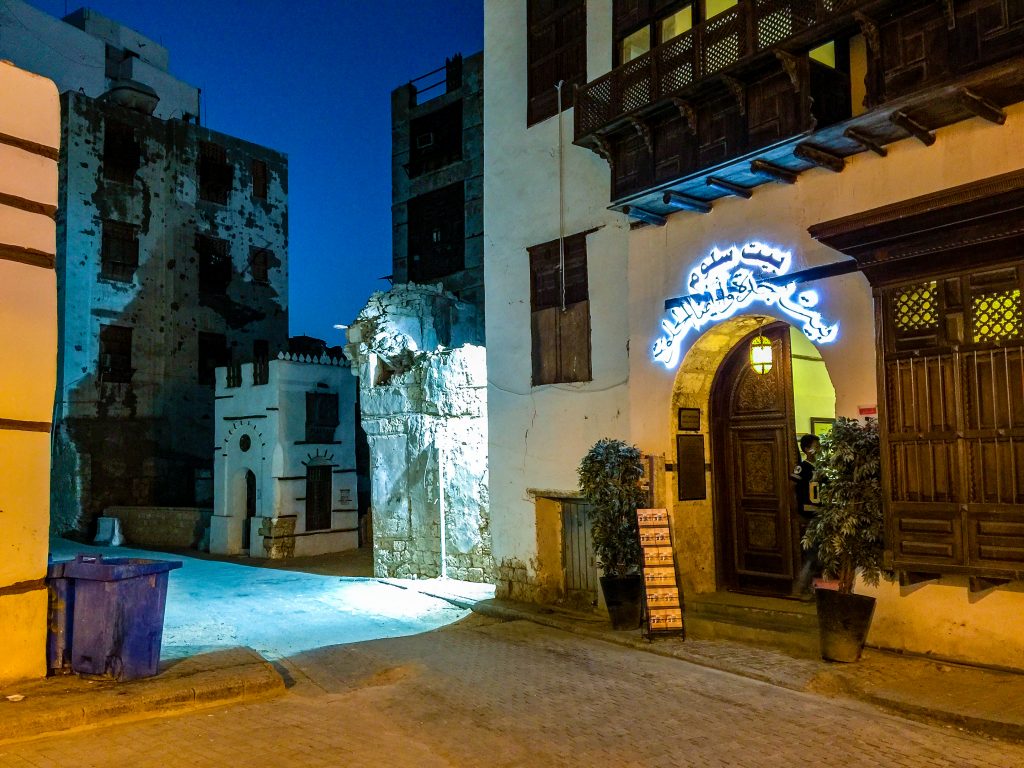
The opening of the Suez Canal in 1869 introduced steamboats linking Europe with Asia and India. The mercantile elite that emerged from the resulting commerce built Al-Balad’s lavish family homes. Today, they have moved to the suburbs to build more modern homes.
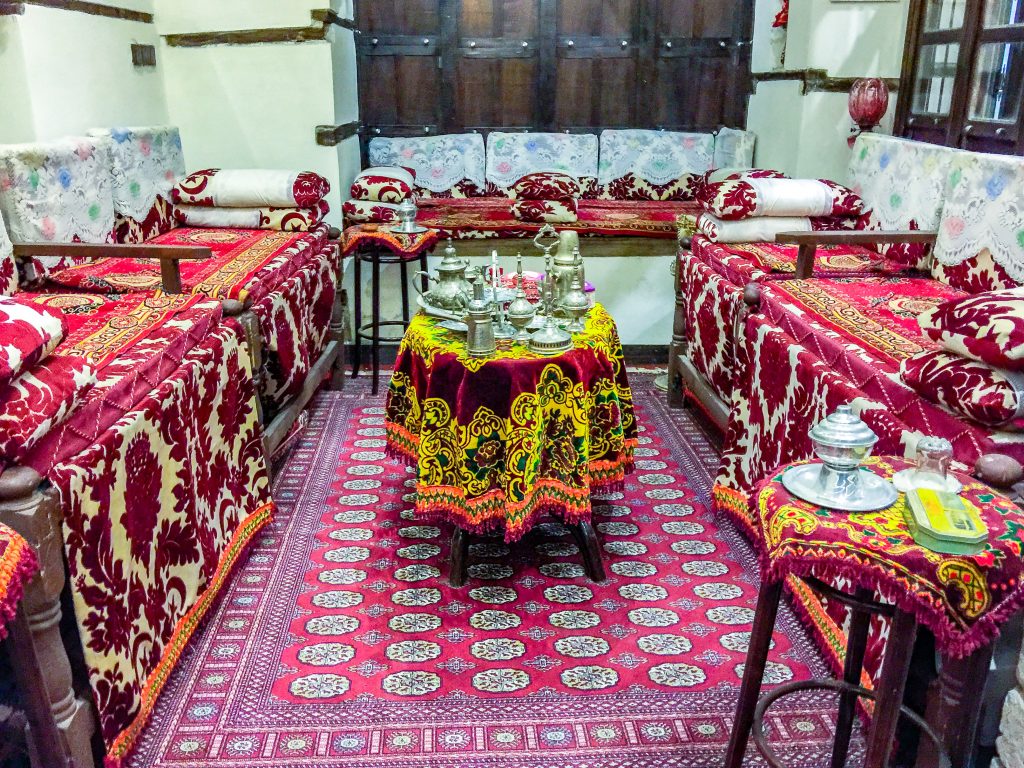
Authentic seating for afternoon tea.
Alabaster, a form of Gypsum, was used on the interior walls.
Once plastered, artisans would sculpt the thick wet wallboard into beautiful designs.
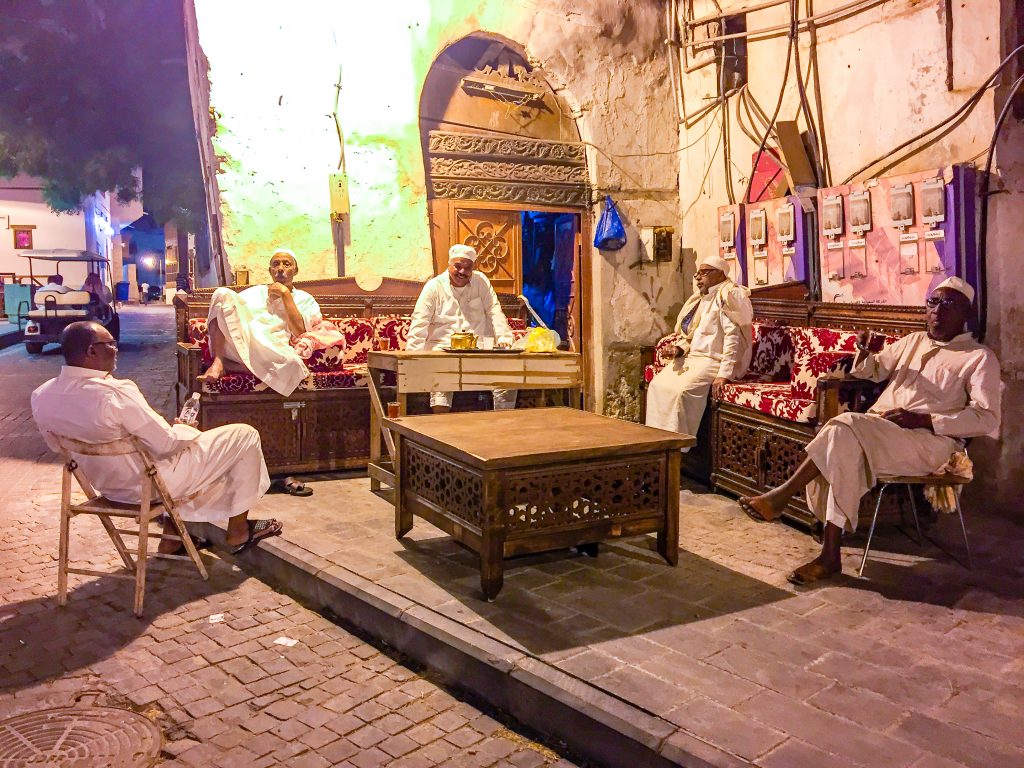
Later that evening in front of Mr. Zakir’s shop, the oldest carpenter in Old Jeddah was still holding court with his friends.
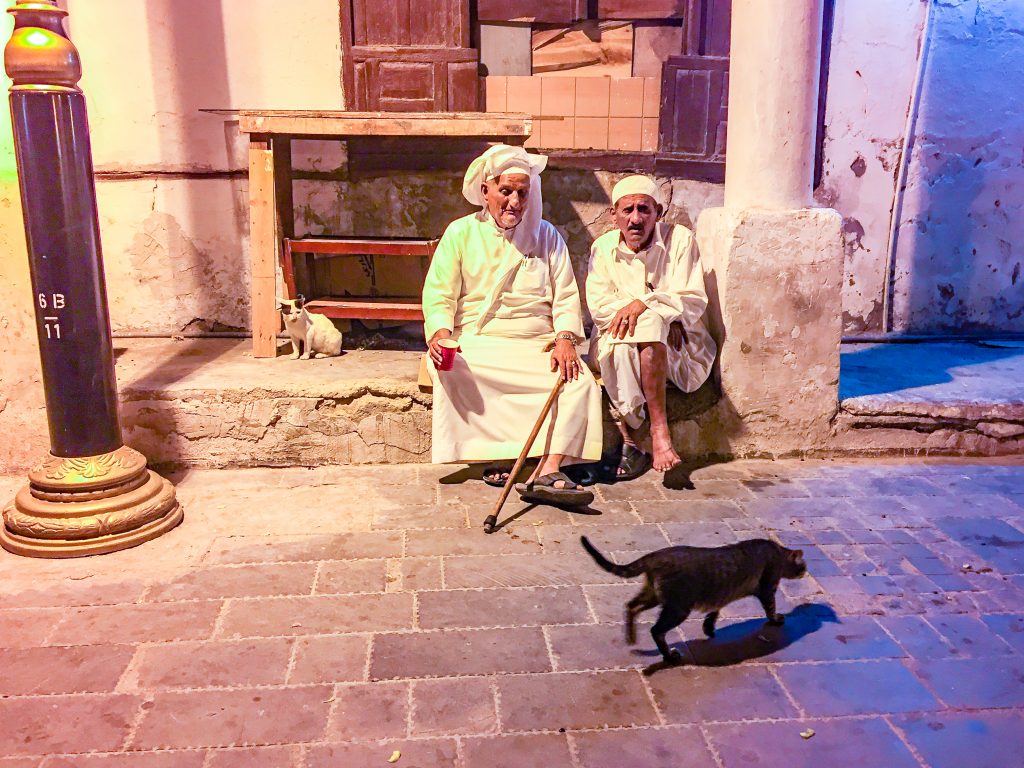
Cats are part of life in Old Jeddah and everywhere else in the Kingdom. Almost 99% are feral. Rarely are they neutered, so the cat population is bountiful. Cats were considered sacred in ancient Egyptian society, and praised for killing rodents and vermin.
These gentlemen look to be playing a game that might be similar to dominoes. I love the reclining gentleman in the corner observing the action.
Families shopping in the old market, called the “souk.”
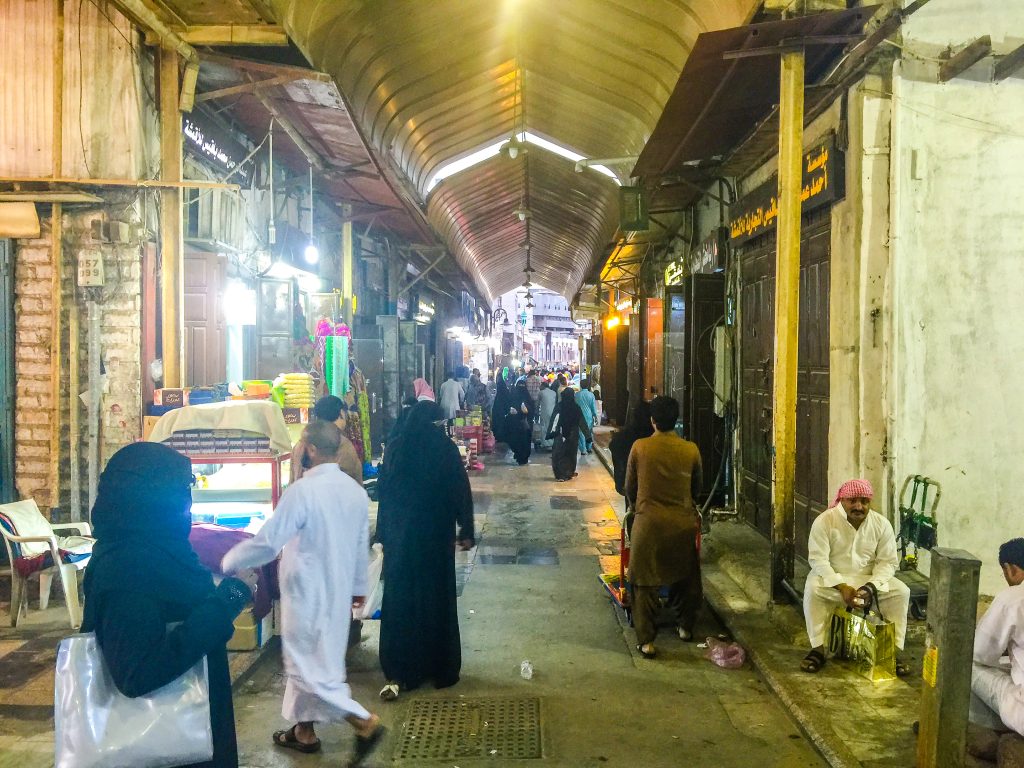
Arabian nights could be considered when walking through this covered souk. A labyrinth filled with treasures. A gentle breeze brought the scent of burning oud. I found scarves and abayas in all colors imaginable, sandals, jewelry made of coral from the Red Sea, old silver jewelry and modern gold necklaces and bracelets. Arabic perfumes, oils and incense burners to burn frankincense. Dates, spices, Arabic coffee beans, honey, vegetables and fresh fruits.
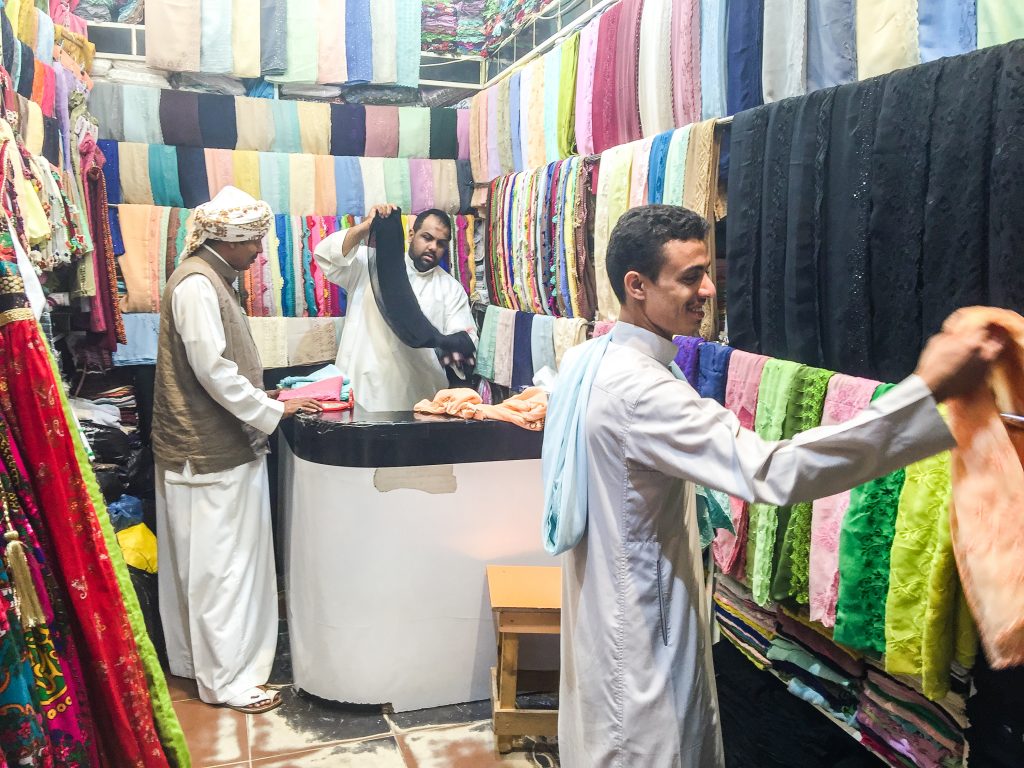
Samir picking out scarves for me. As I walked through the indoor and outdoor souks I saw many more women working in shops than I had in my previous visits. Life is changing in Saudi Arabia.
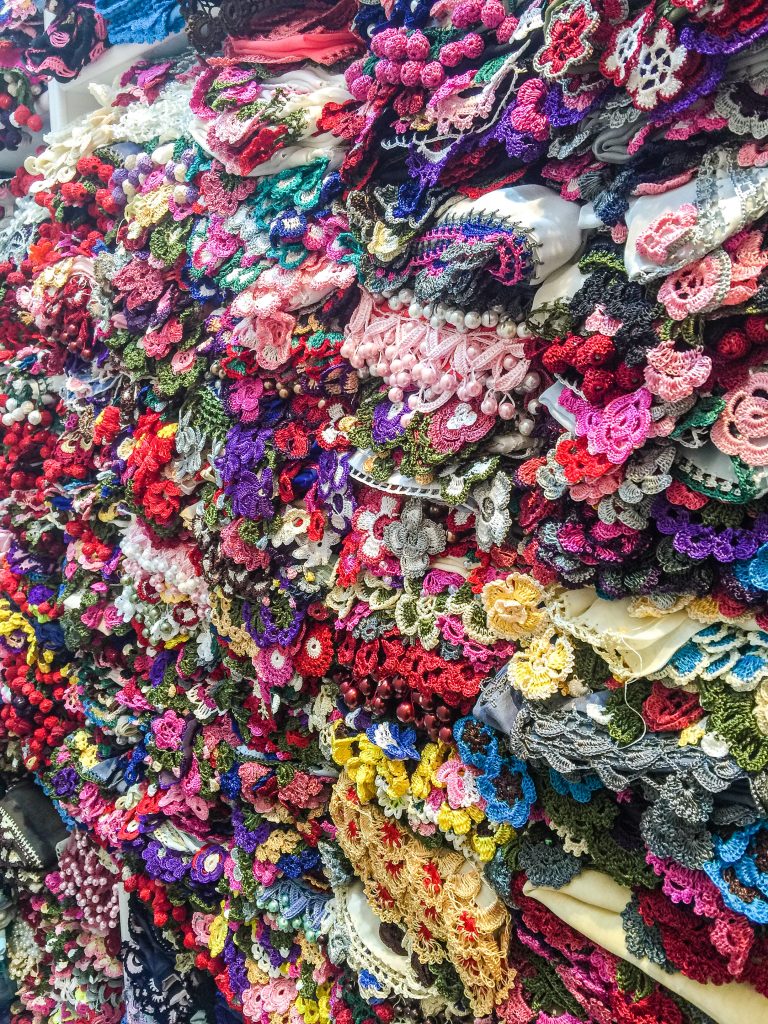
As you can see, the plethora of choices was incredible.
I rarely saw women in the souk during the day but at night the streets were teeming with families.
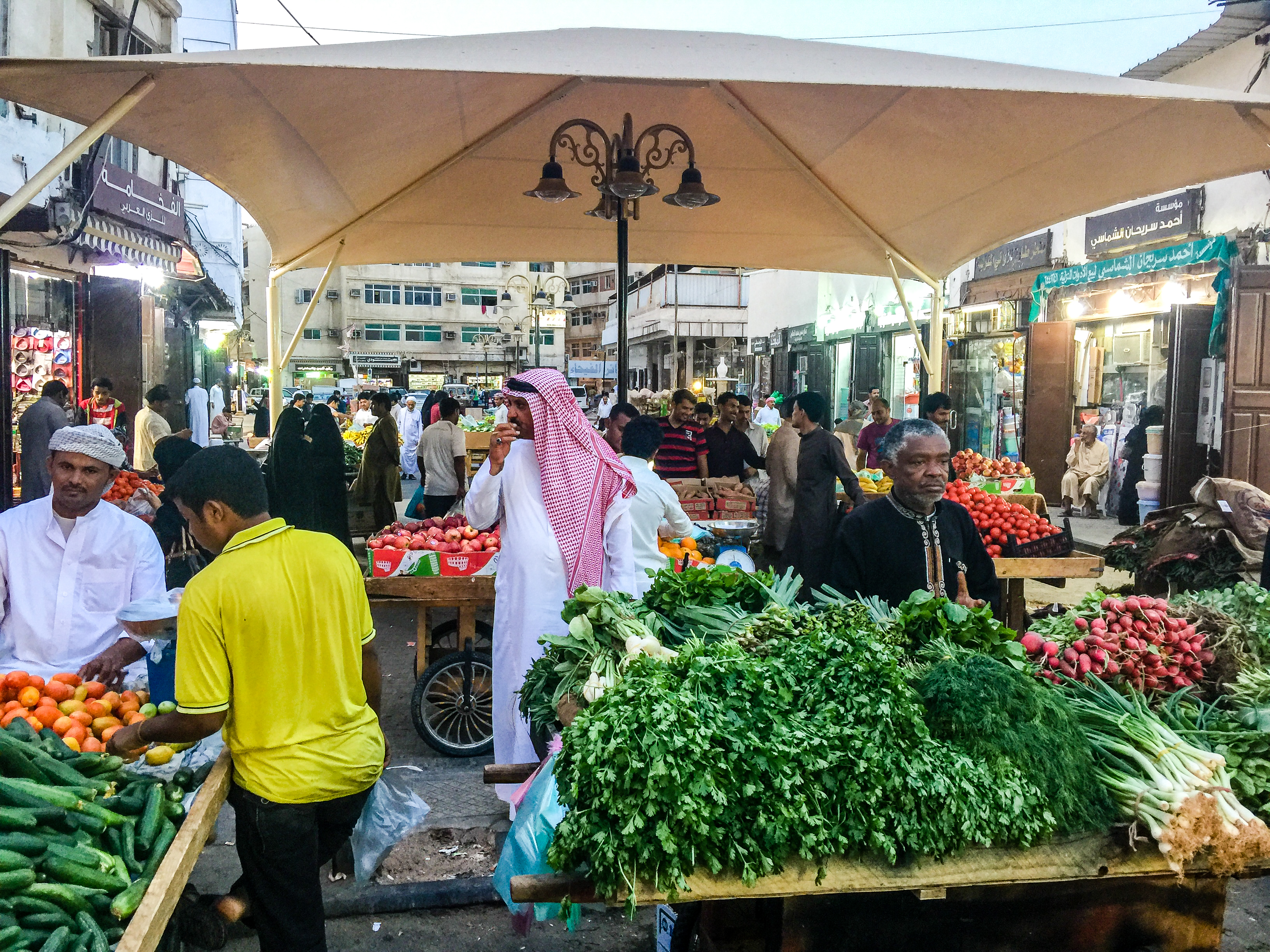
The visual feast was breathtaking.
The street vendors offer beautiful produce.
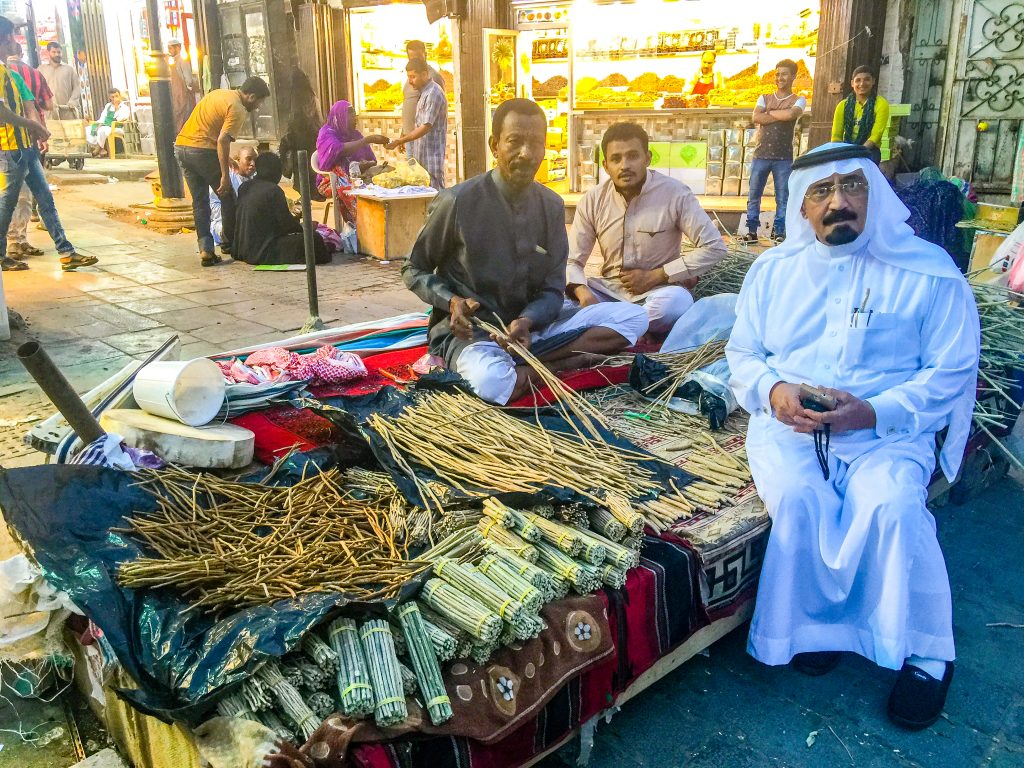
Miswak is a twig that helps in cleaning teeth. It has been in use for over 7,000 years, since the time of the ancient Babylonians and Egyptians. It is considered to be the first documented form of dental hygiene.
Some dentists think it is best-kept secret of the ancient world. This elegant gentleman certainly thinks so…
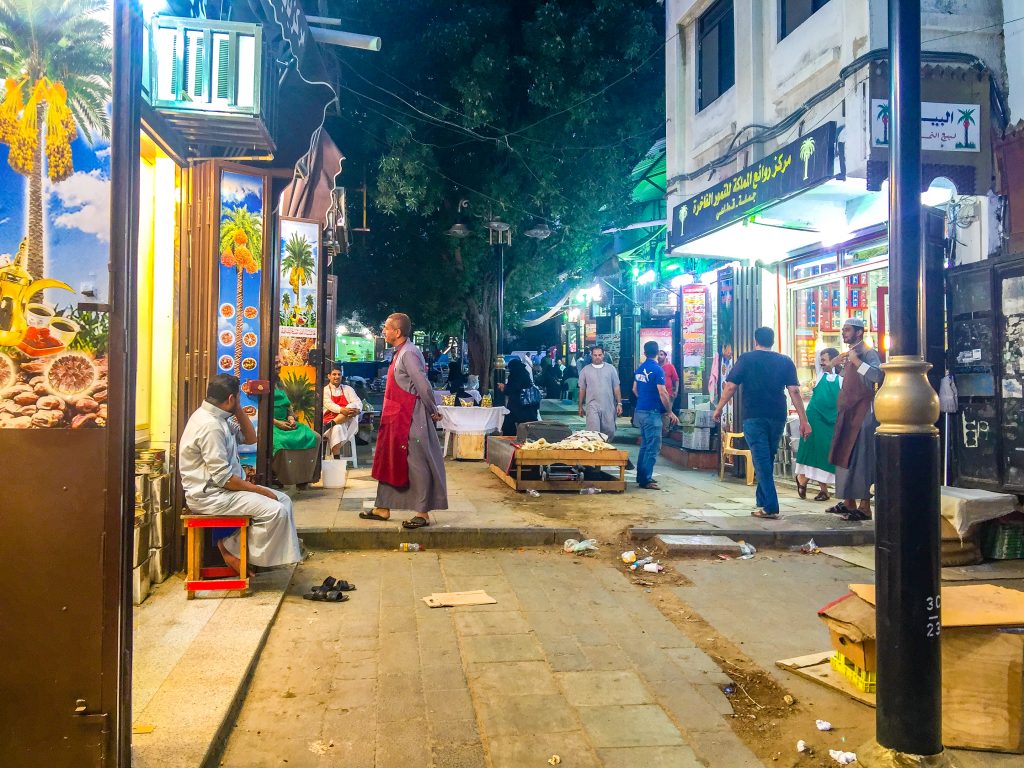
Shopkeepers resting in the early evening.
The marketplace is for both men and women. There have always been women who have participated in commerce, from this level of selling their goods in the souk to running their own establishments.
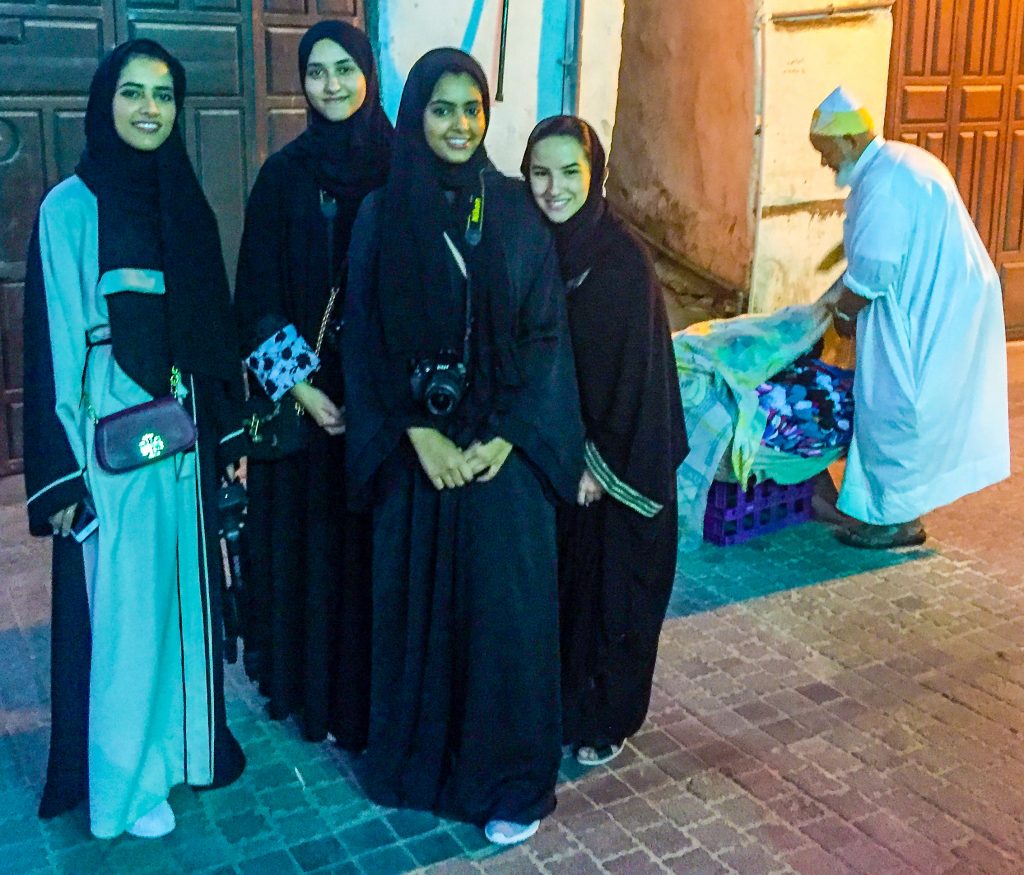
When the call to prayer sounds, everyone responds. Whether they are shoppers or the local street vendors, the citizens of Old Jeddah stop what they are doing to answer the call.

As you can see, street vendors are very trusting of their fellow citizens, only covering their wares with a cloth to protect them from dust and sand while they go off to pray.
All throughout the city of Old Jeddah children flock to Samir. He clearly is someone the young boys respect and adore. It was truly a privilege to see how he interacted with the people in his own hometown.
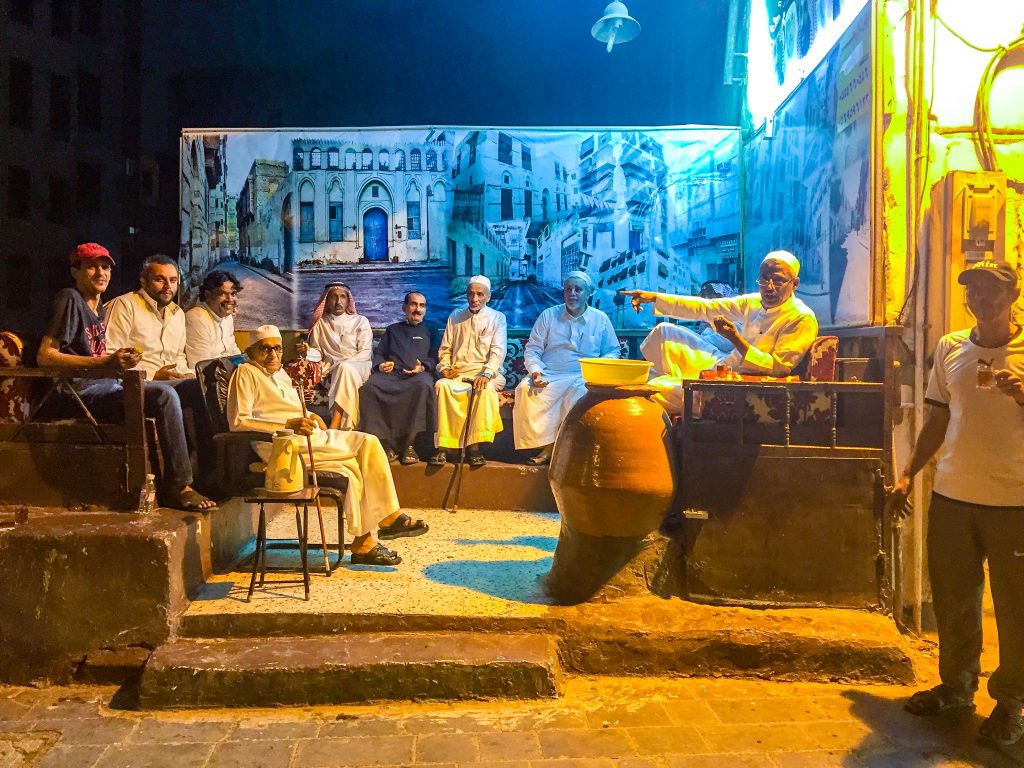
As promised, Mr. Al-Bahloli and his friends pictured later in the evening. The mural behind them was painted by a local painter from Al-Balad.
The large vase holds ful medames. Ful is a dish of fava beans. Fava beans are one of the oldest domesticated food legumes. Fava beans have been part of the Middle Eastern diet since the 4th century. It is very popular with each country preparing it in their own particular style.
The conversations will continue in the coolness of the night for some of the gentlemen until sun brings back the morning’s heat.
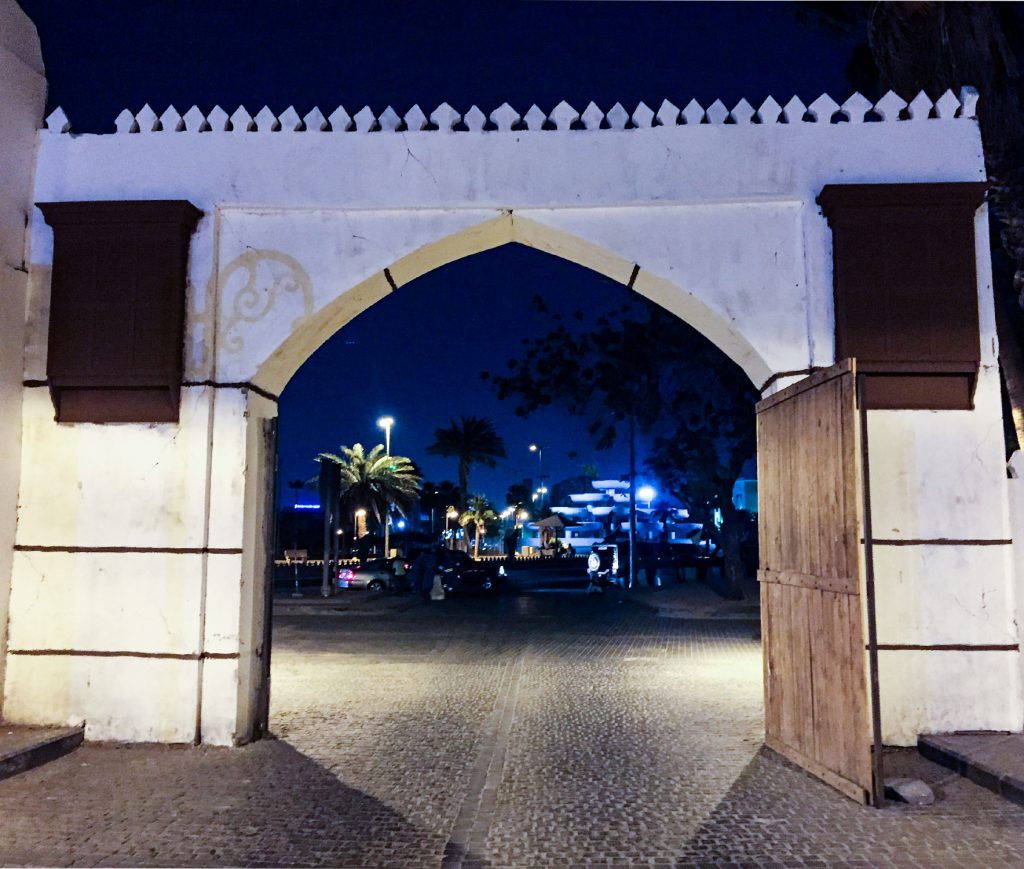
Good night, Old Jeddah.

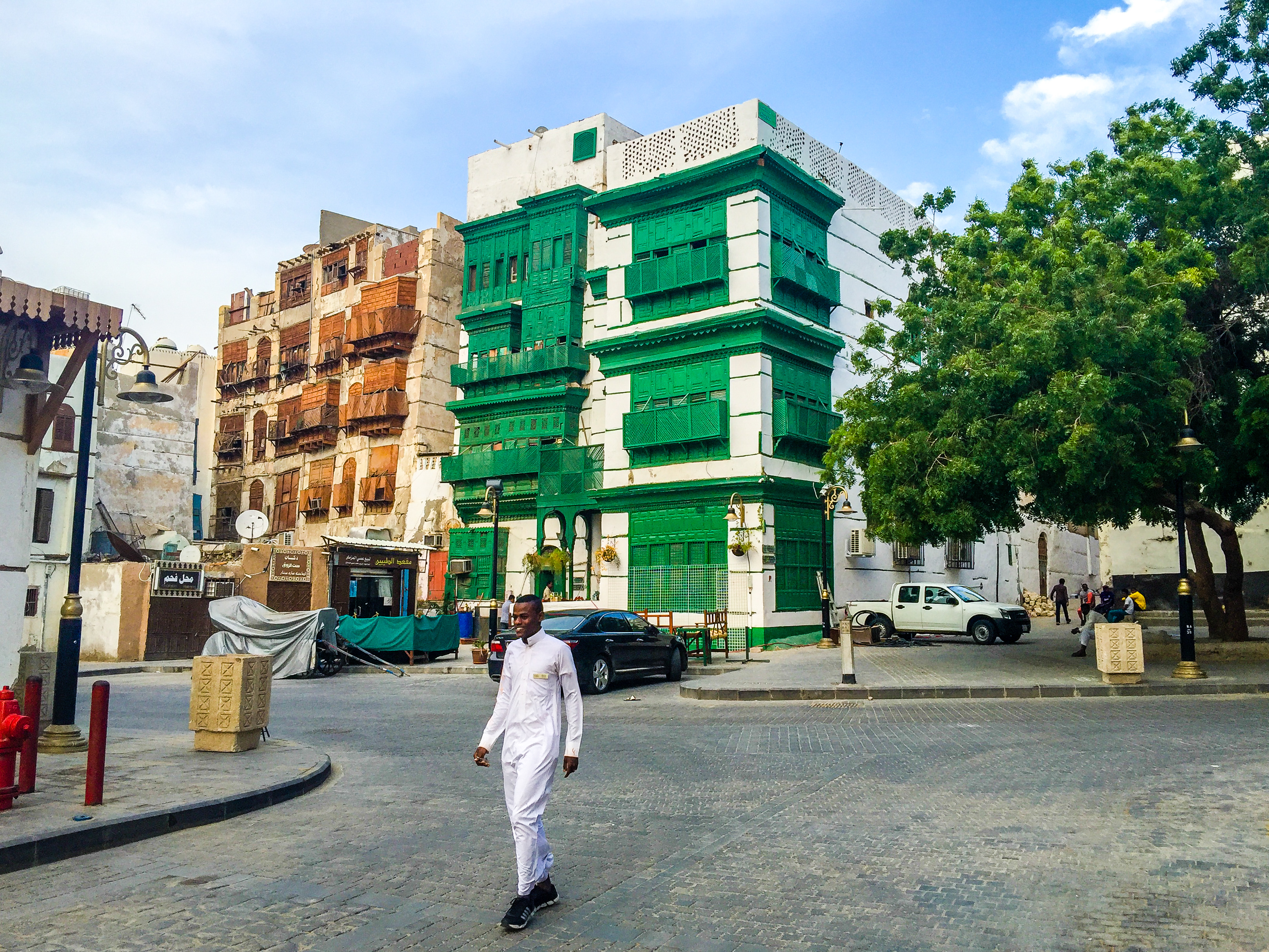
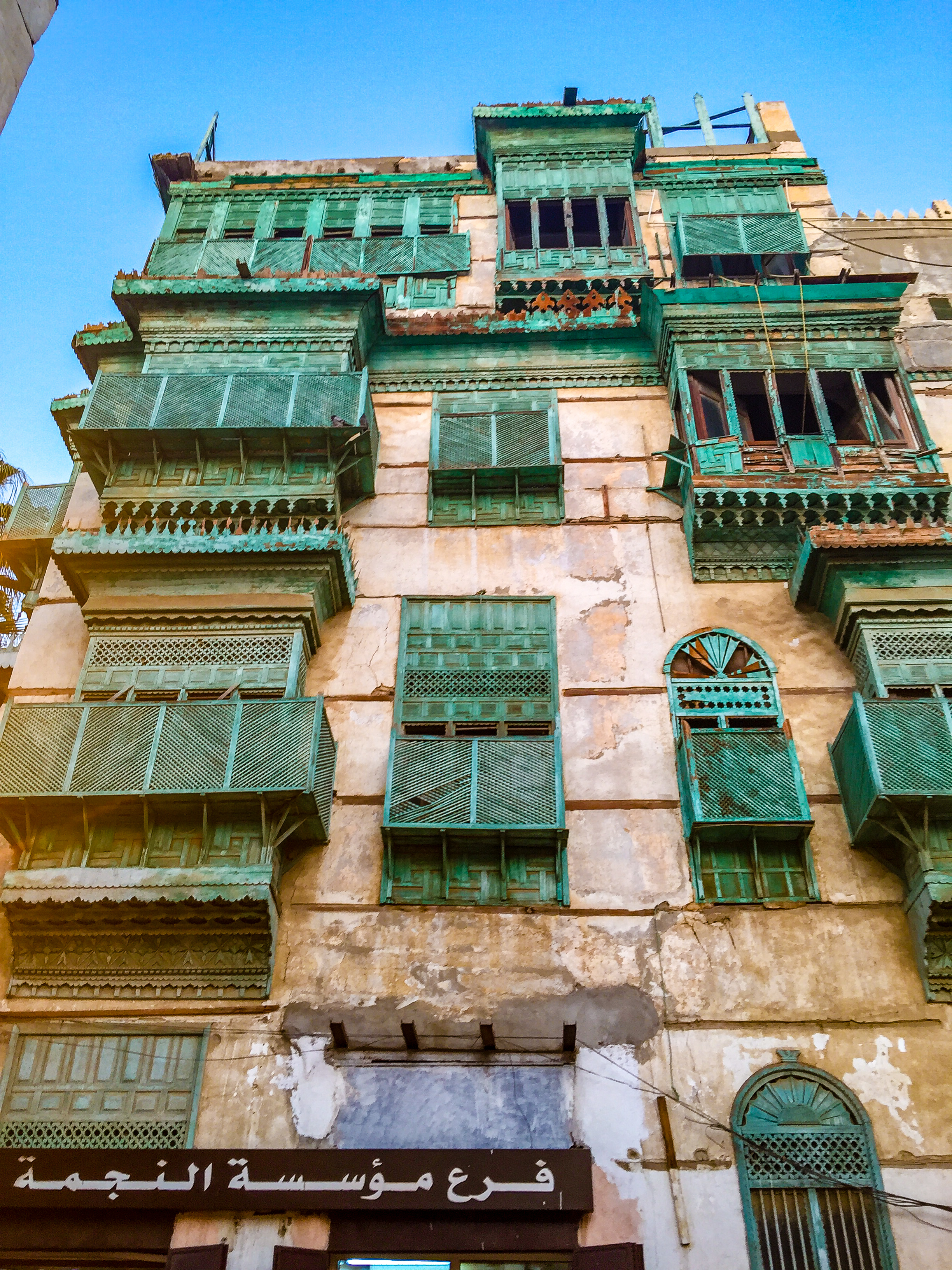
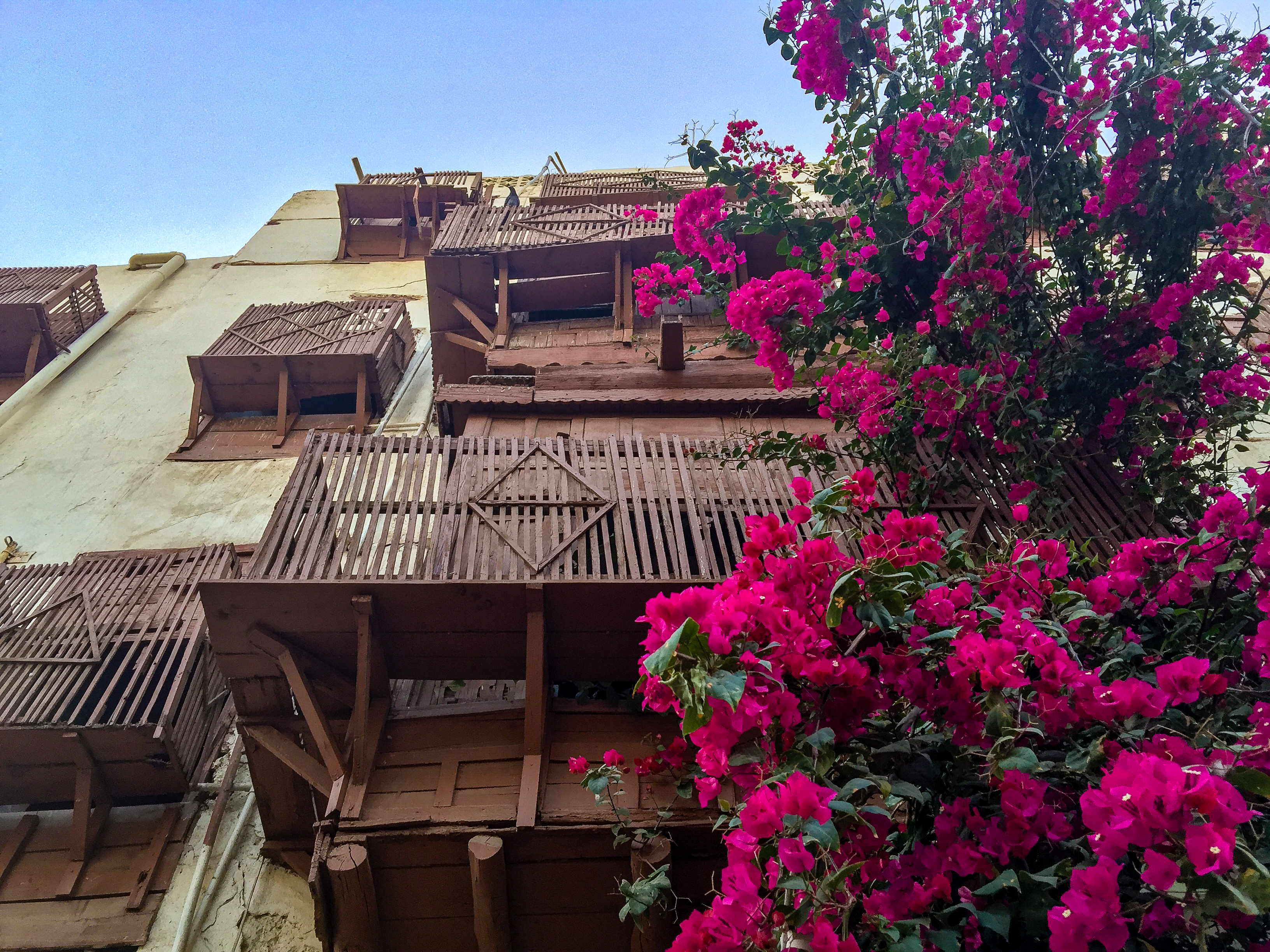
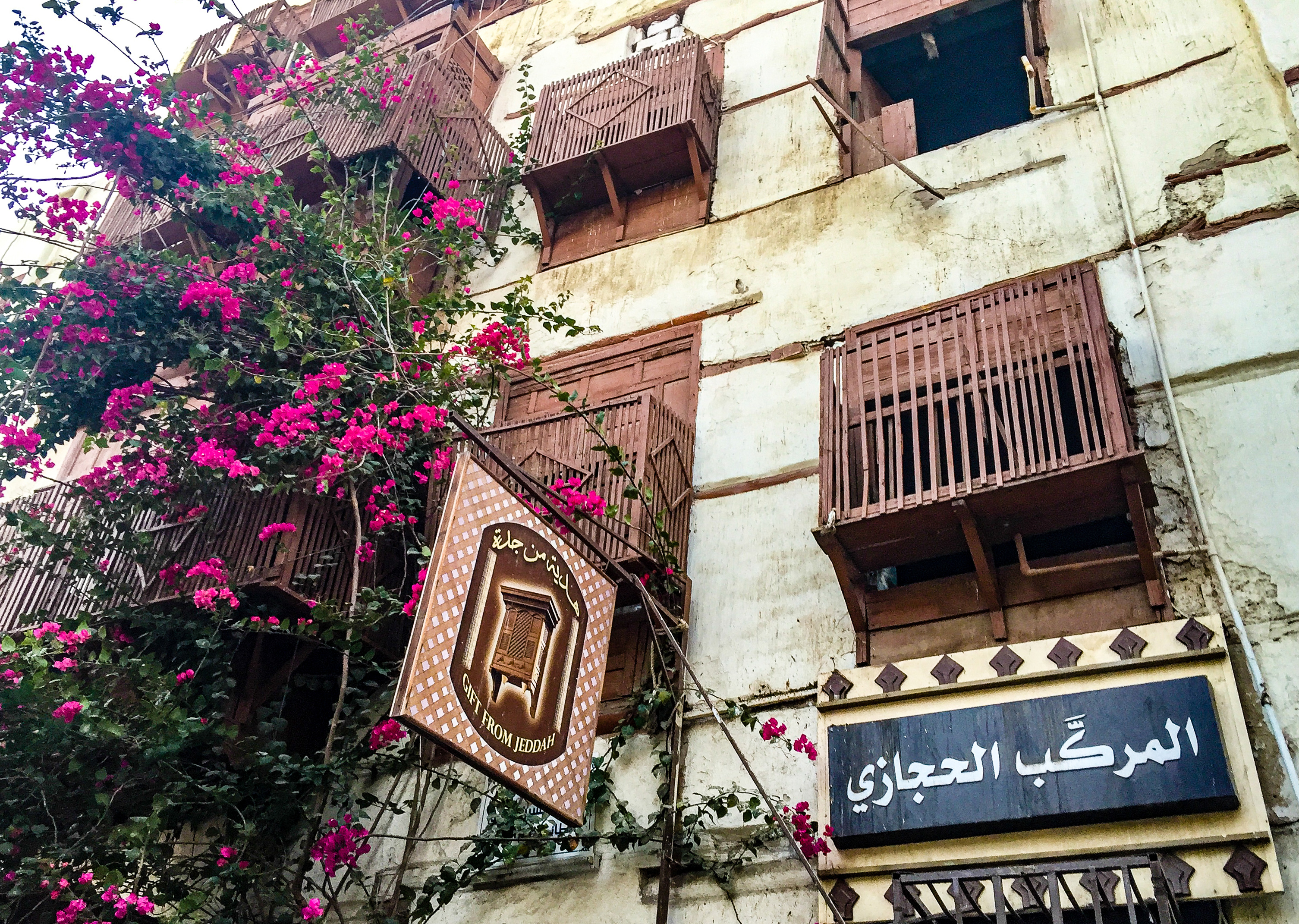
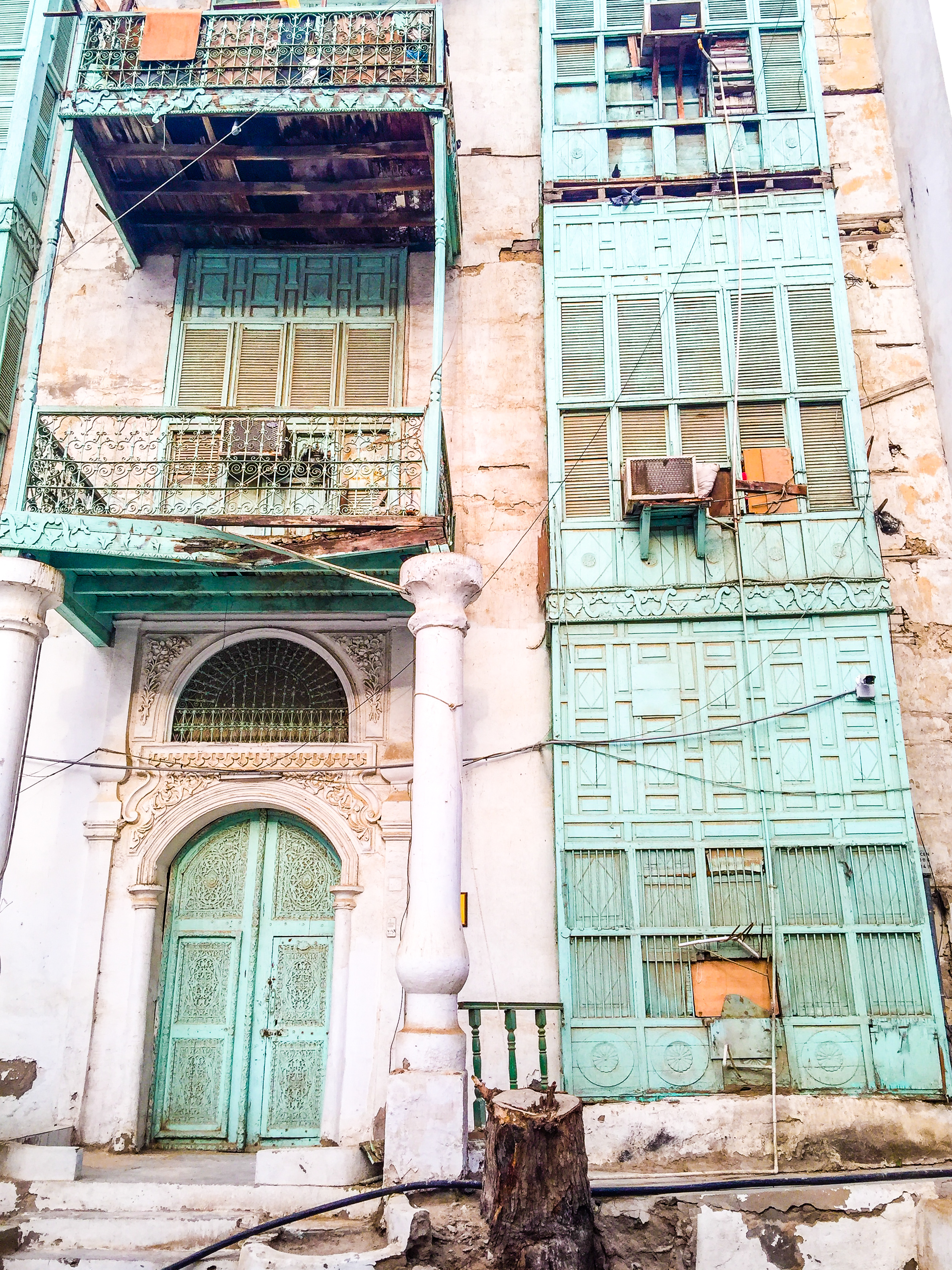
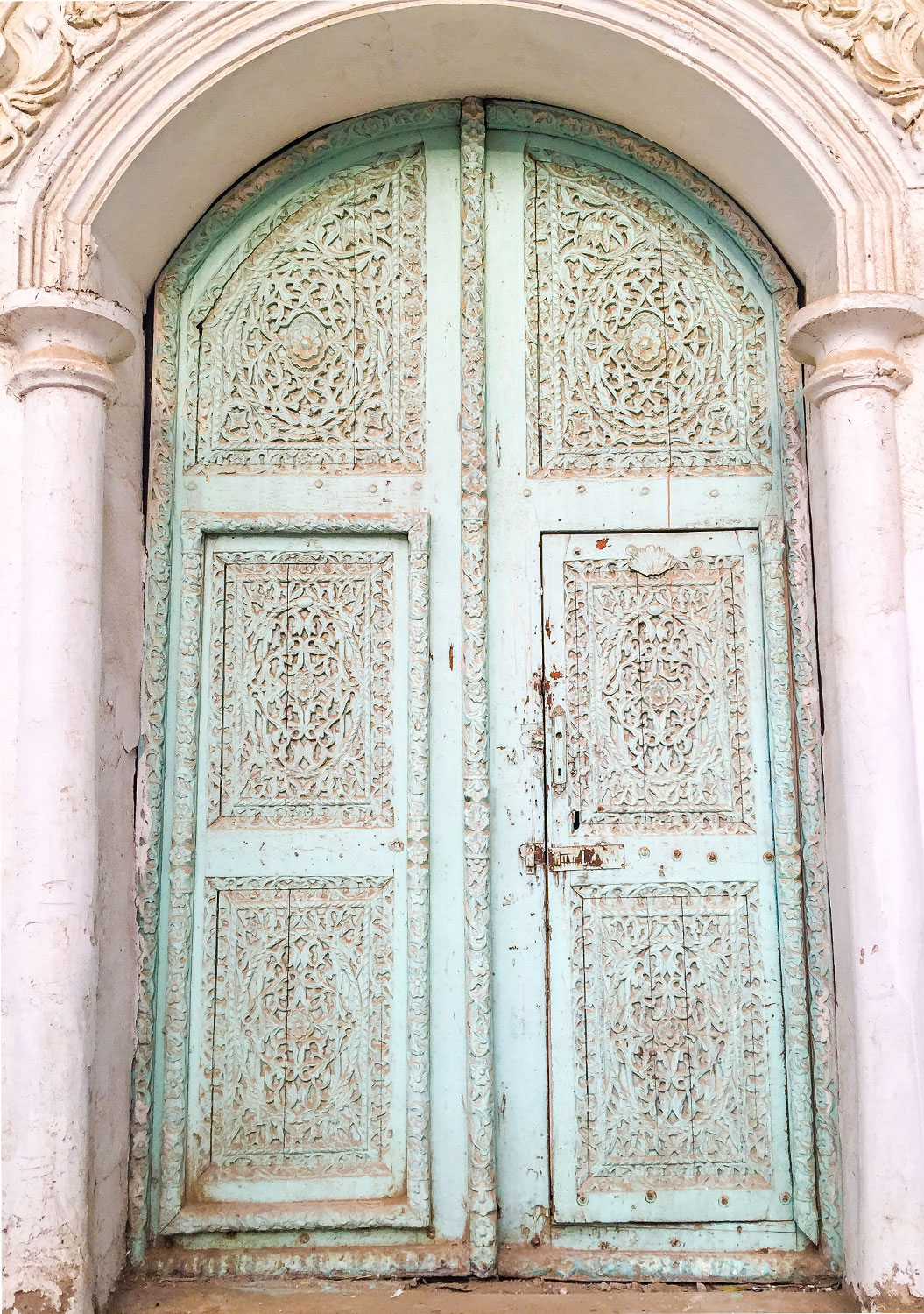
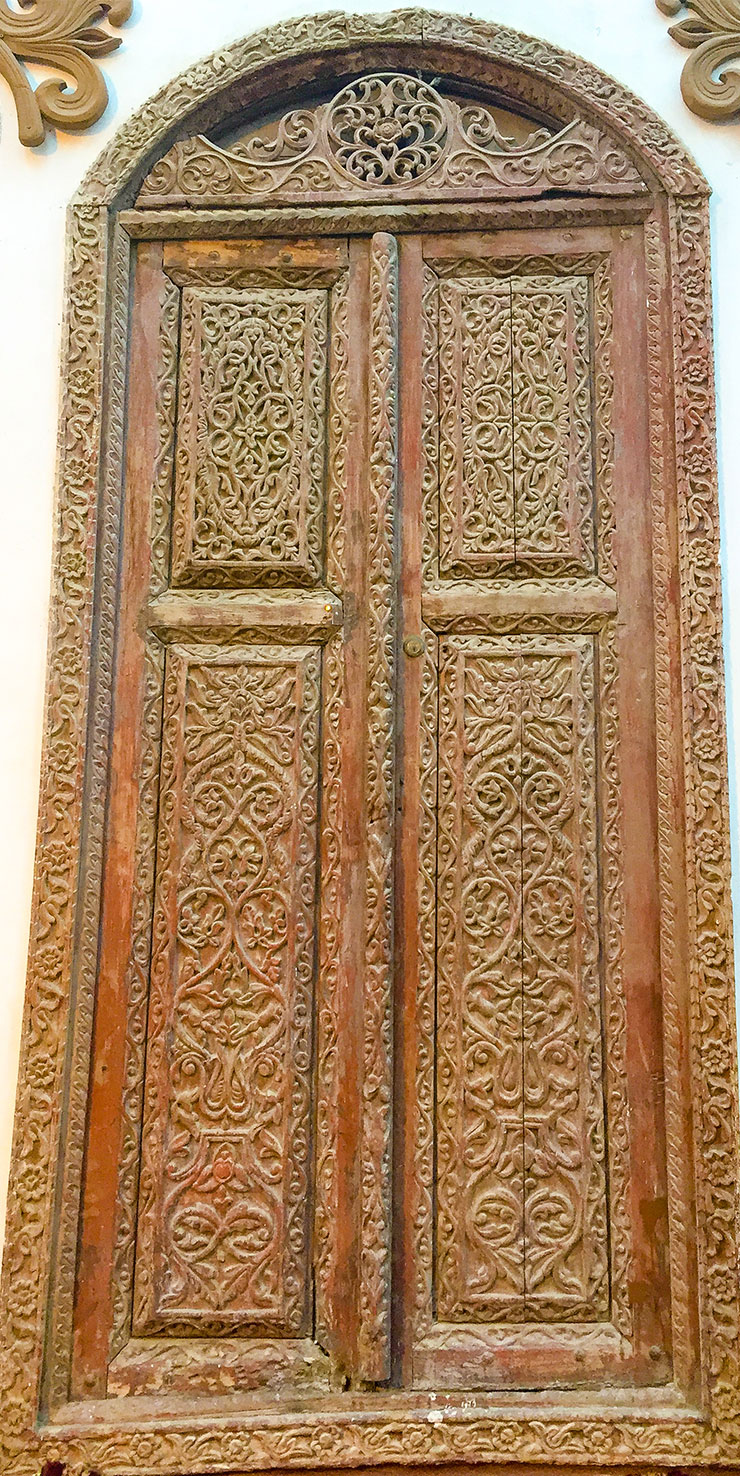
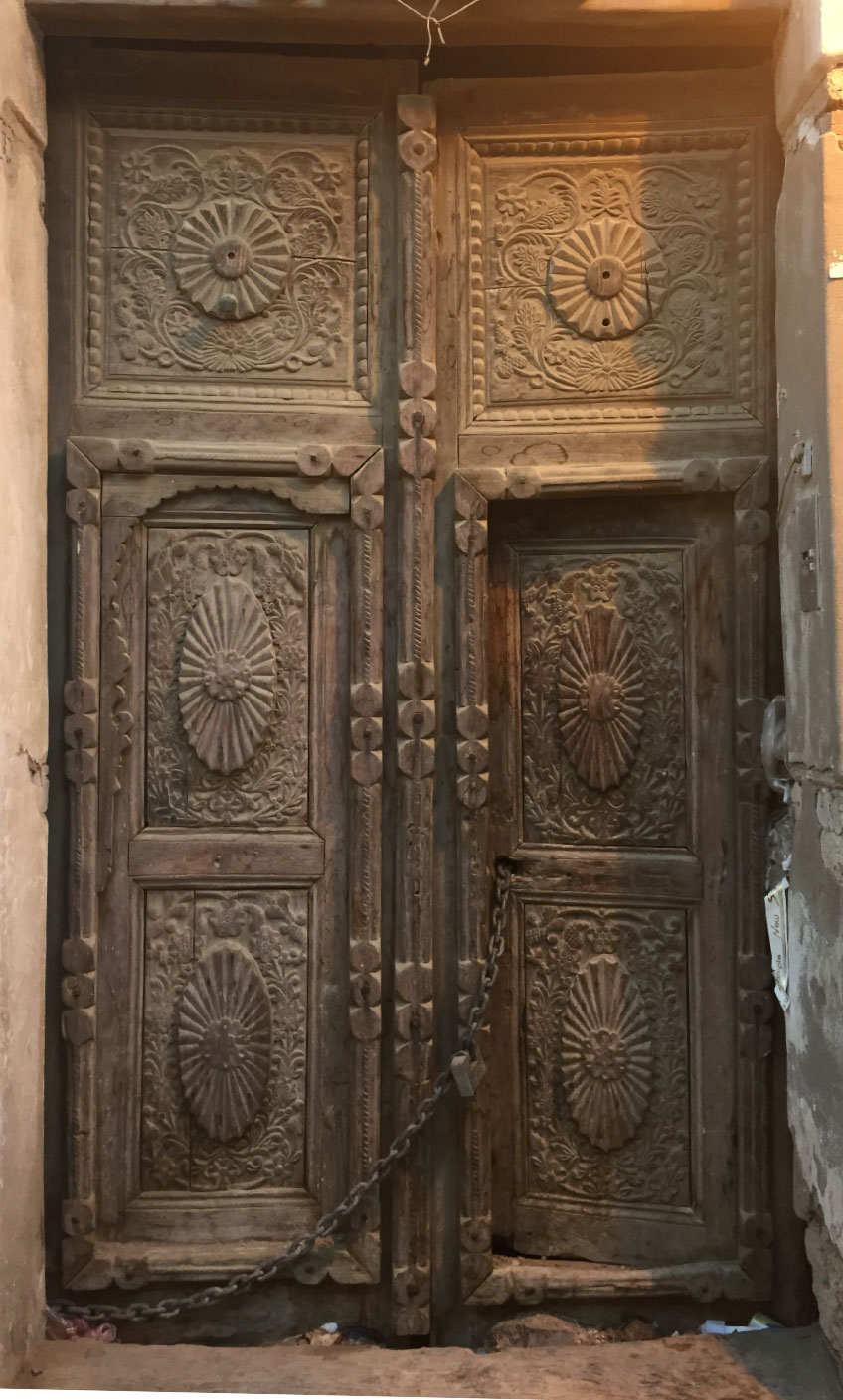
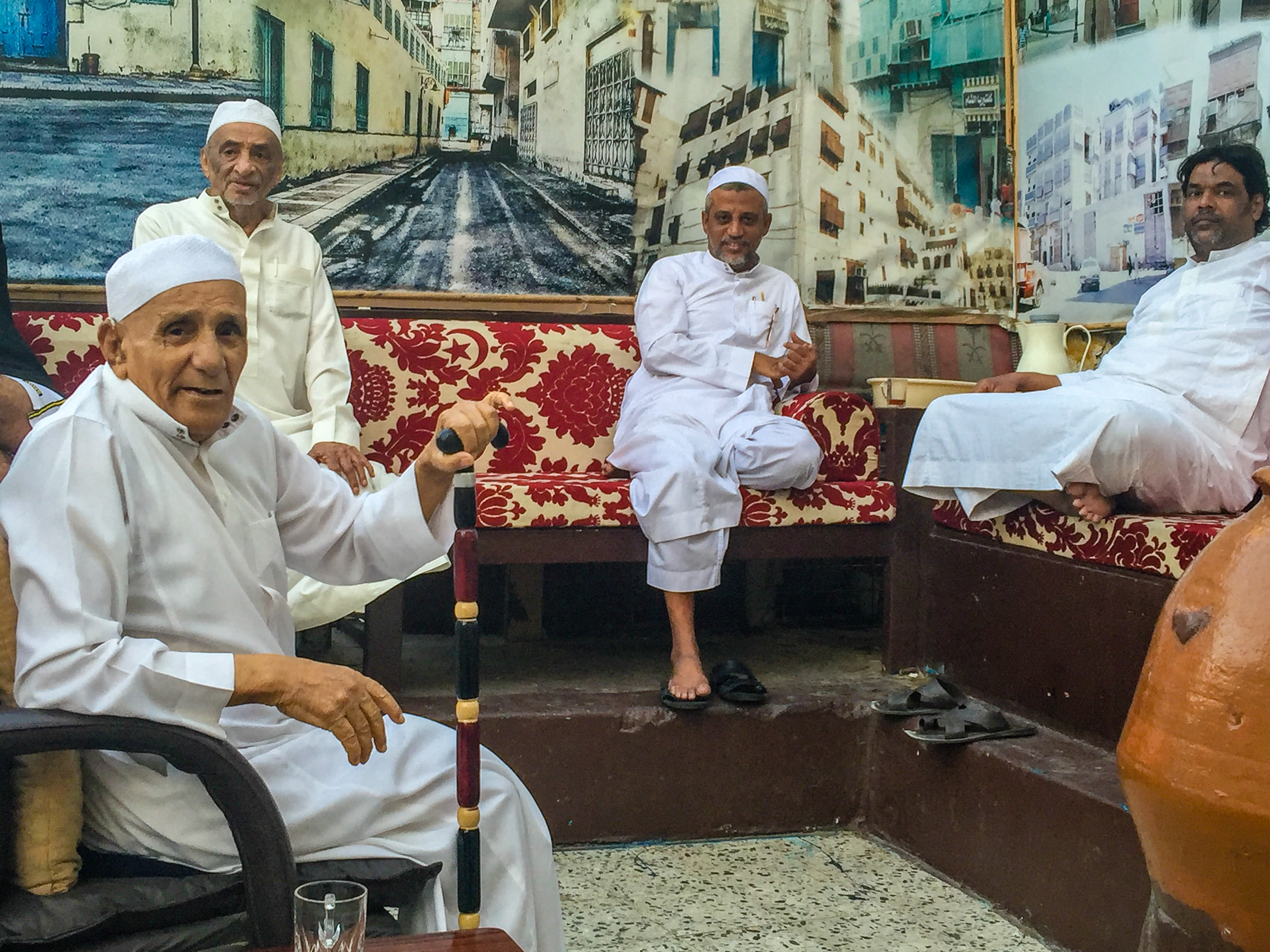
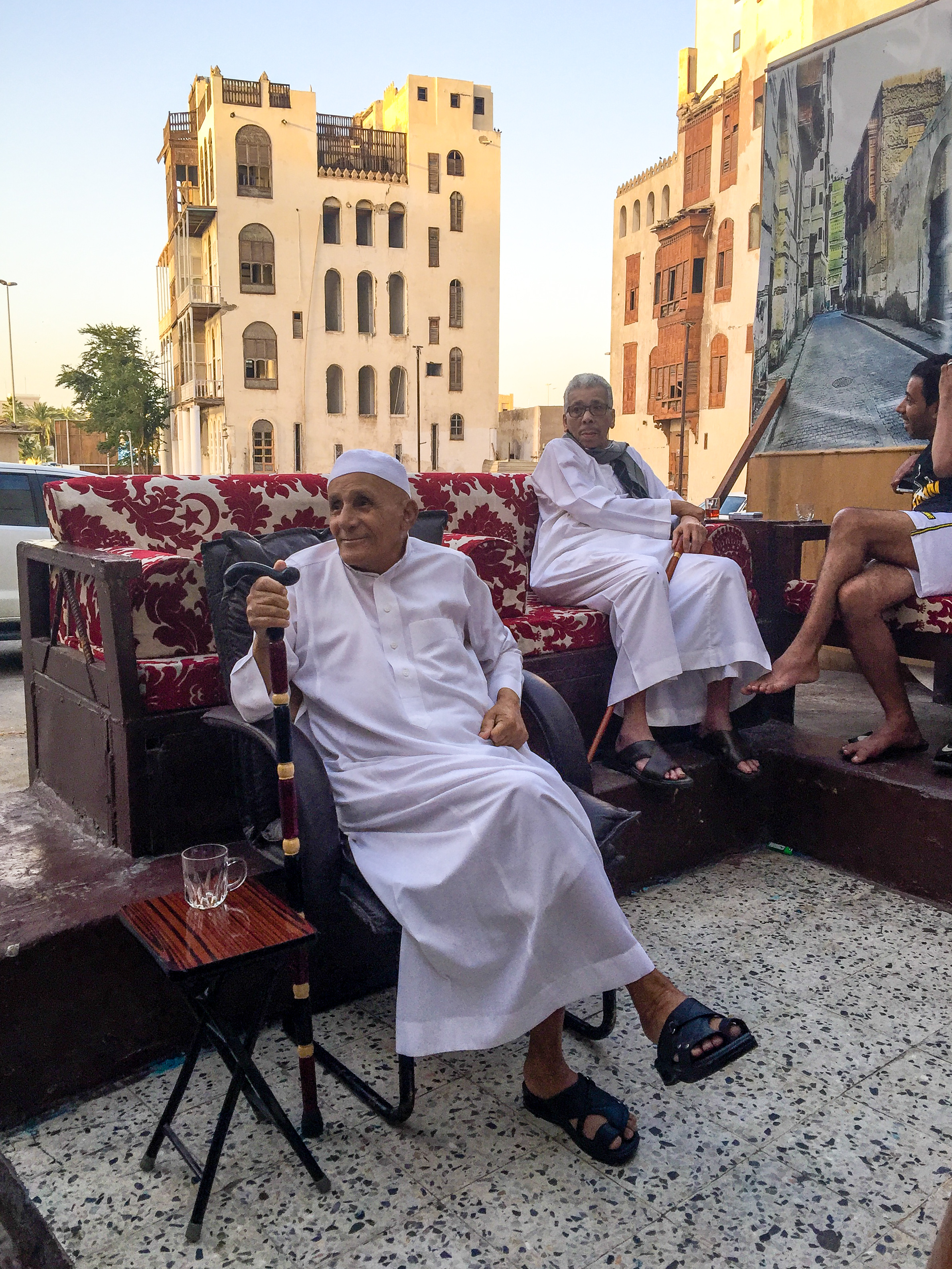
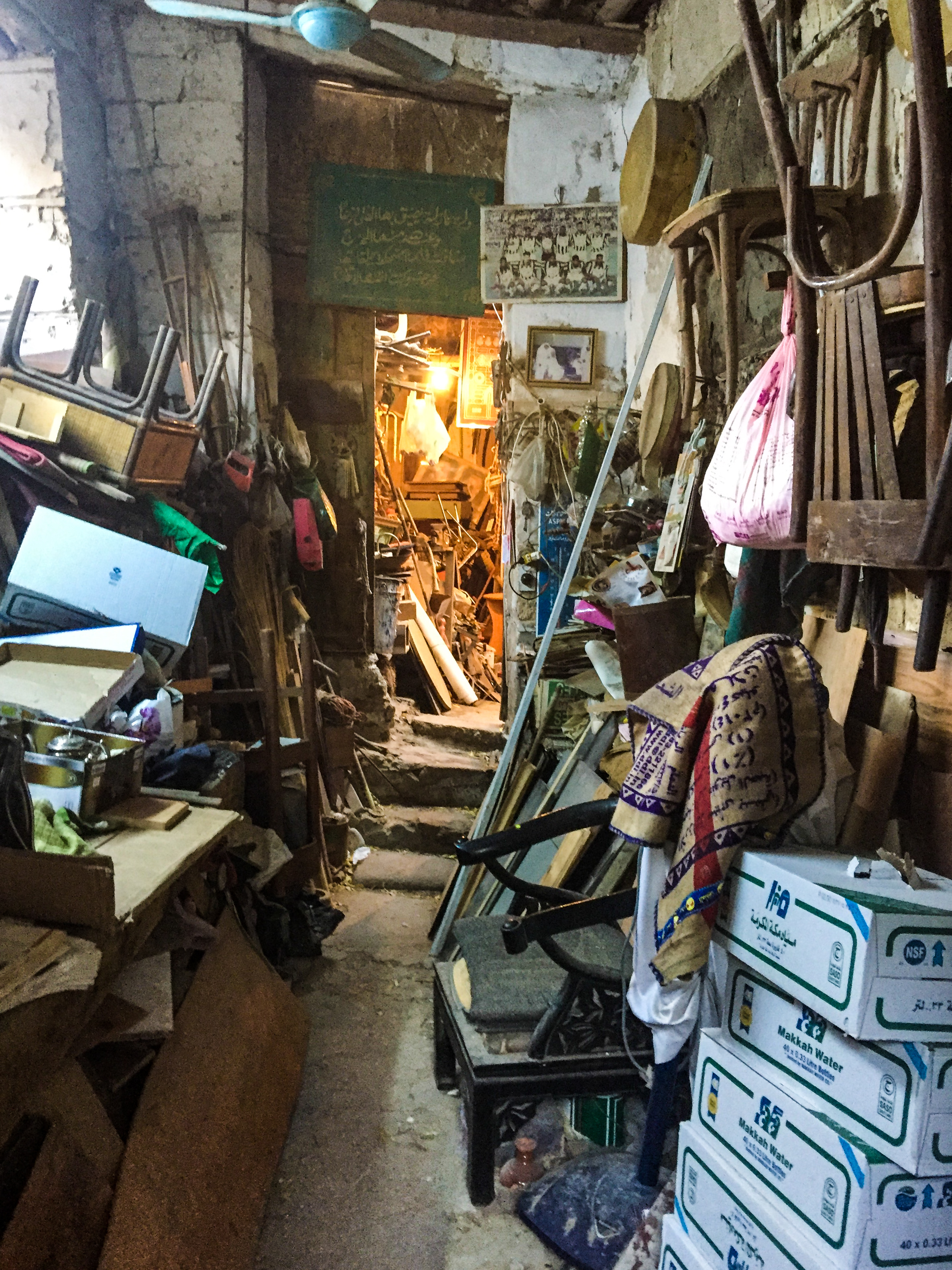
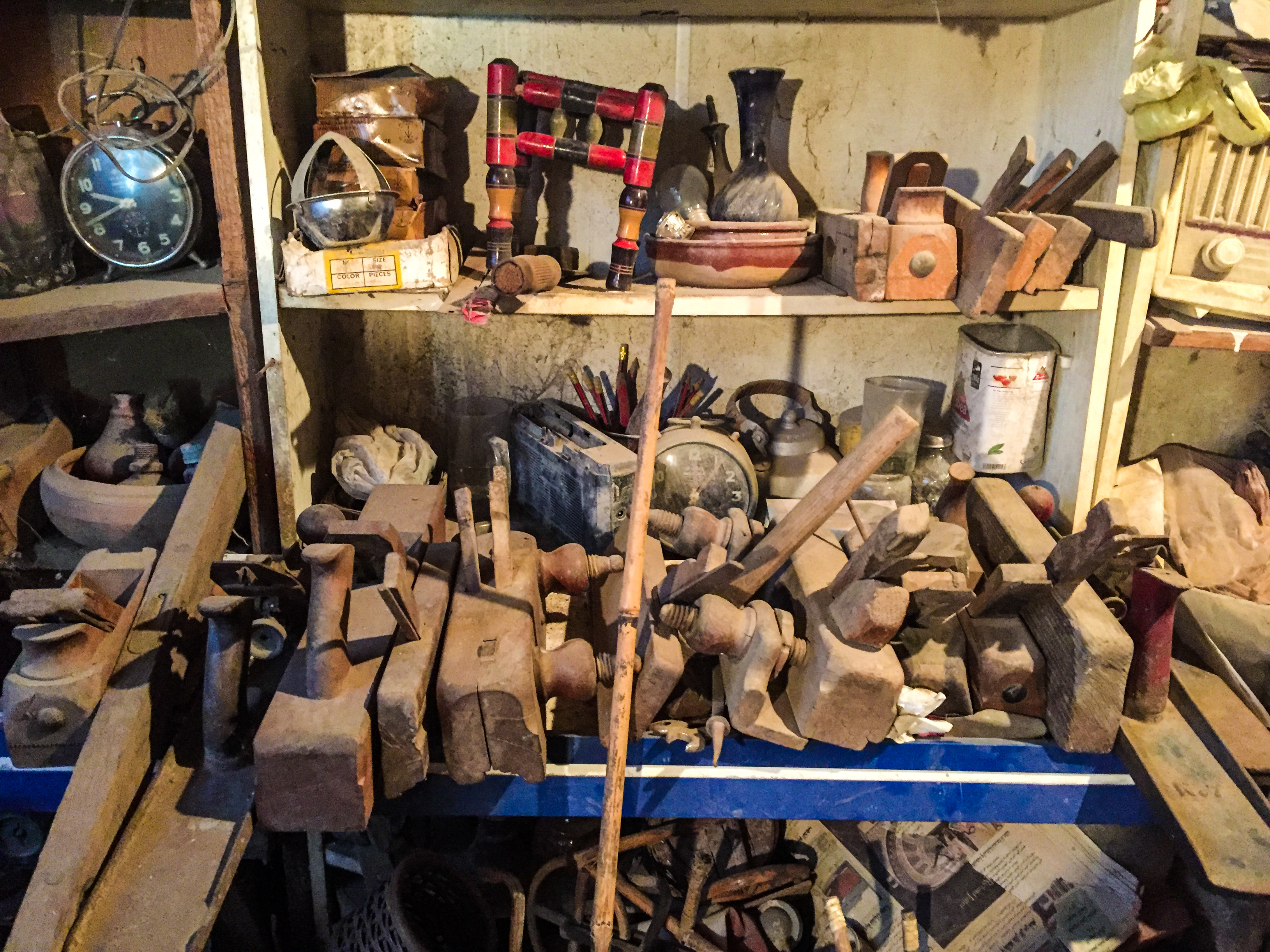
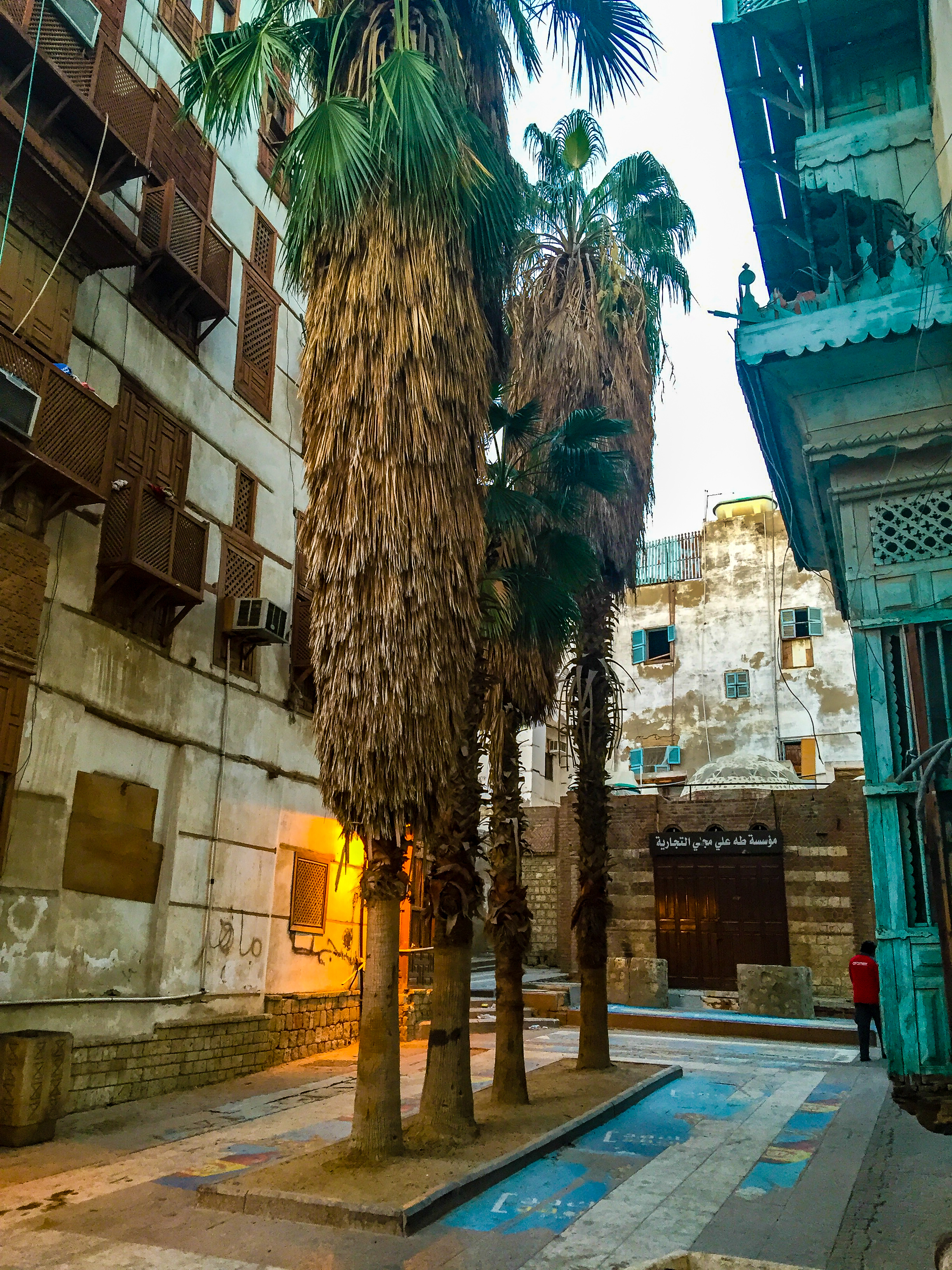
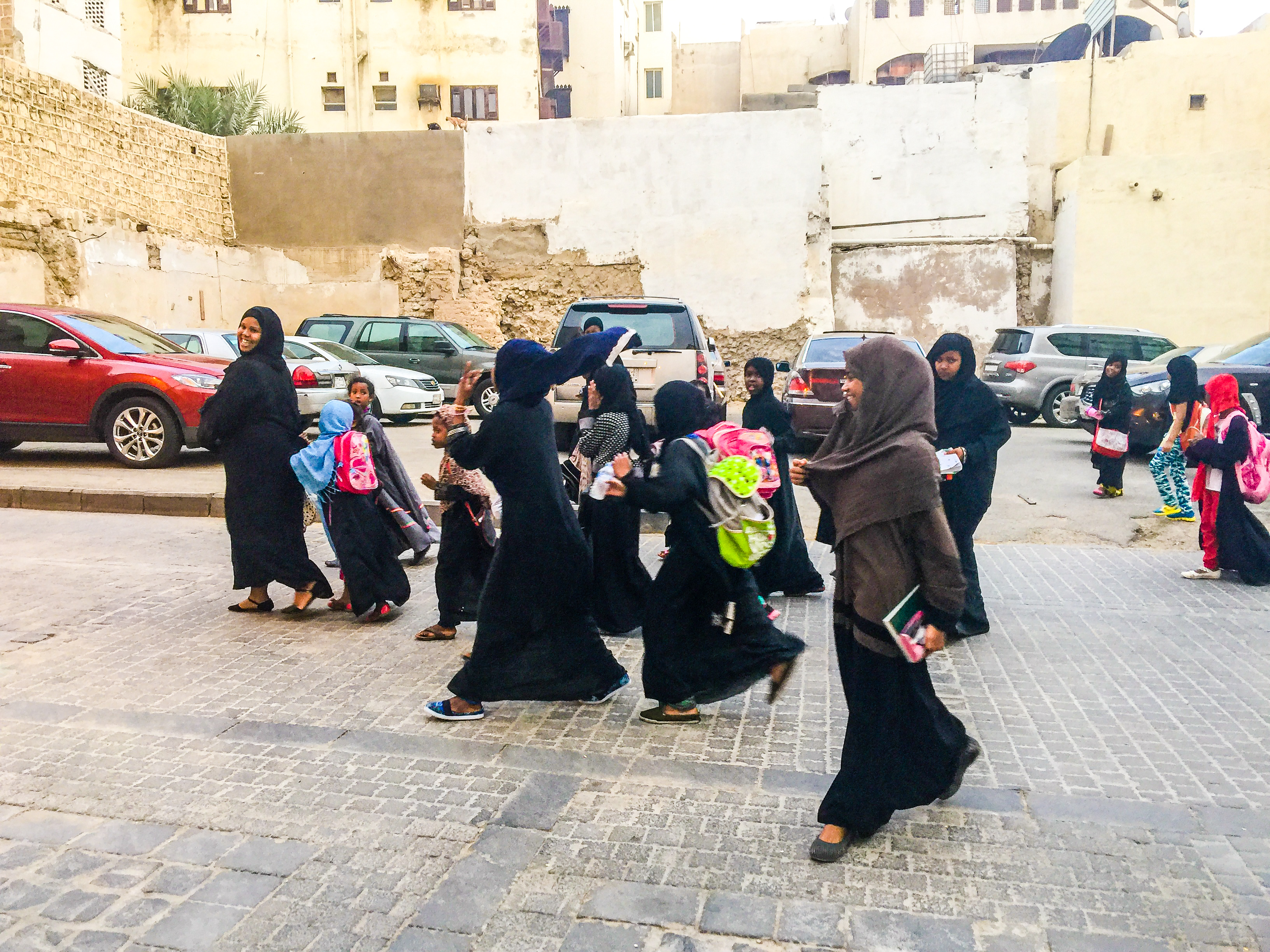
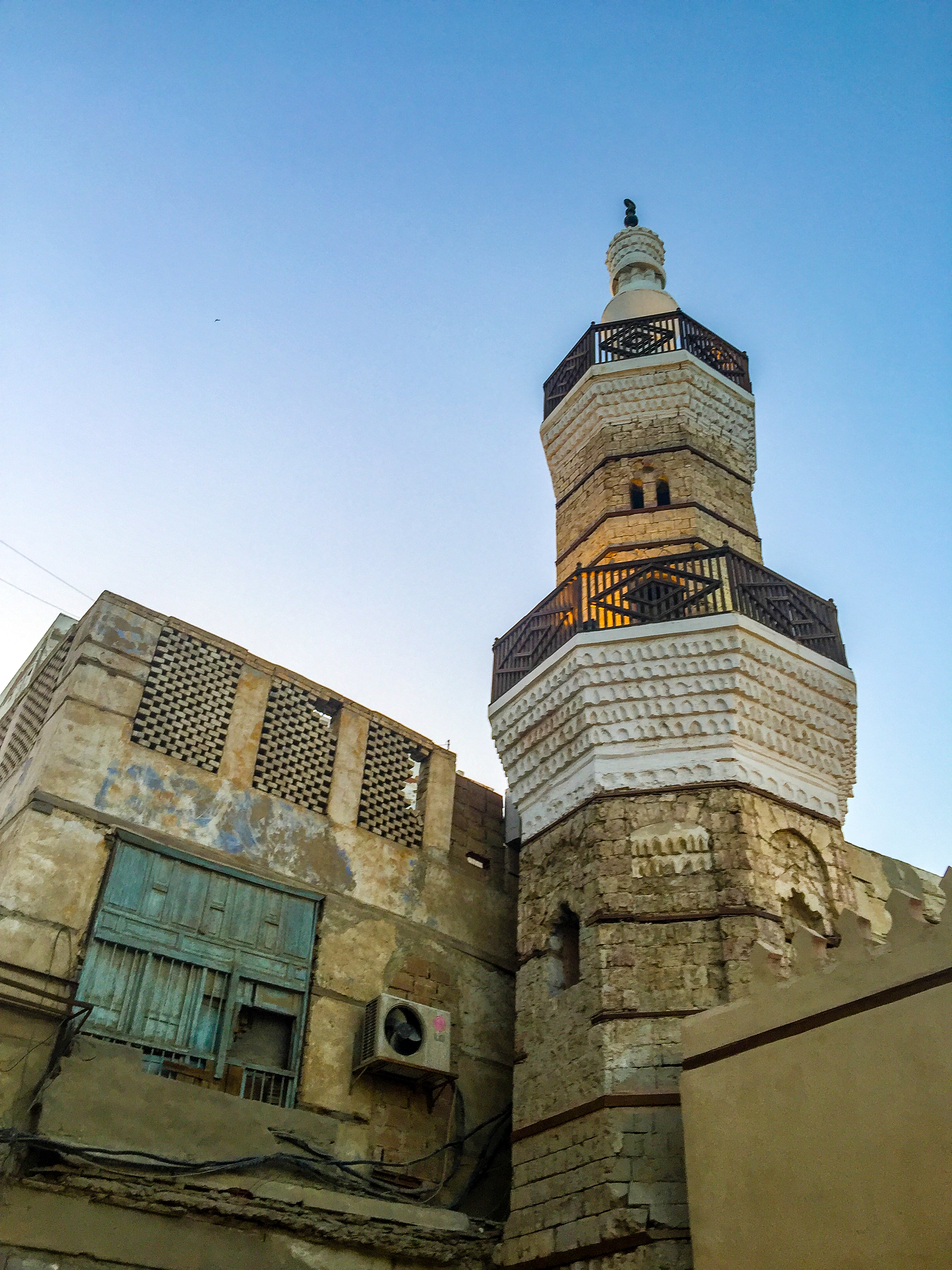
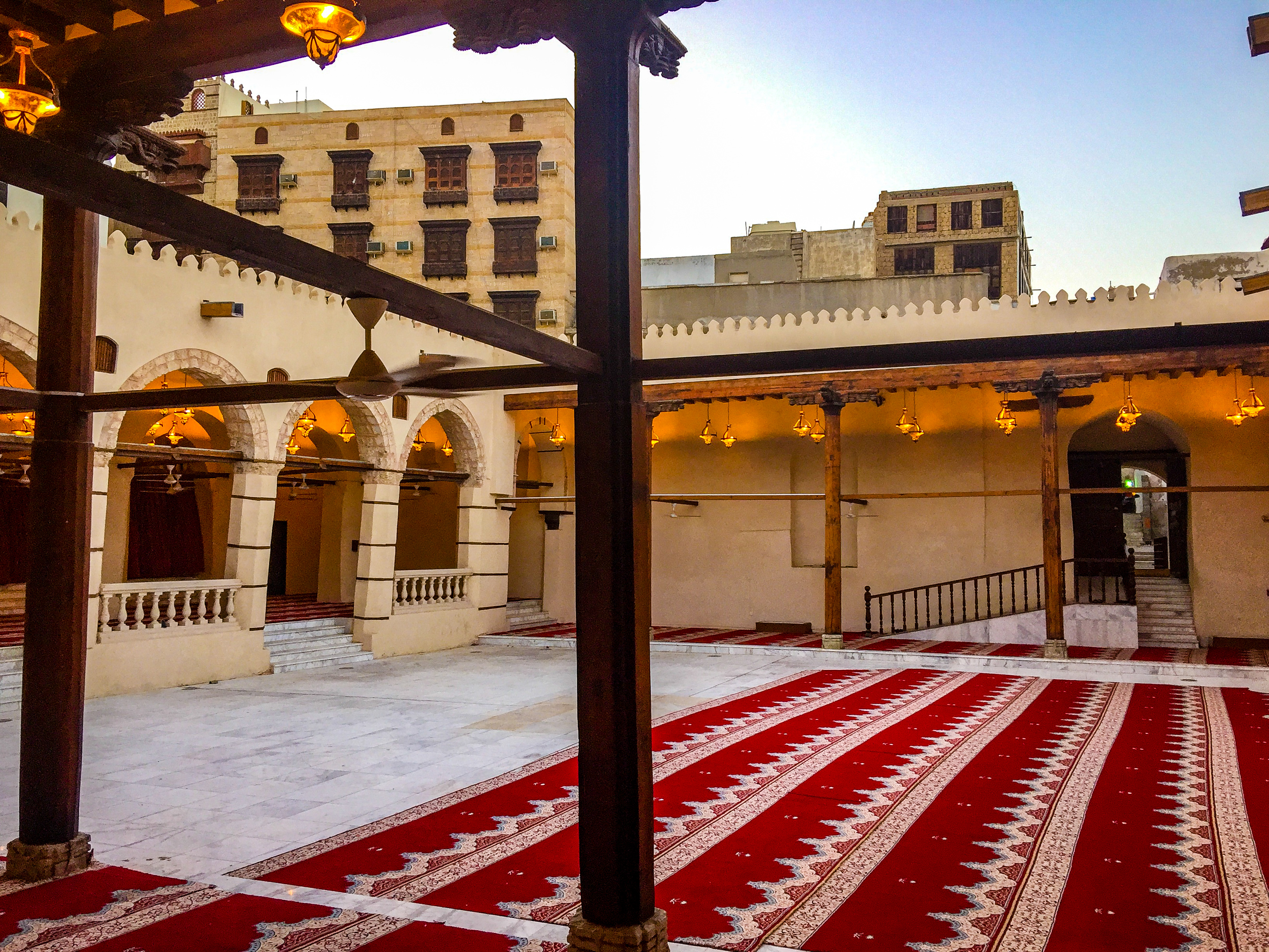
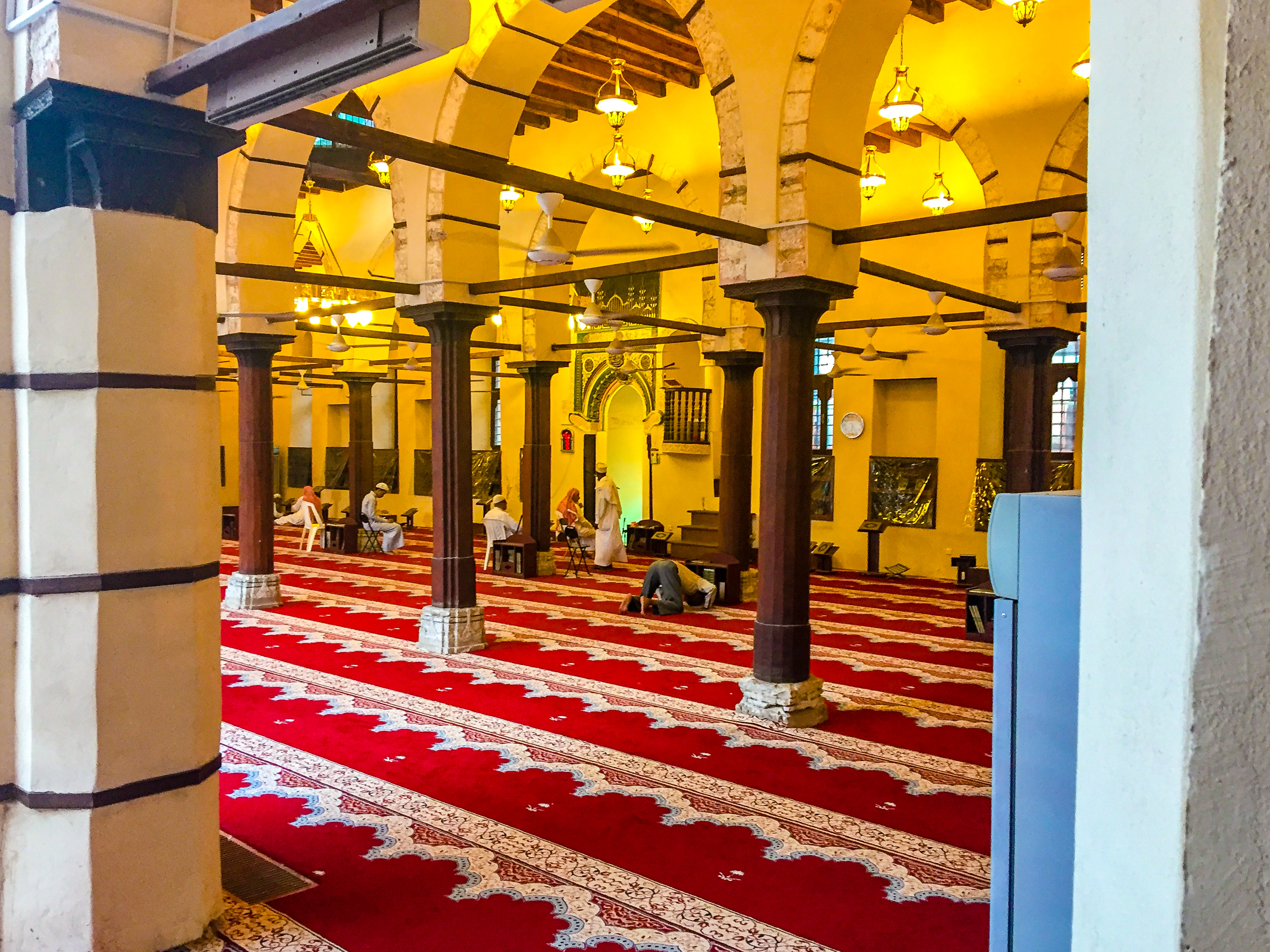
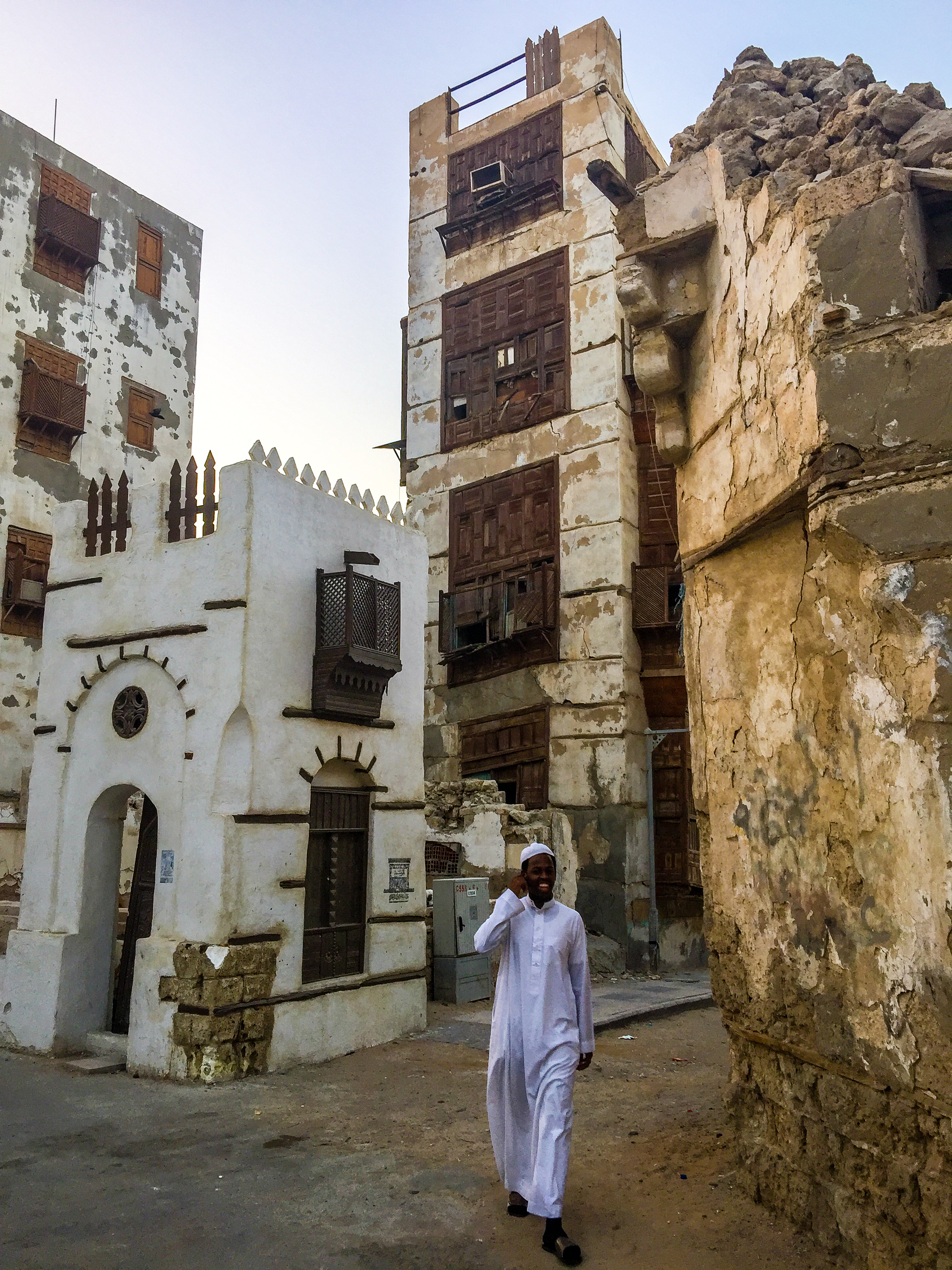
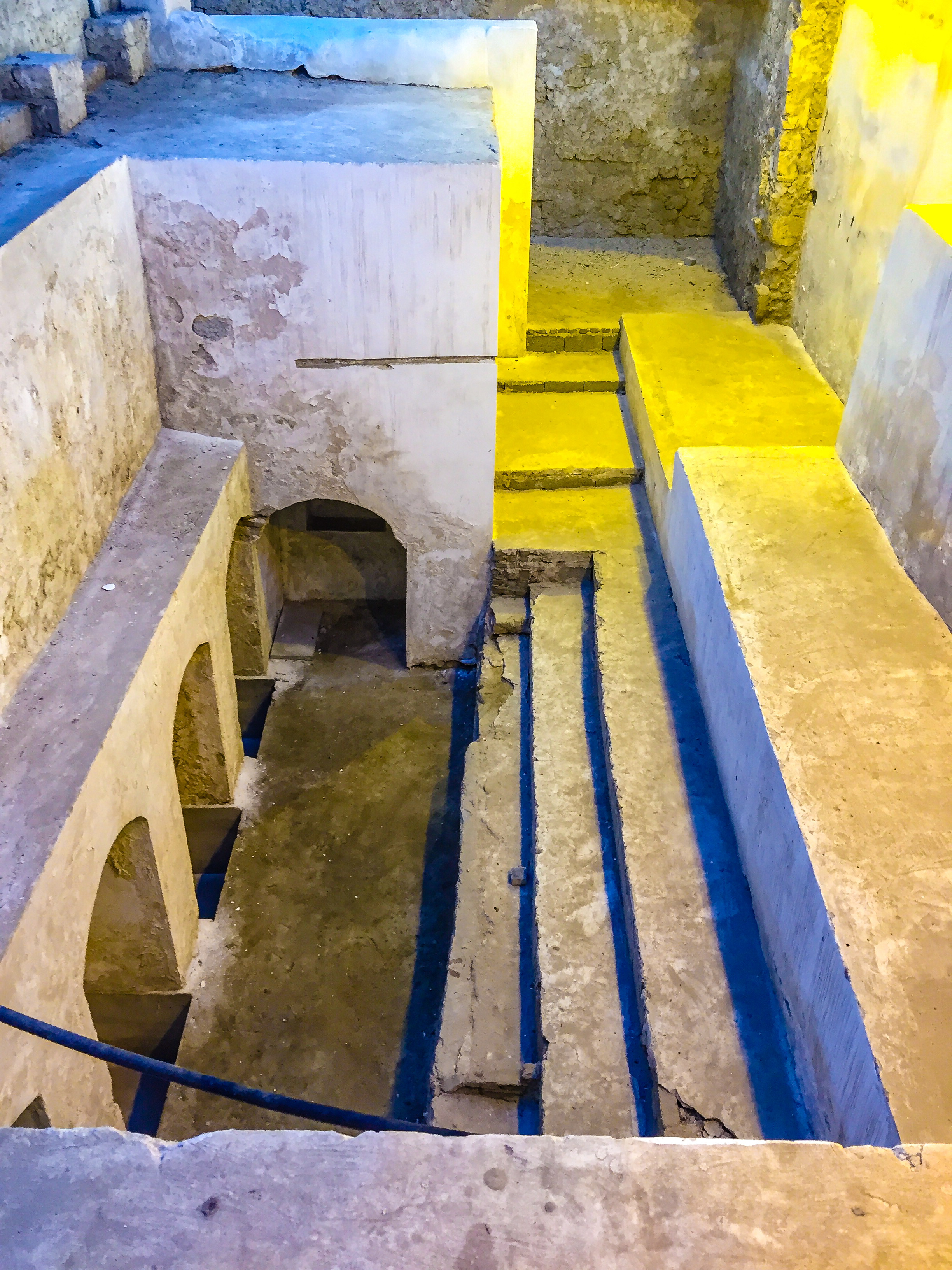
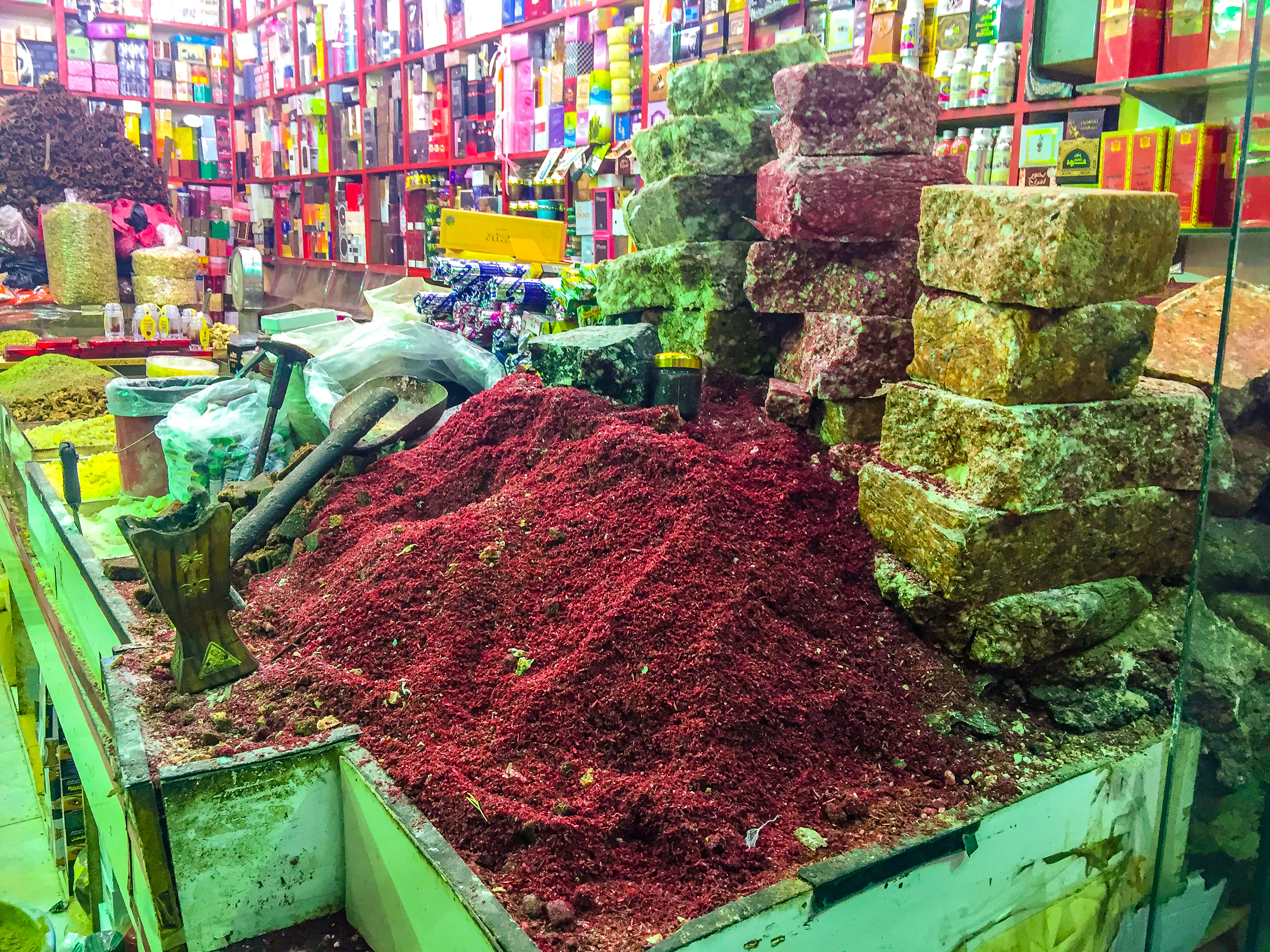
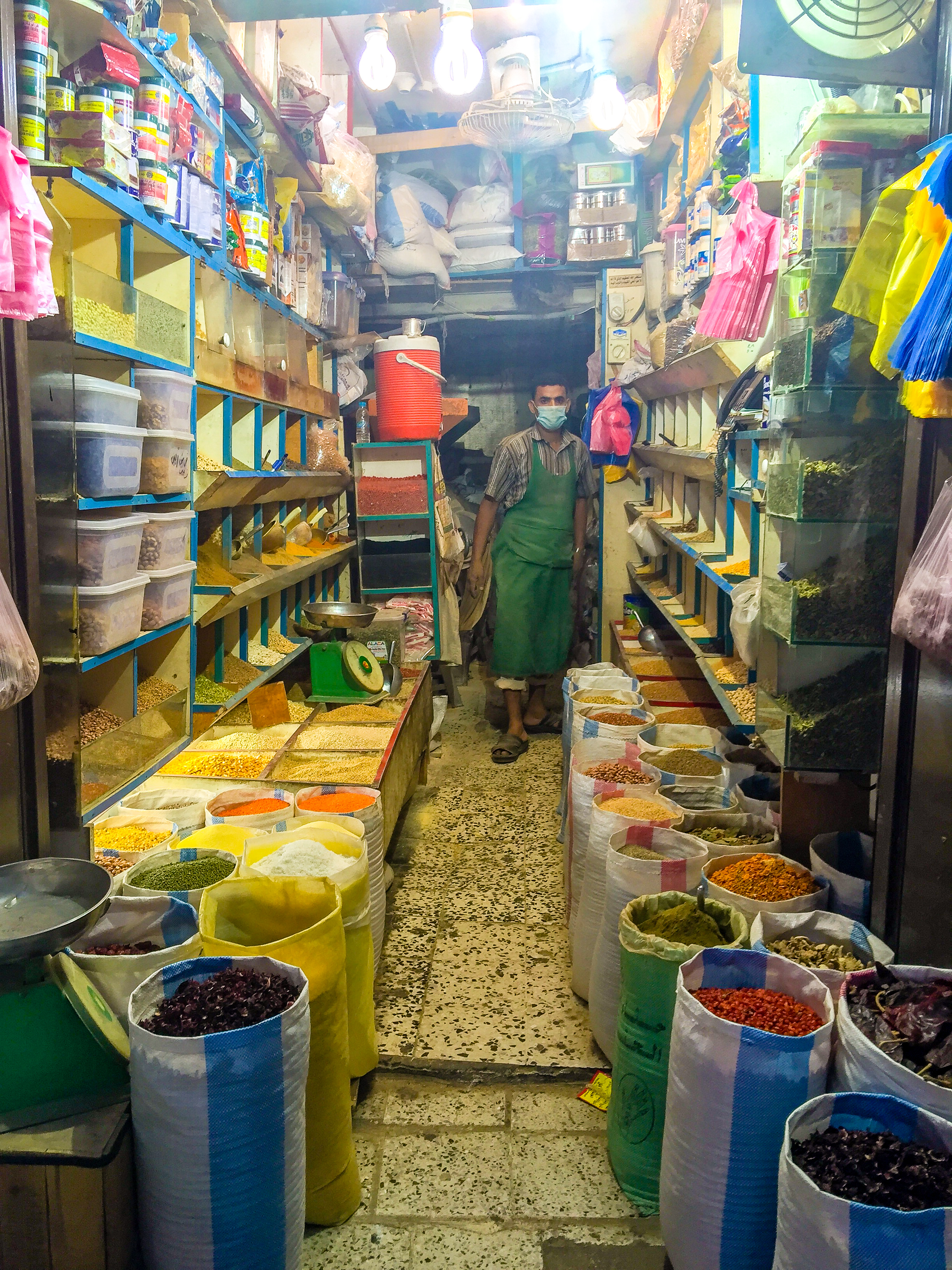
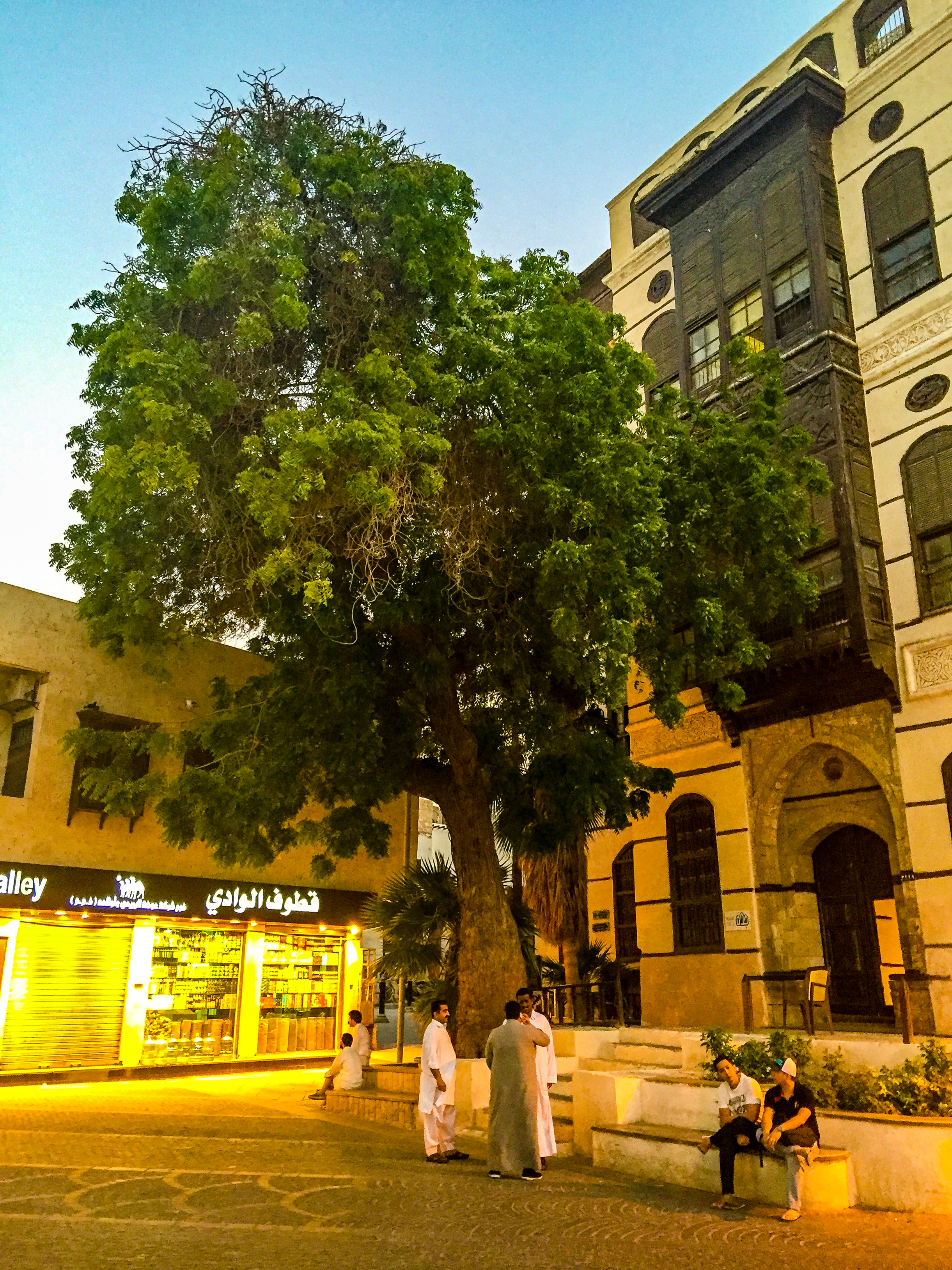
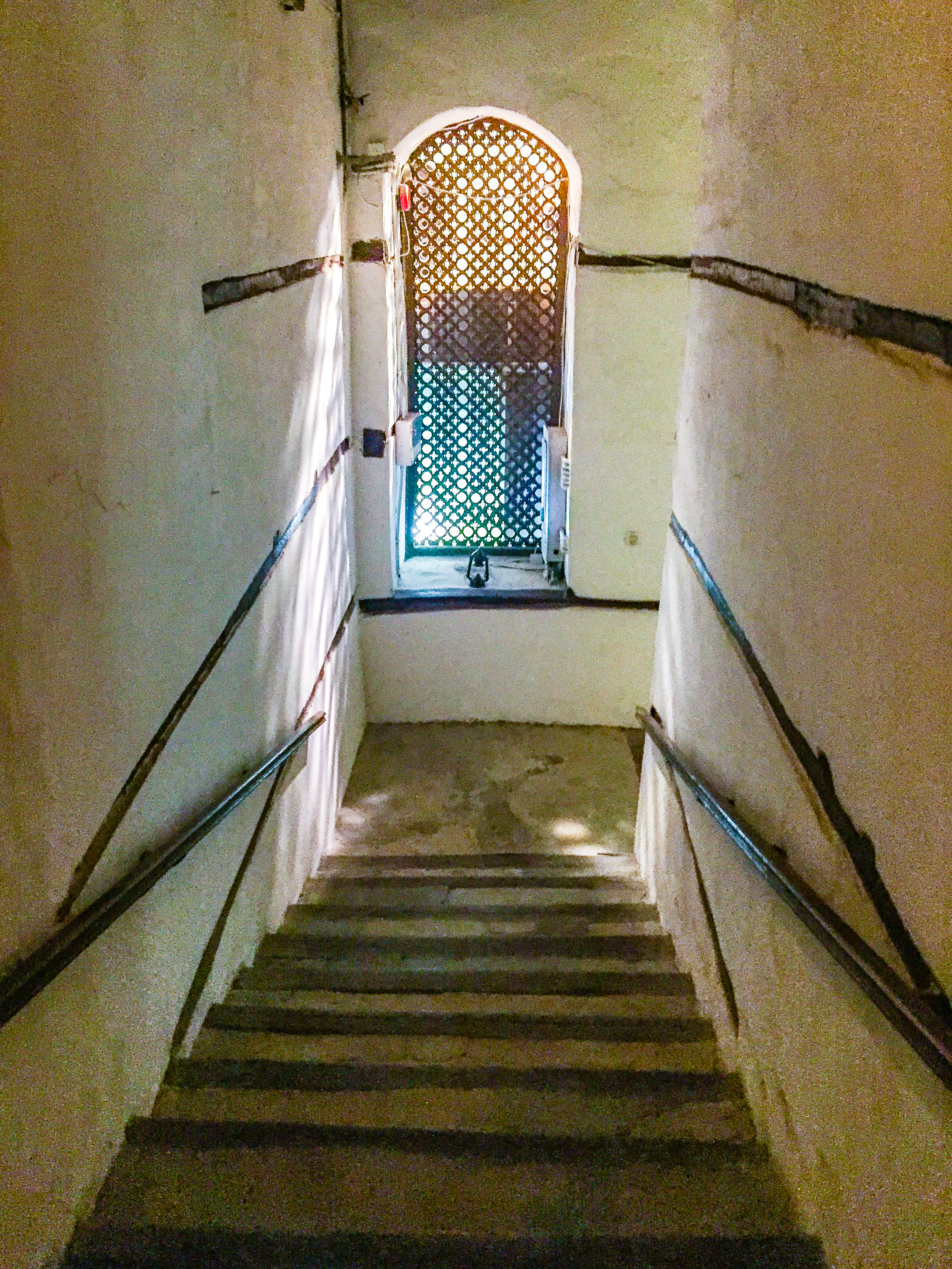

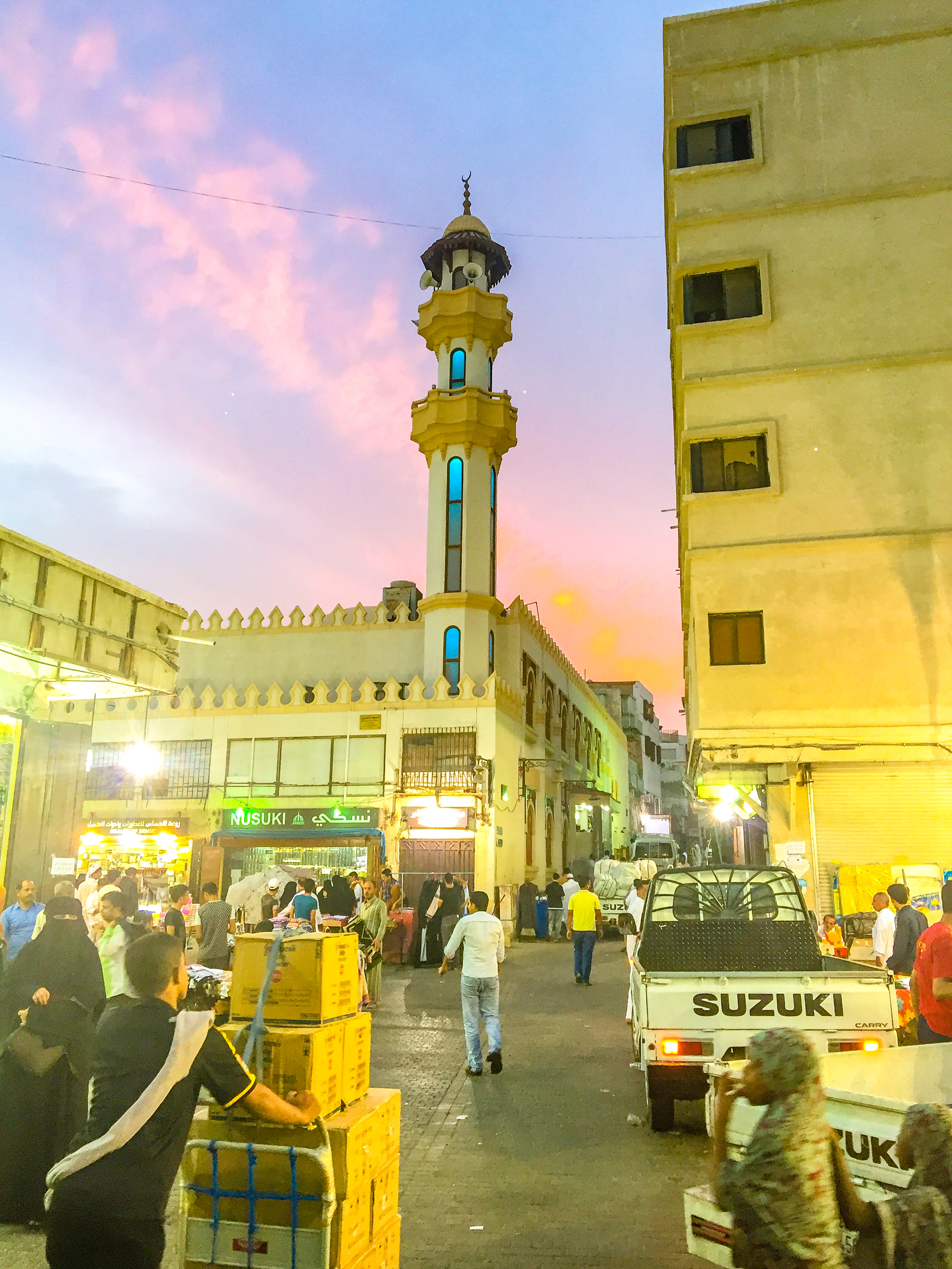
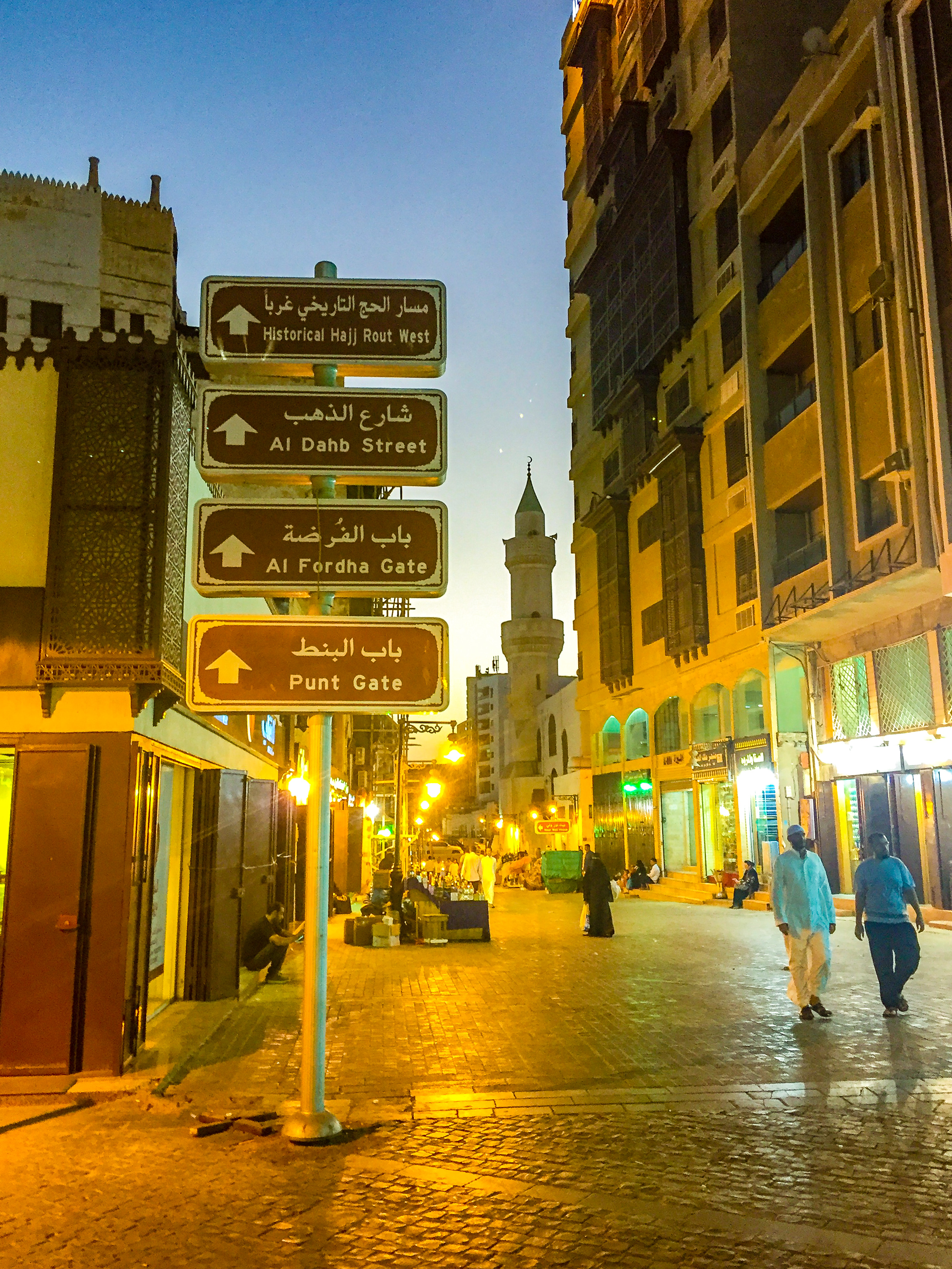

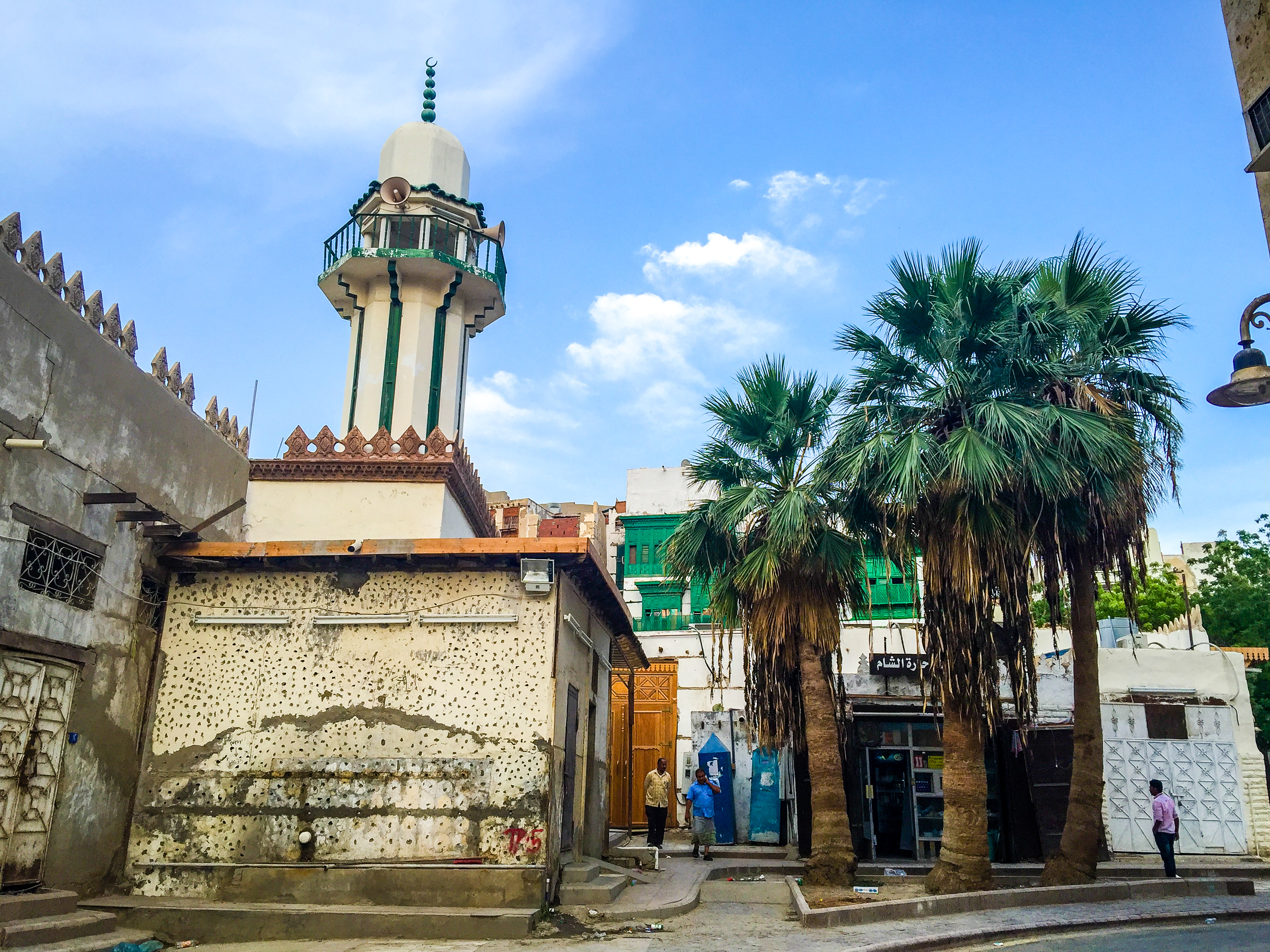
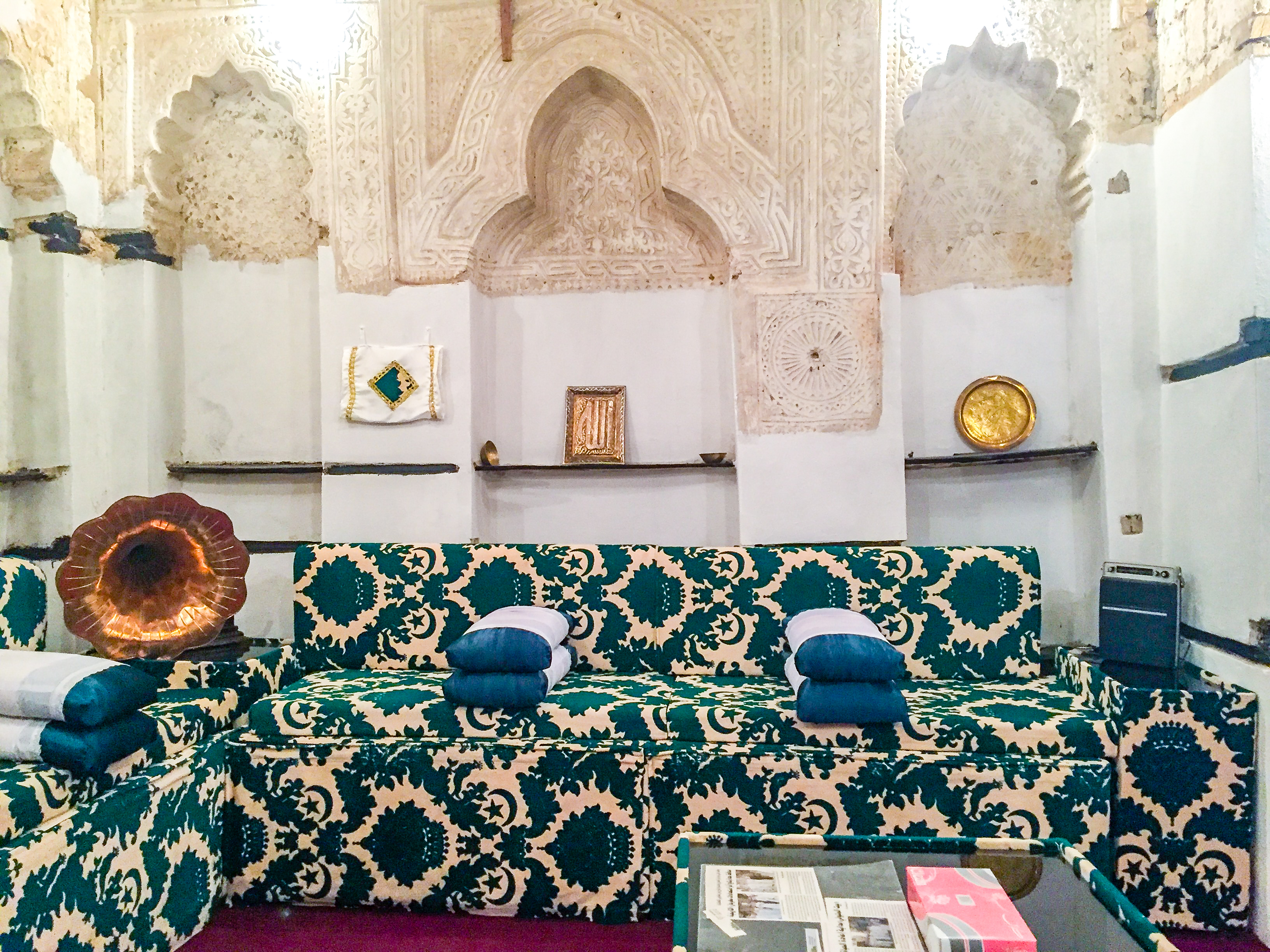
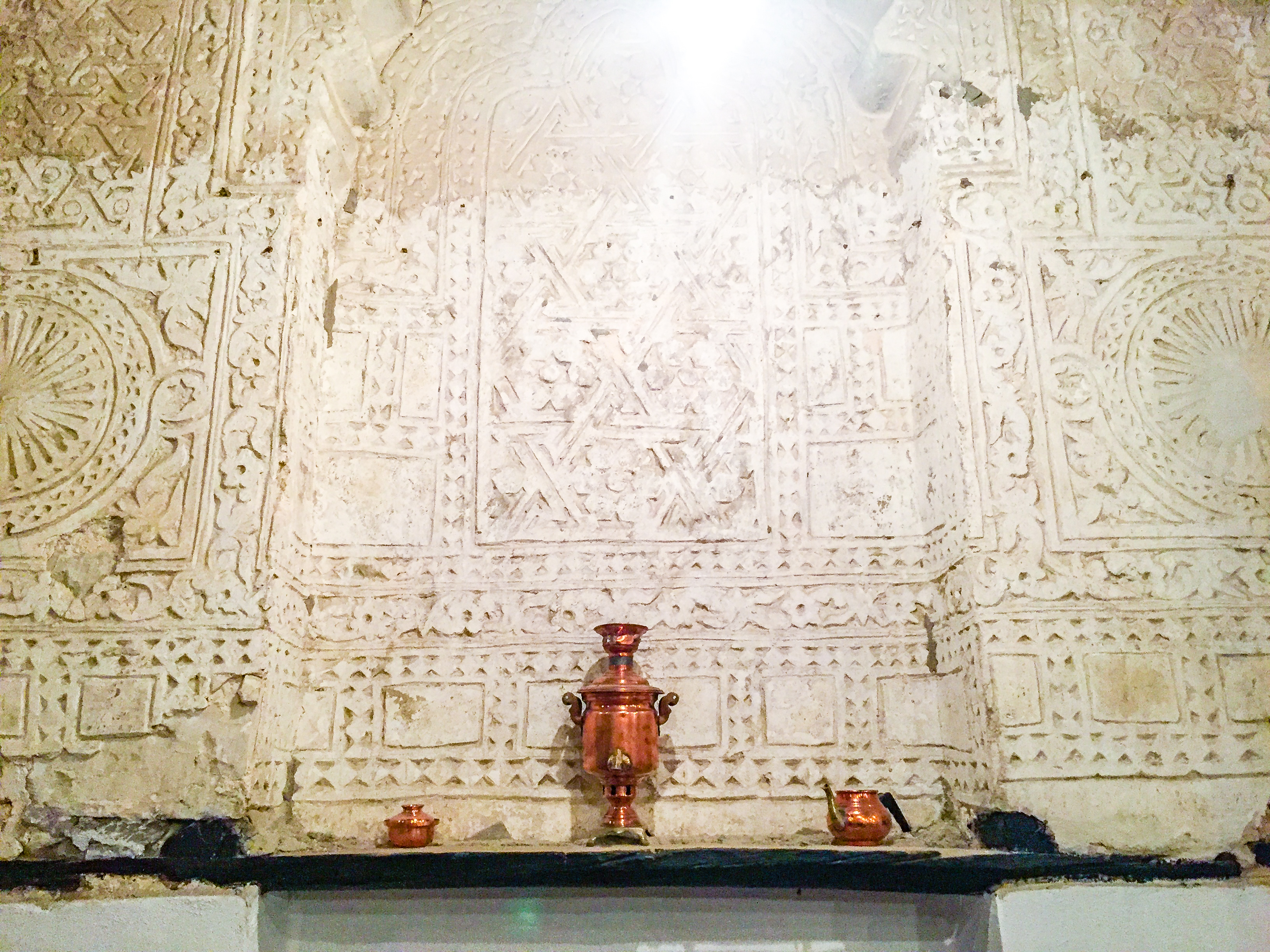
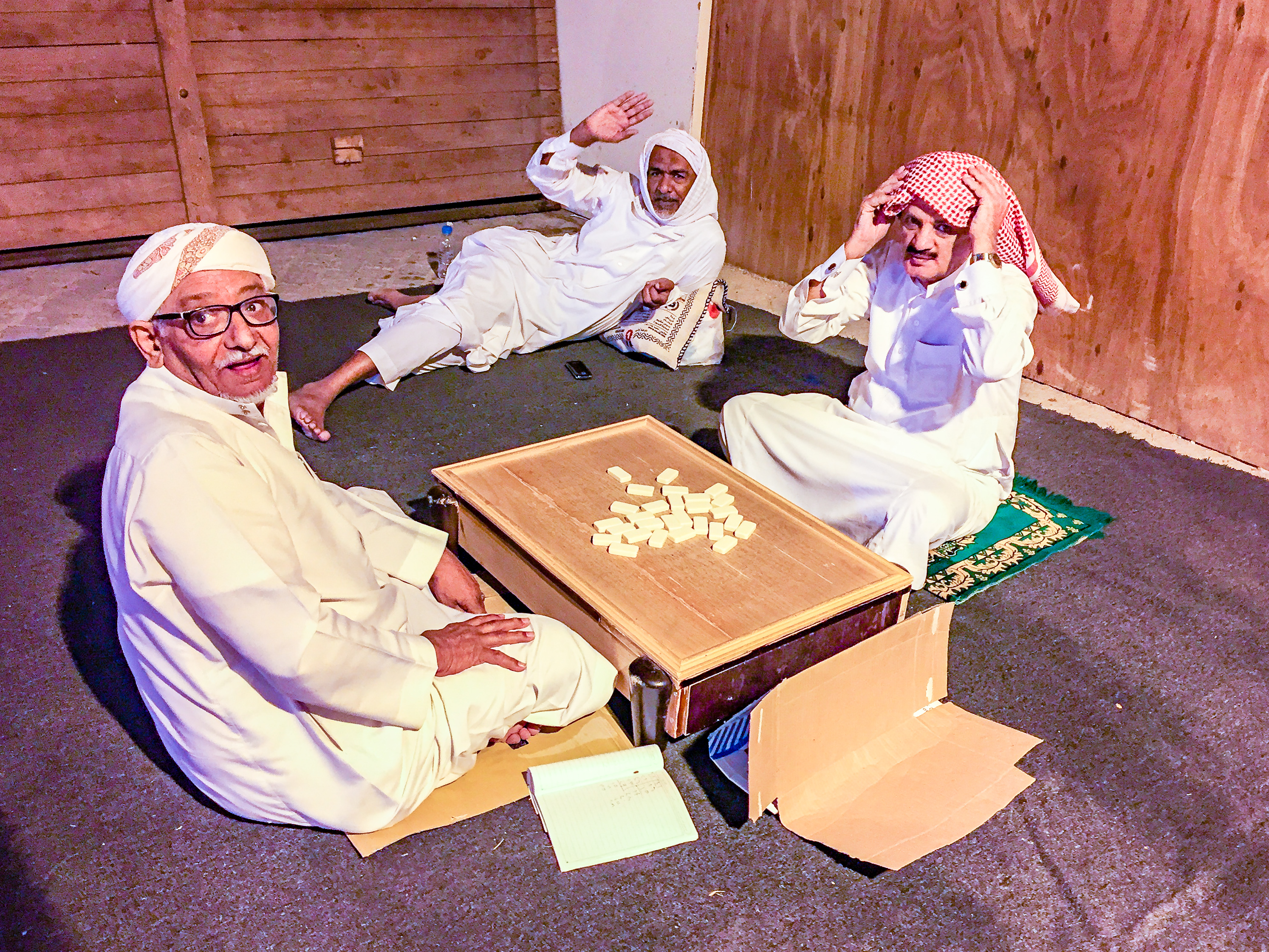
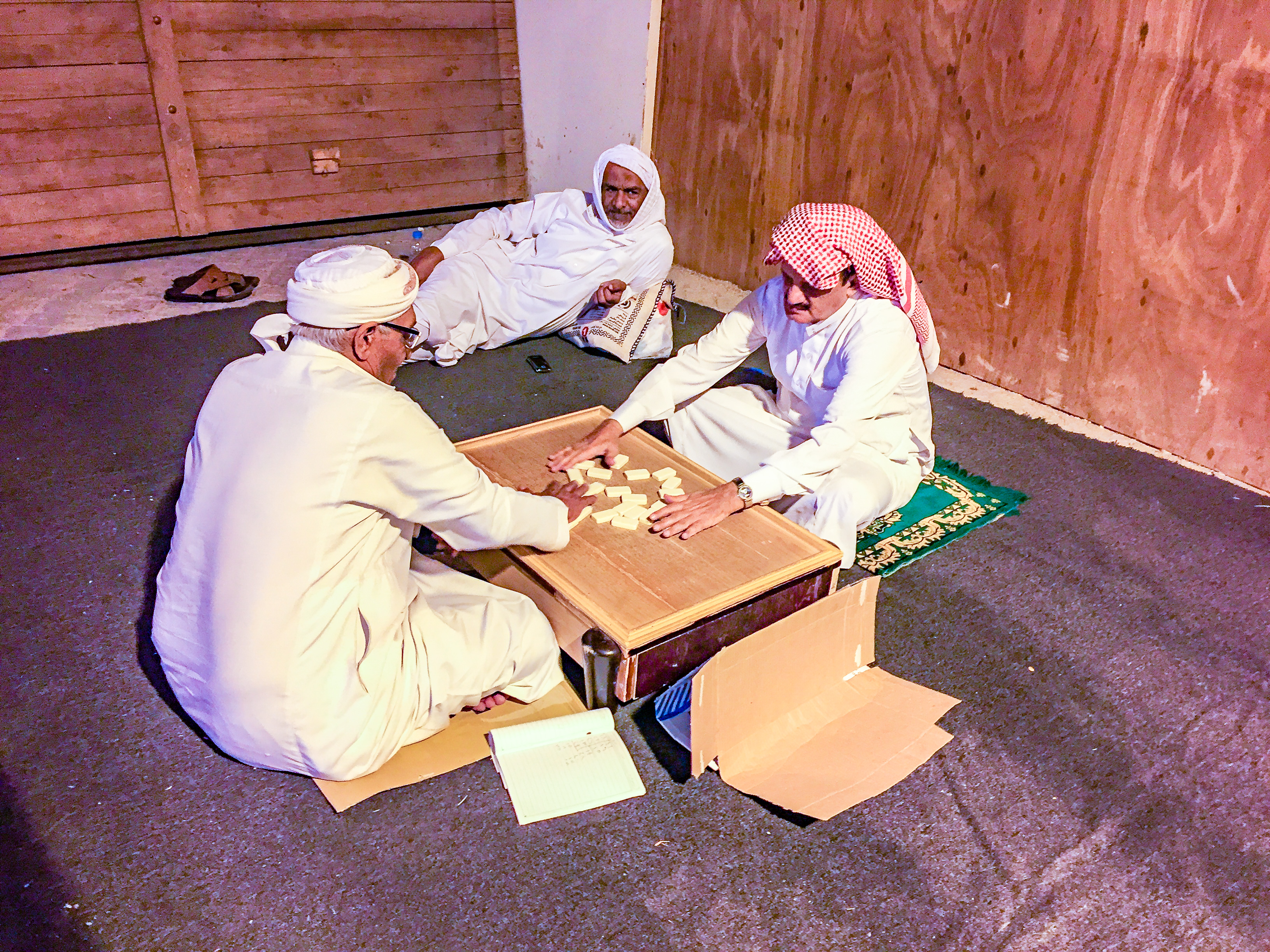
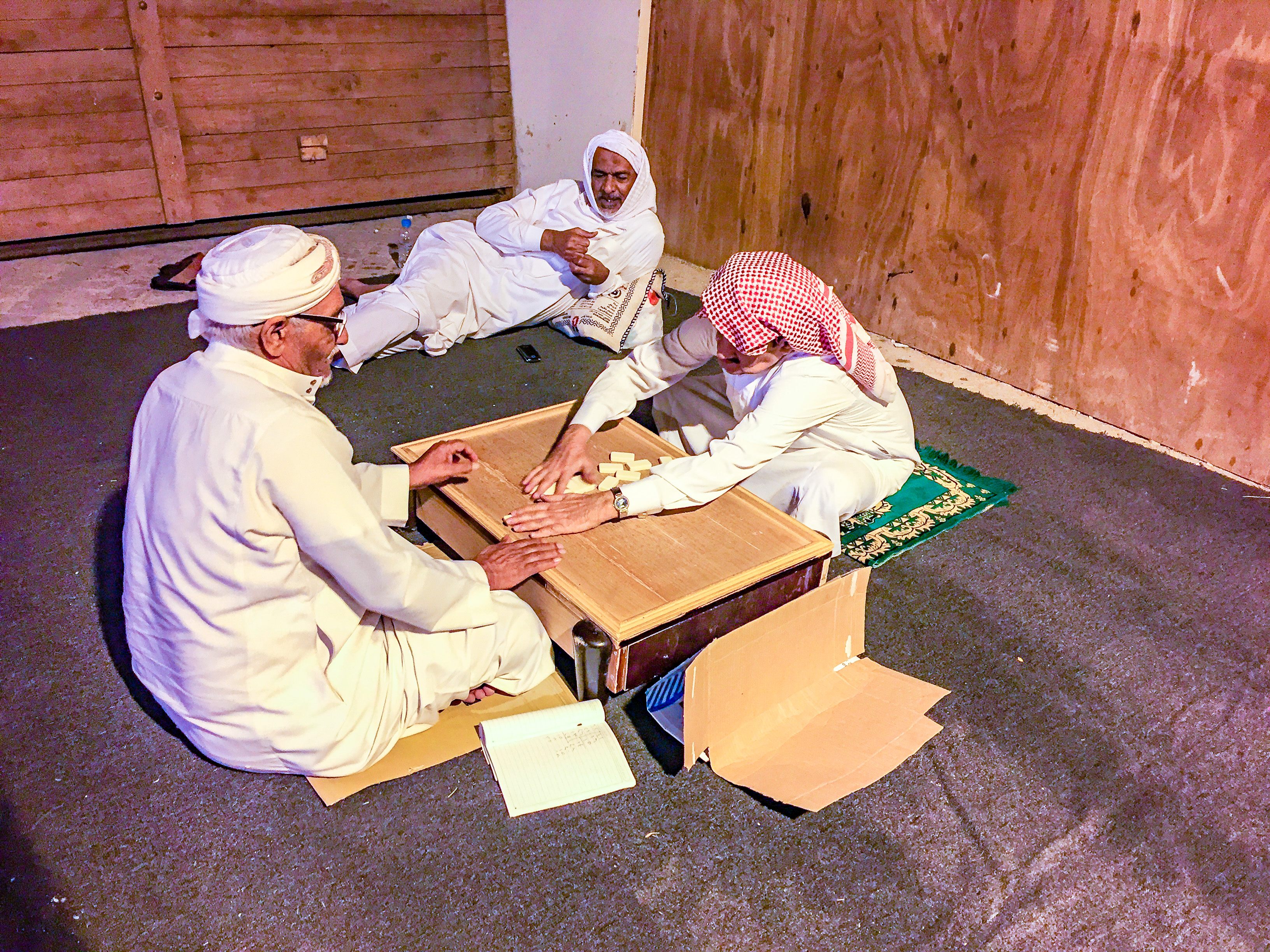
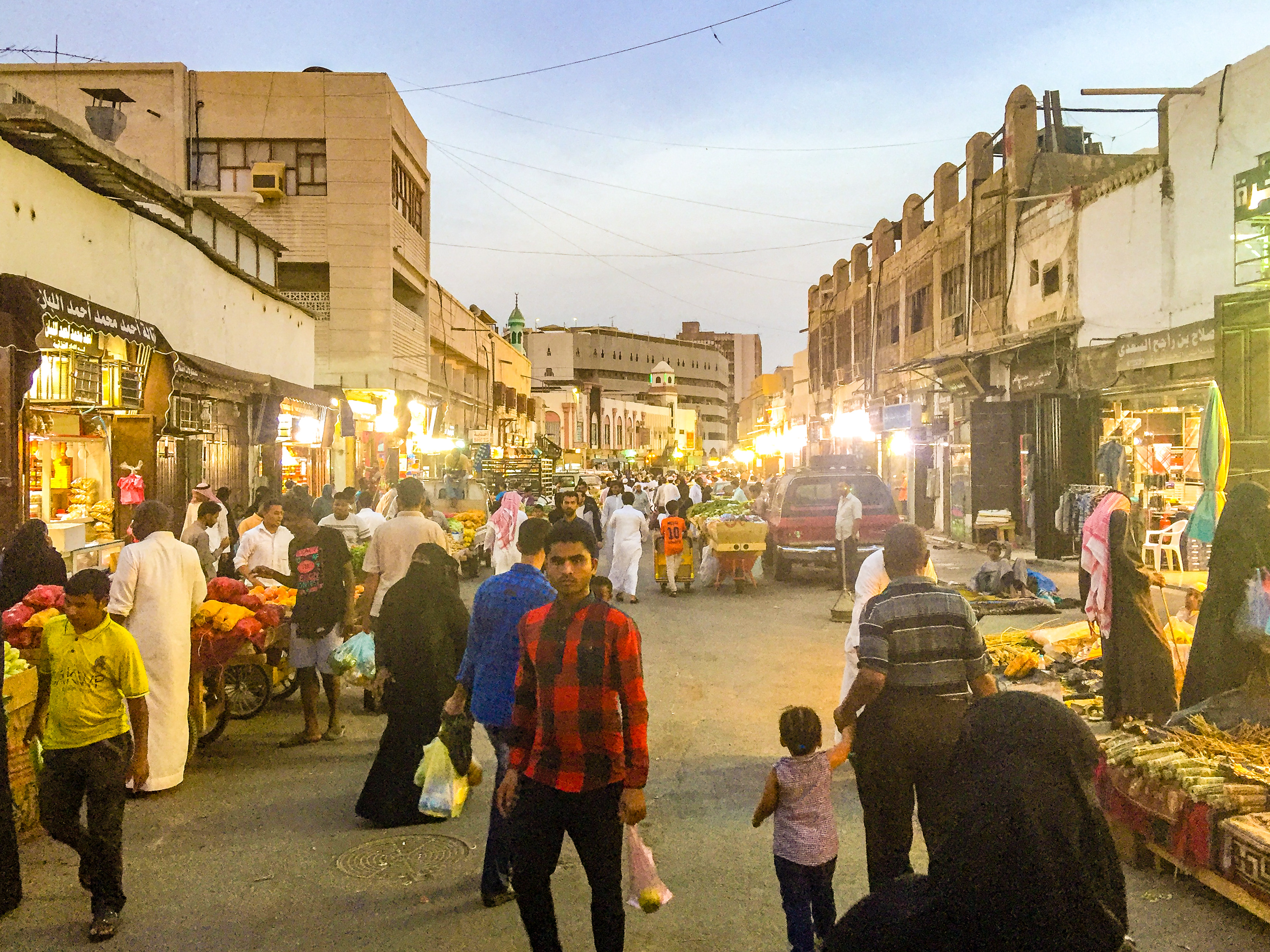
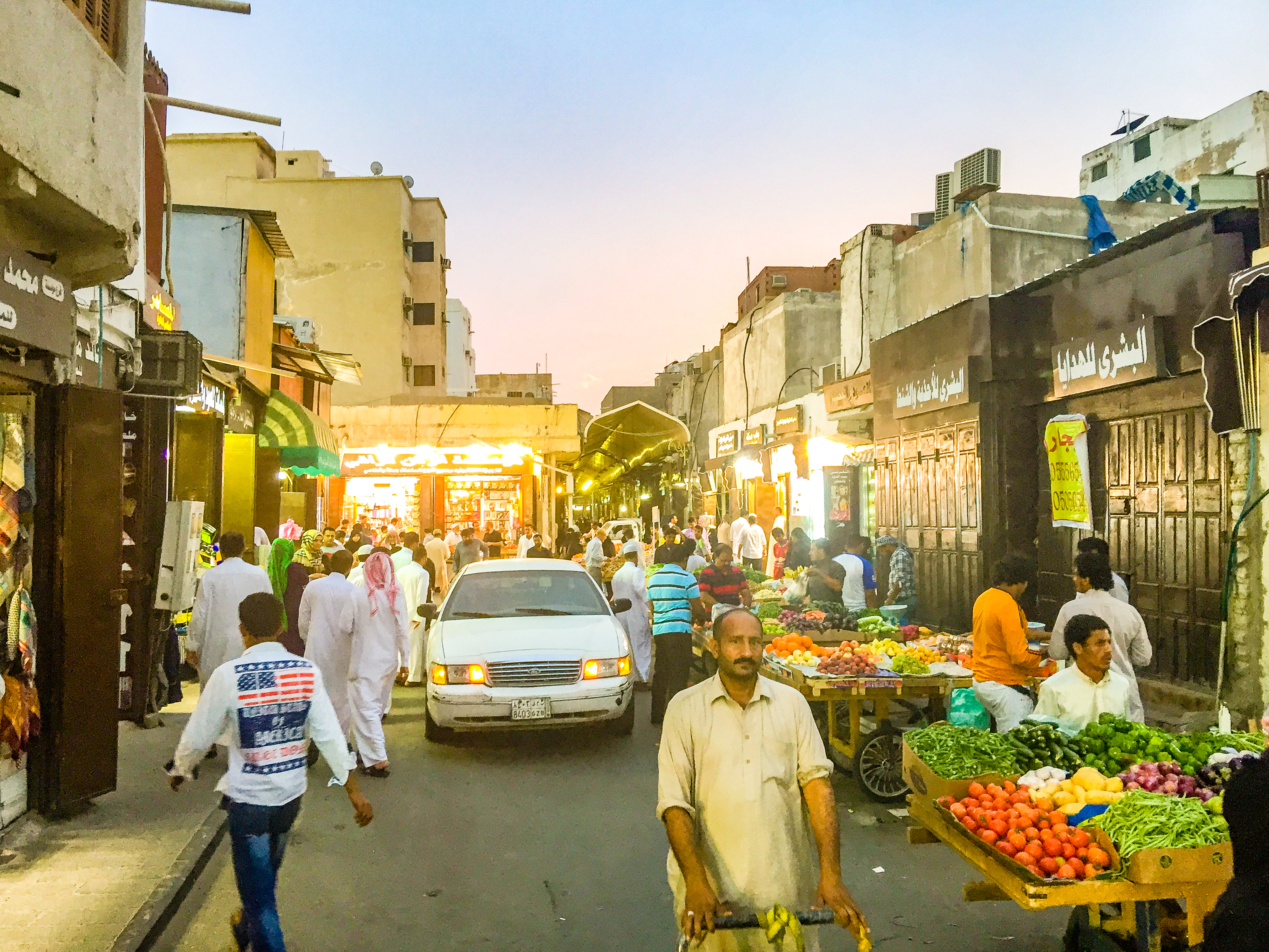
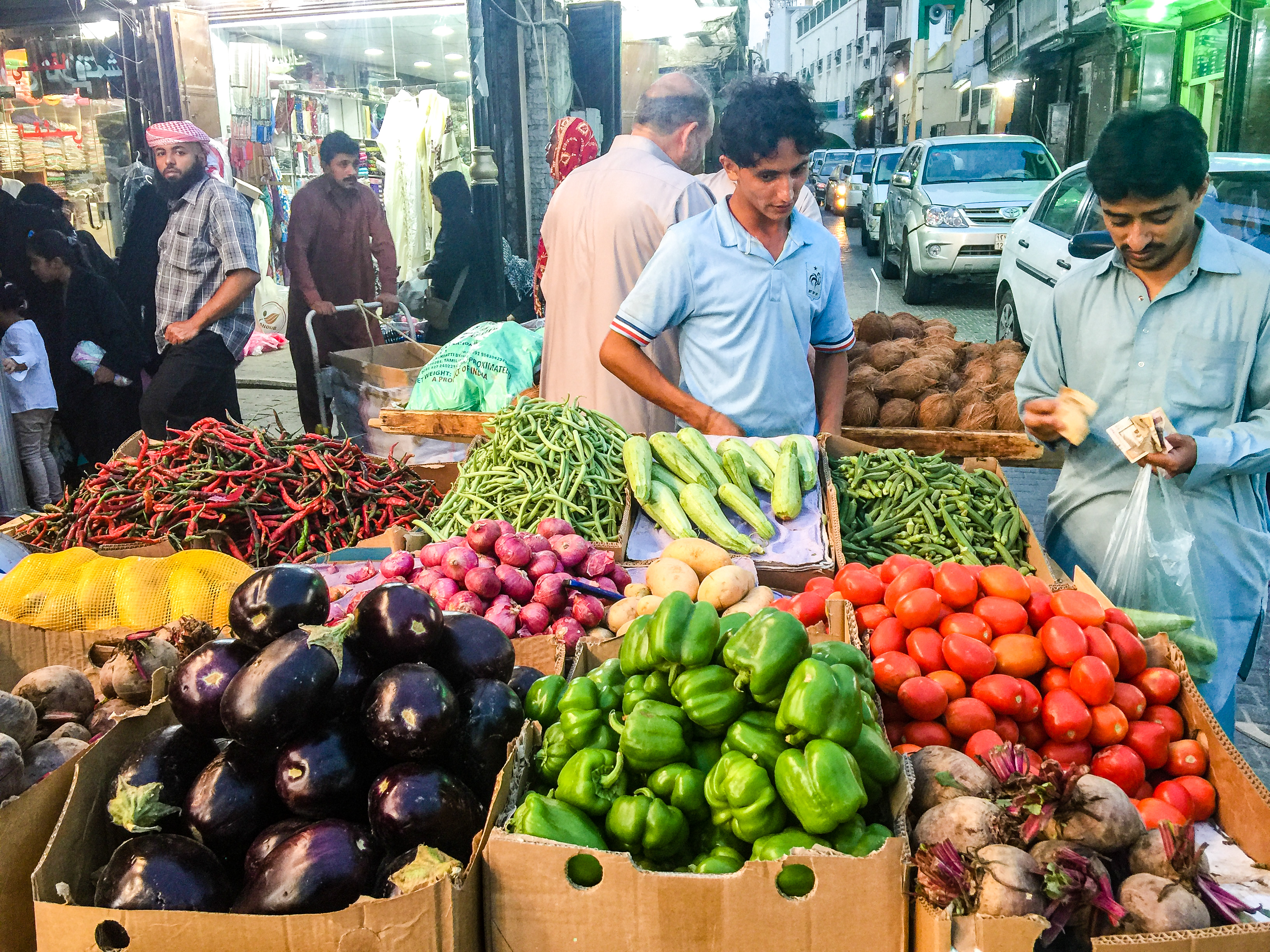
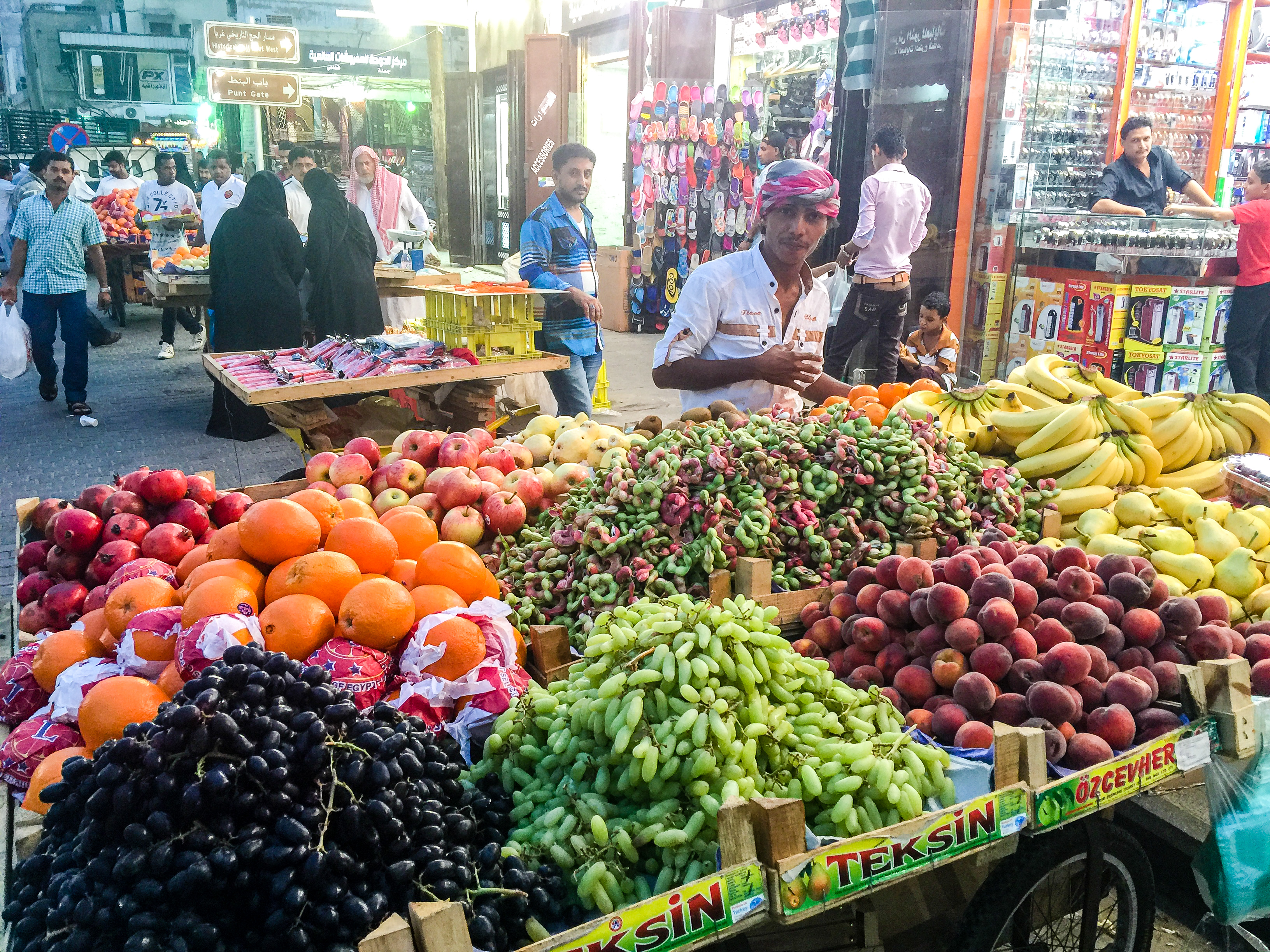
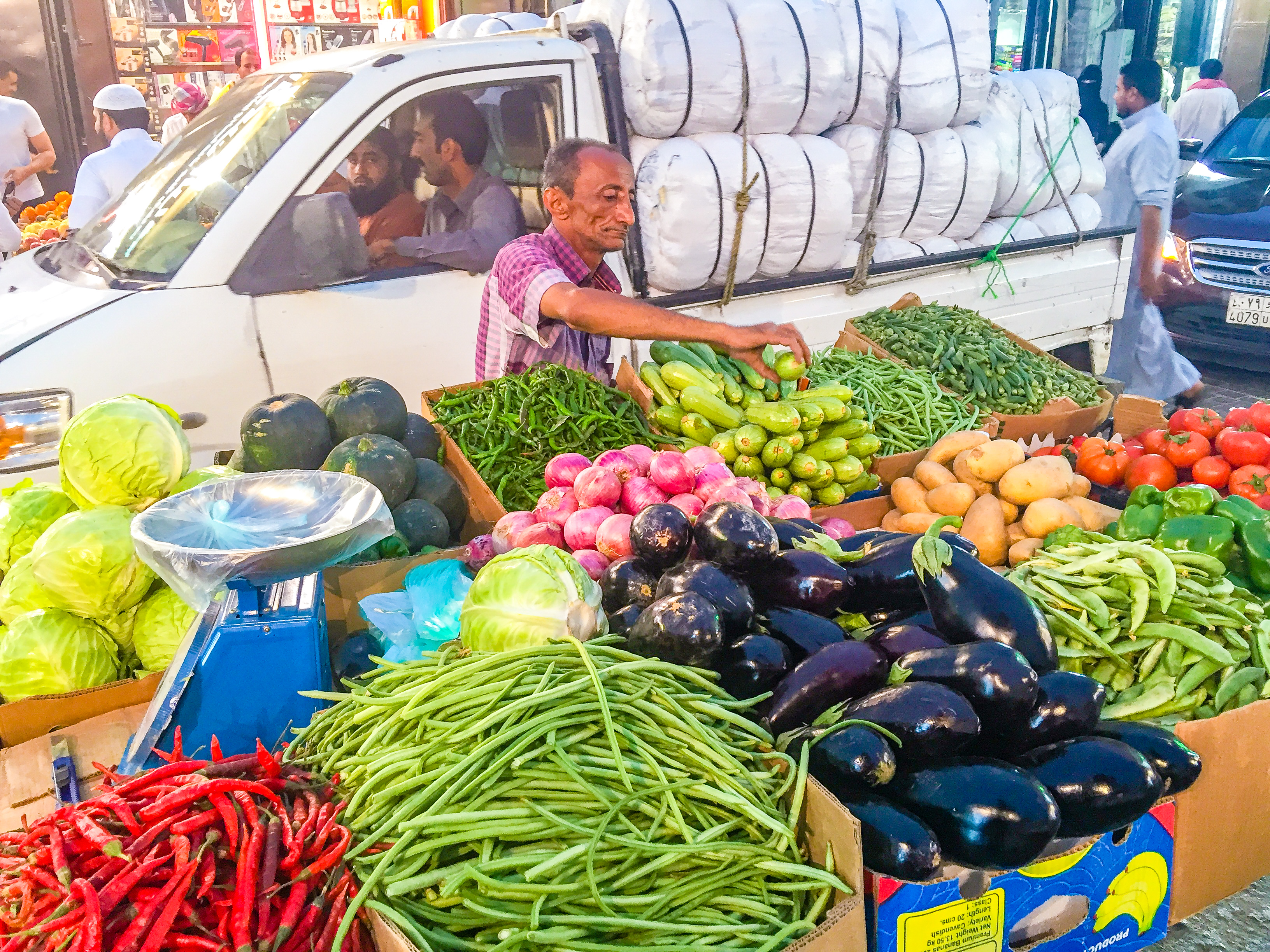
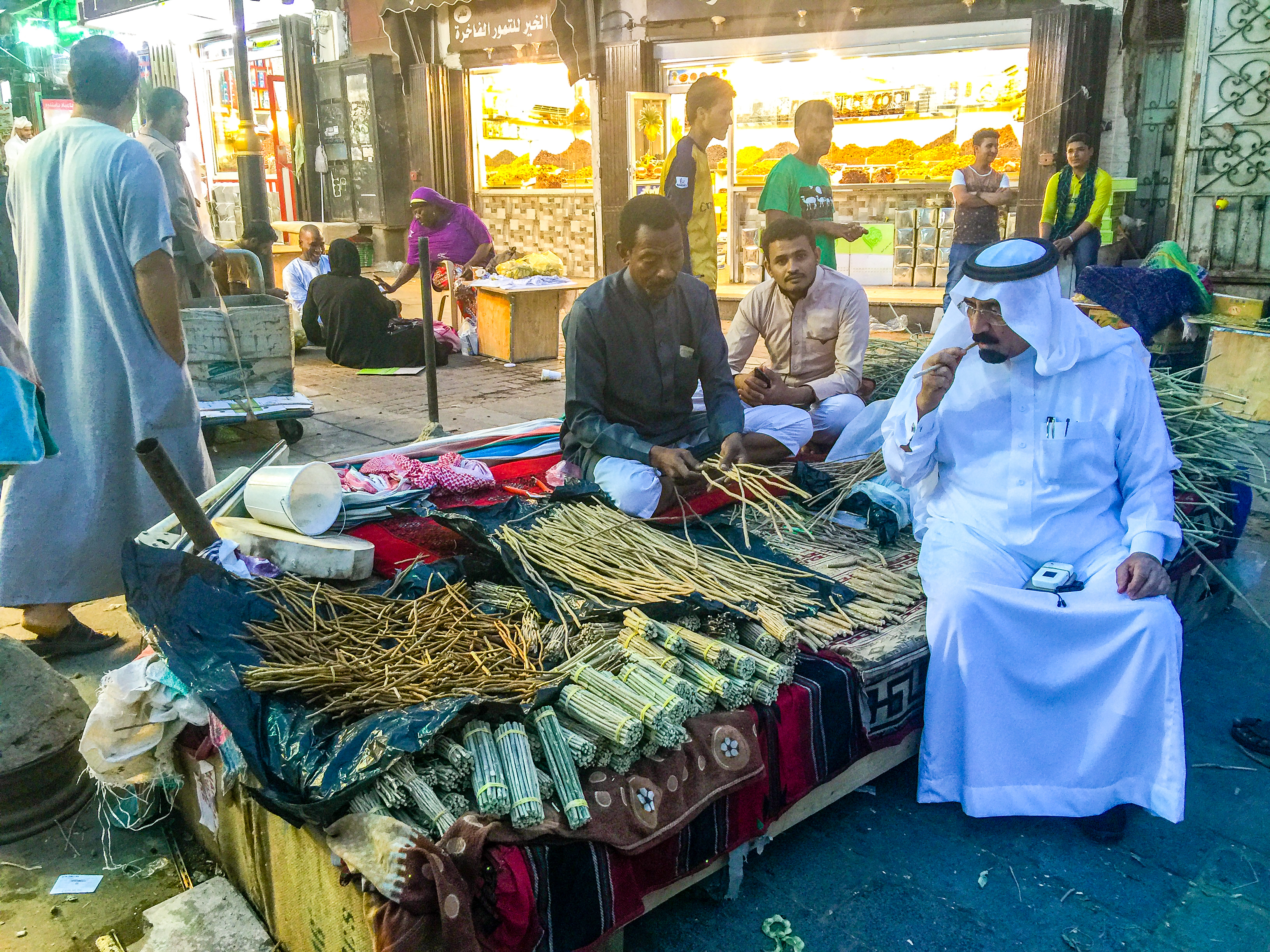
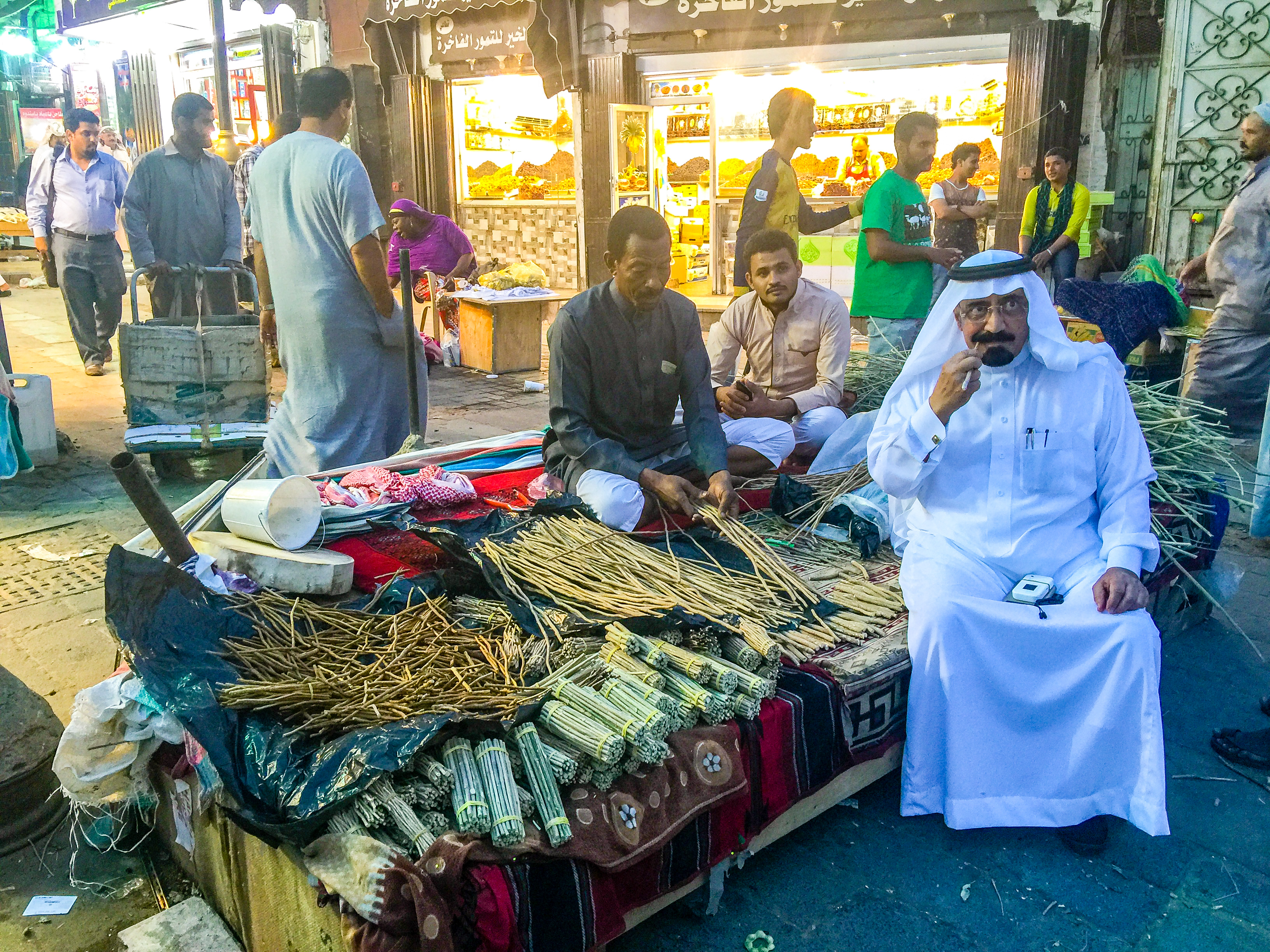
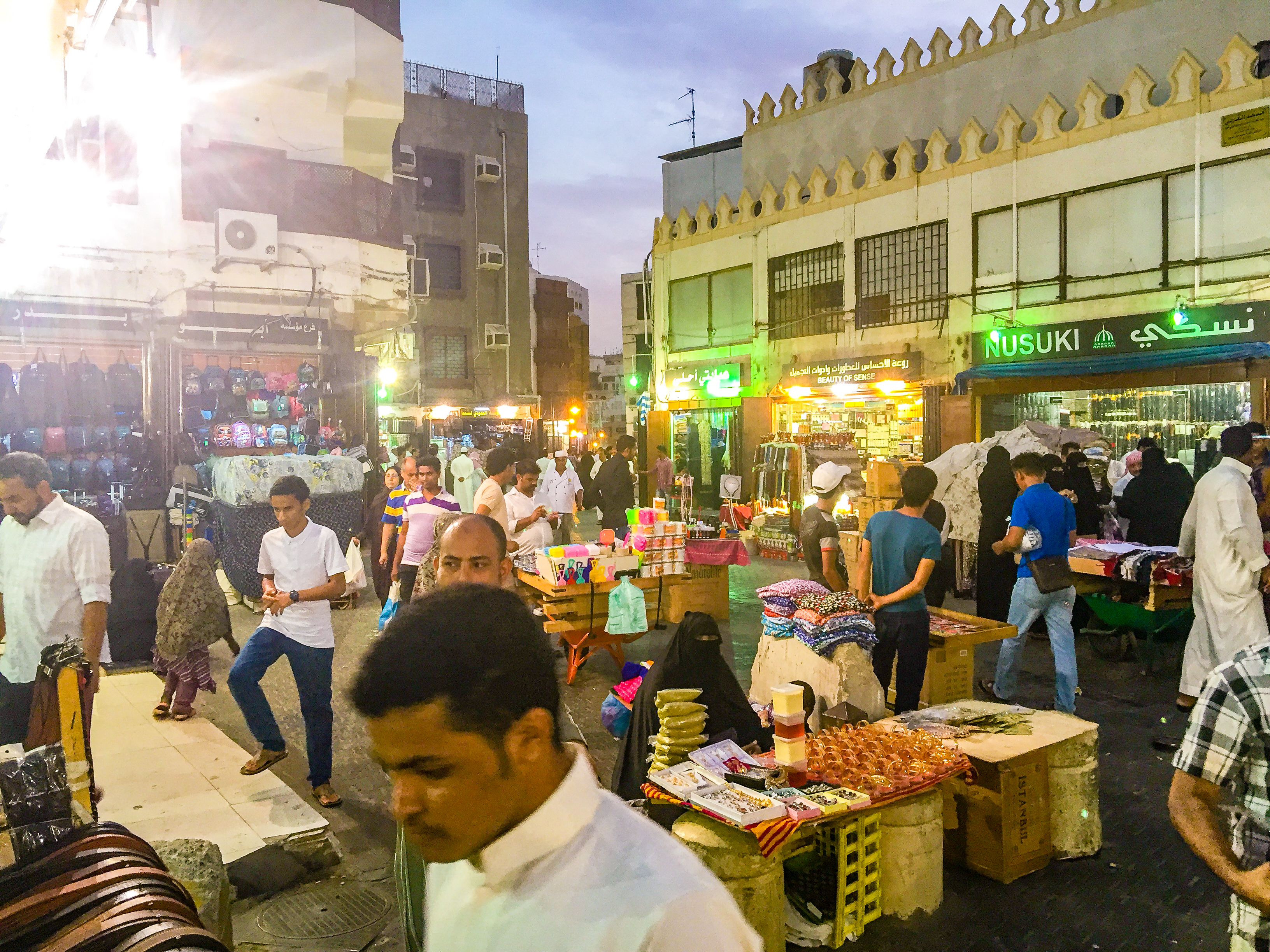
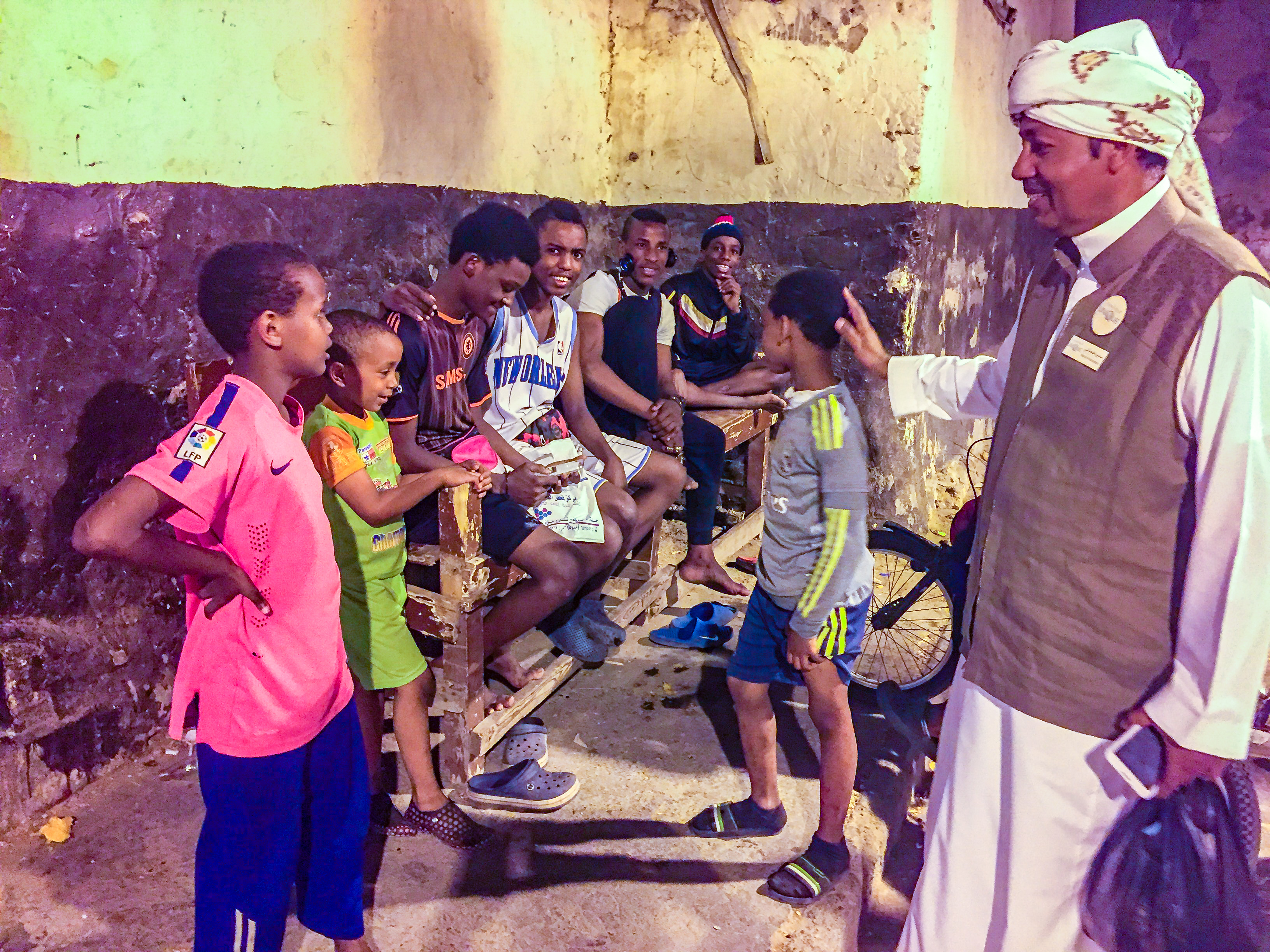
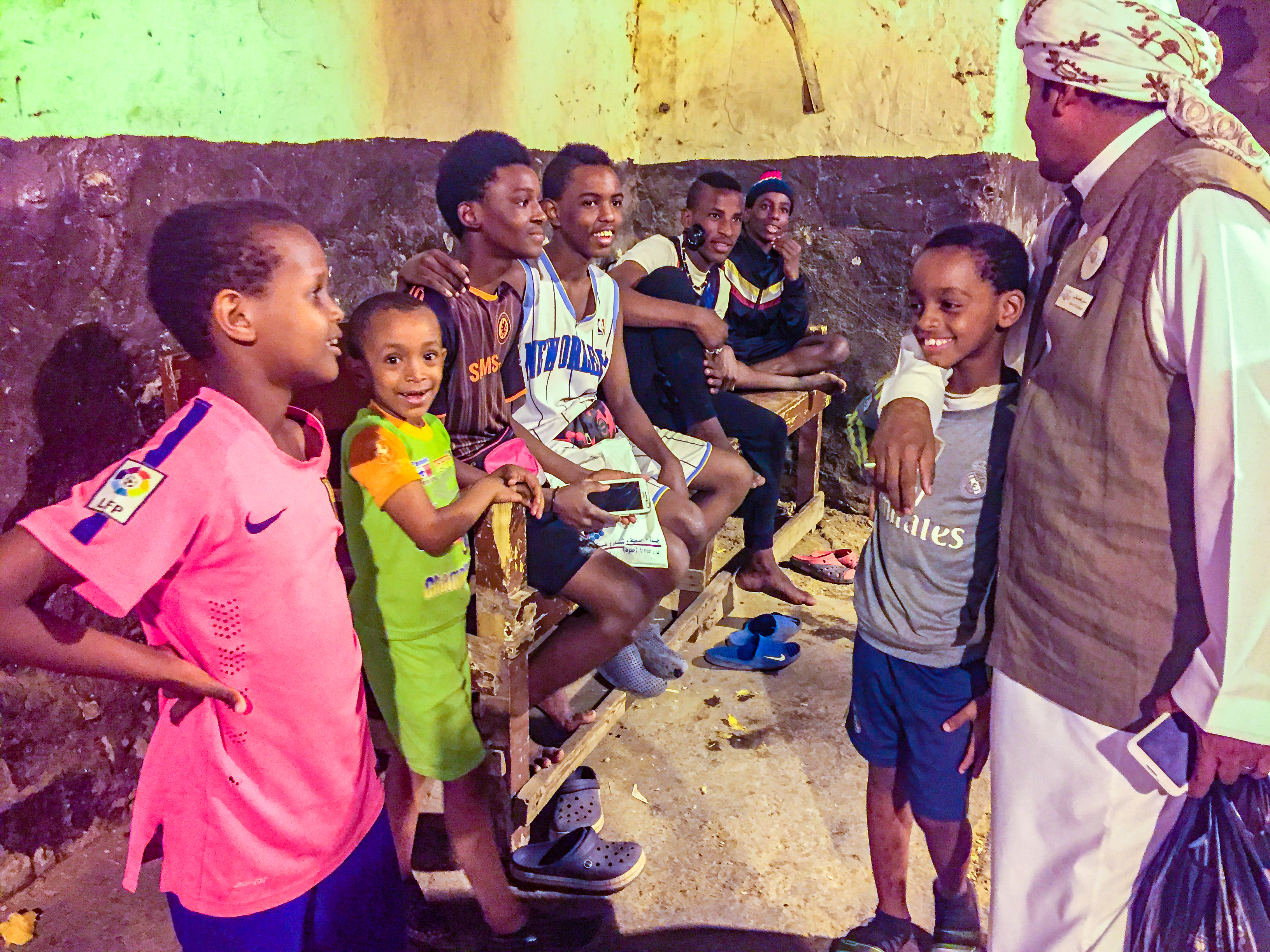
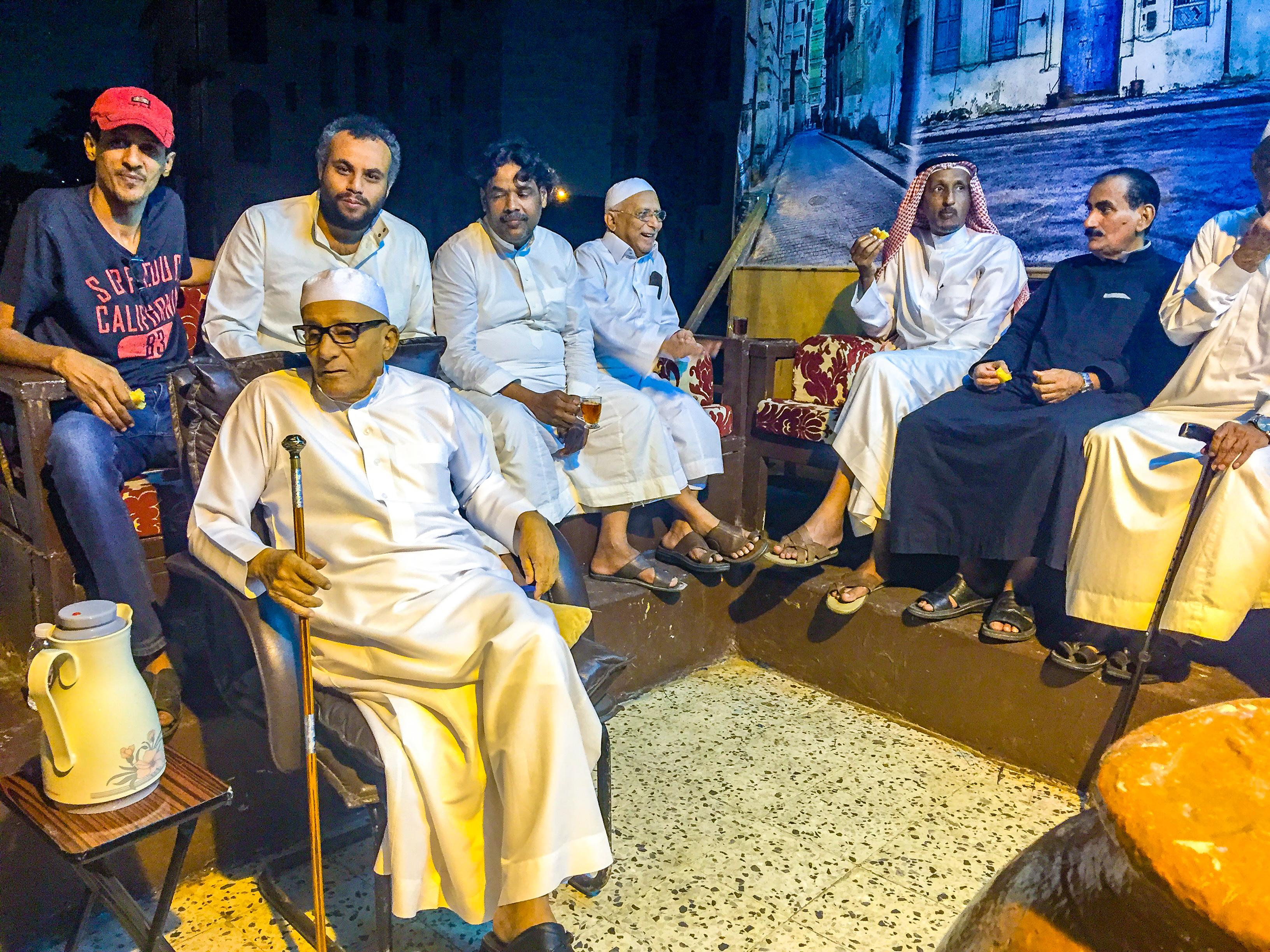
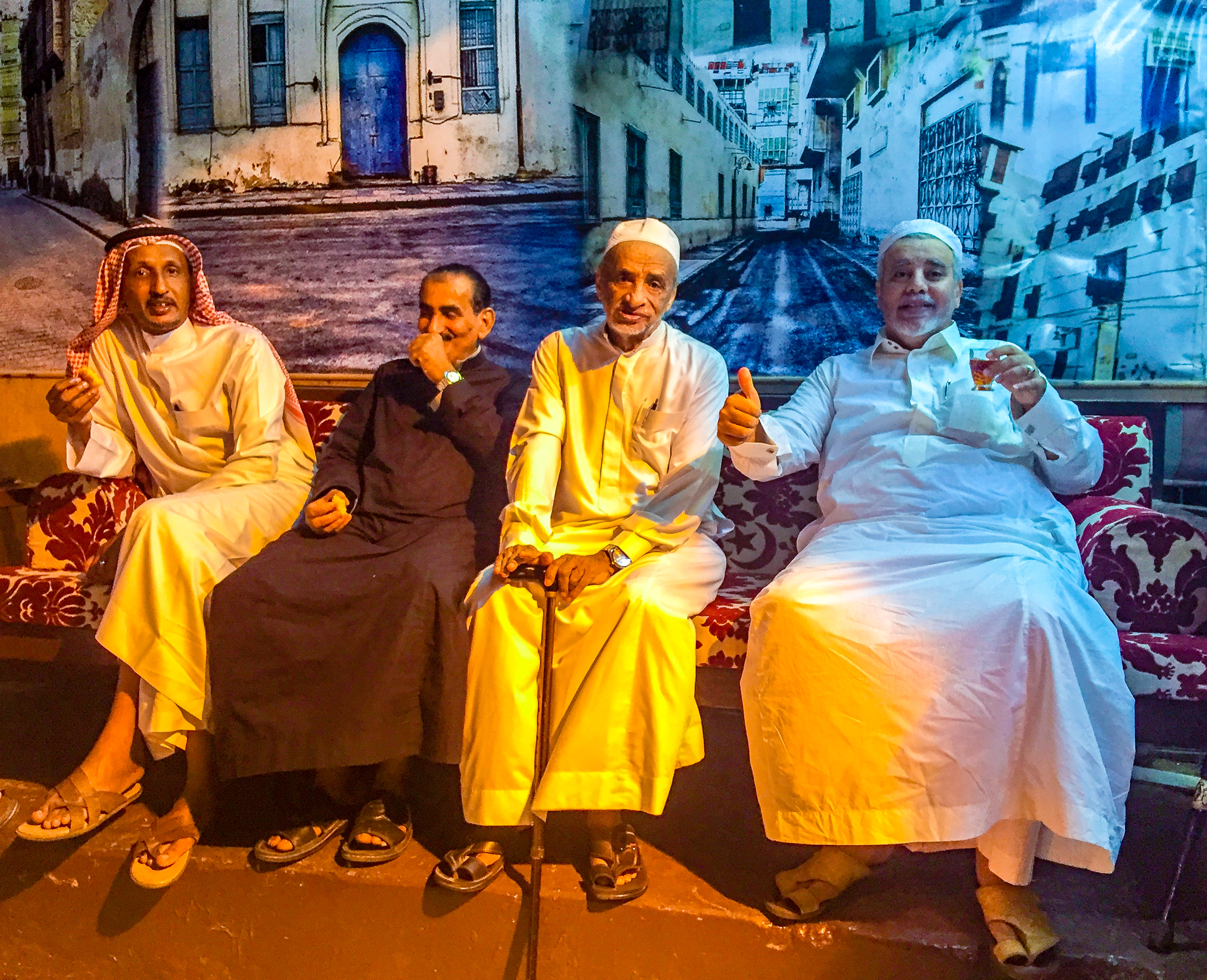
You must be logged in to post a comment.